Output Utilities and Data Visualization
Plotting
The Plotting utility provides a means for plotting the data stored in RiverWare slots. This plotting tool is very flexible and user-configurable.
Topics
• Plot Page Editor. Edit and configure the layout, appearance, and data shown.
• Configuring Multiple Plots and Curves. Edit the appearance of multiple plots or curves in one location.
• Plot Page. View previously configured Plot Pages.
• Plot Page Navigation. Zoom and scroll a plot.
• Plotting Templates. Create and apply templates to make new plots.
• Creating Similar Plot Pages. Create one or more plots that are similar to the current plot.
• Printing and Exporting Plots. Print or export plot images and configurations.
Plotting Components
The basic components of a plot are as follows. Figure 2.1 is an illustration.
Figure 2.1 Basic components of a Plot Page.
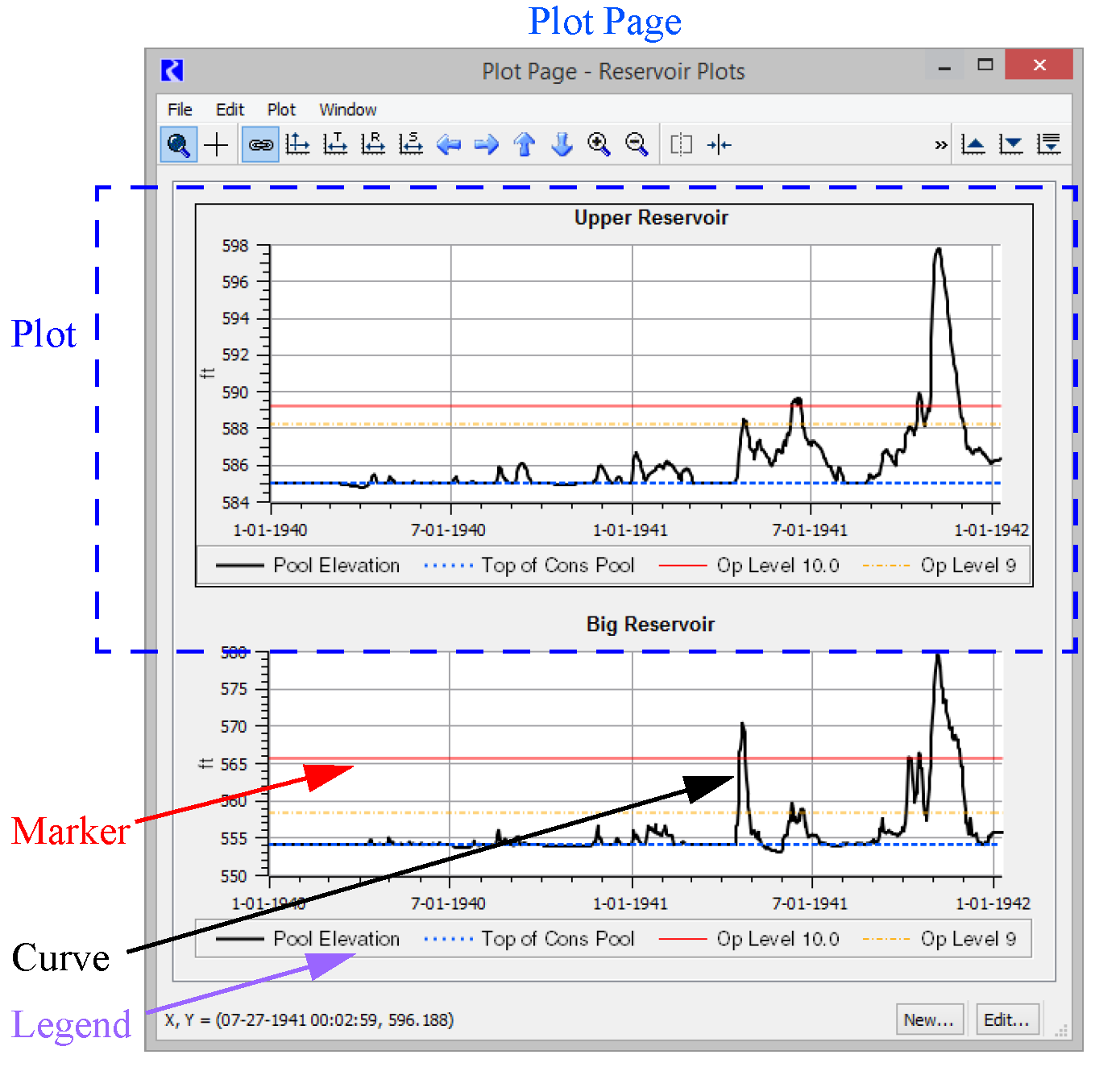
Plot Page
A Plot Page is a grid of one or more Plots. This can be configured to have multiple layouts from a 1X1, 2X1, 3X3 plots.
Plot
The a Plot consists of a set of X and Y axes (one or two of each). The plot contains Curves, Markers and a Legend. It also has a configurable grid, background color and title.
Curves
Curves represent slot data.
Markers
Markers represent x and/or y values shown with a vertical and/or horizontal line and possibly a label.
Legend
A Legend provides a key to the curves and possibly markers. Curves and markers are optionally shown in the legend.
Plotting Structure and Interface
Like other Output devices, the plot consist of a dialog used to edit and configure the Plot Page and a view of the completed Plot Page. Following is an overview of each part of the plotting utility.
Plot Page Editor
The Plot Page Editor is where all editing is performed. This includes defining the layout (1X1, 2X1, 3X3), adding curves, choosing the slots for curves, and configuring the appearance in terms of colors, line widths, etc. See “Plot Page Editor” for details. You can edit multiple plots at once by selecting the Configure Multiple Plots and Curves dialog. See “Configuring Multiple Plots and Curves” for details.
Plot Page
The Plot Page displays the saved plots and provides interaction with multiple plots. This is shown in Figure 2.2. In addition, the Plot Page can optionally show the list of saved plot pages in the model. You can then select through them to view the various data. See “Plot Page” for details.
Figure 2.2 shows that both dialogs share a common tool bar that has navigation controls. See “Plot Page Navigation” for descriptions of the controls.
Figure 2.2 Annotated screenshots of the Plot Page Editor and Plot Page Viewer
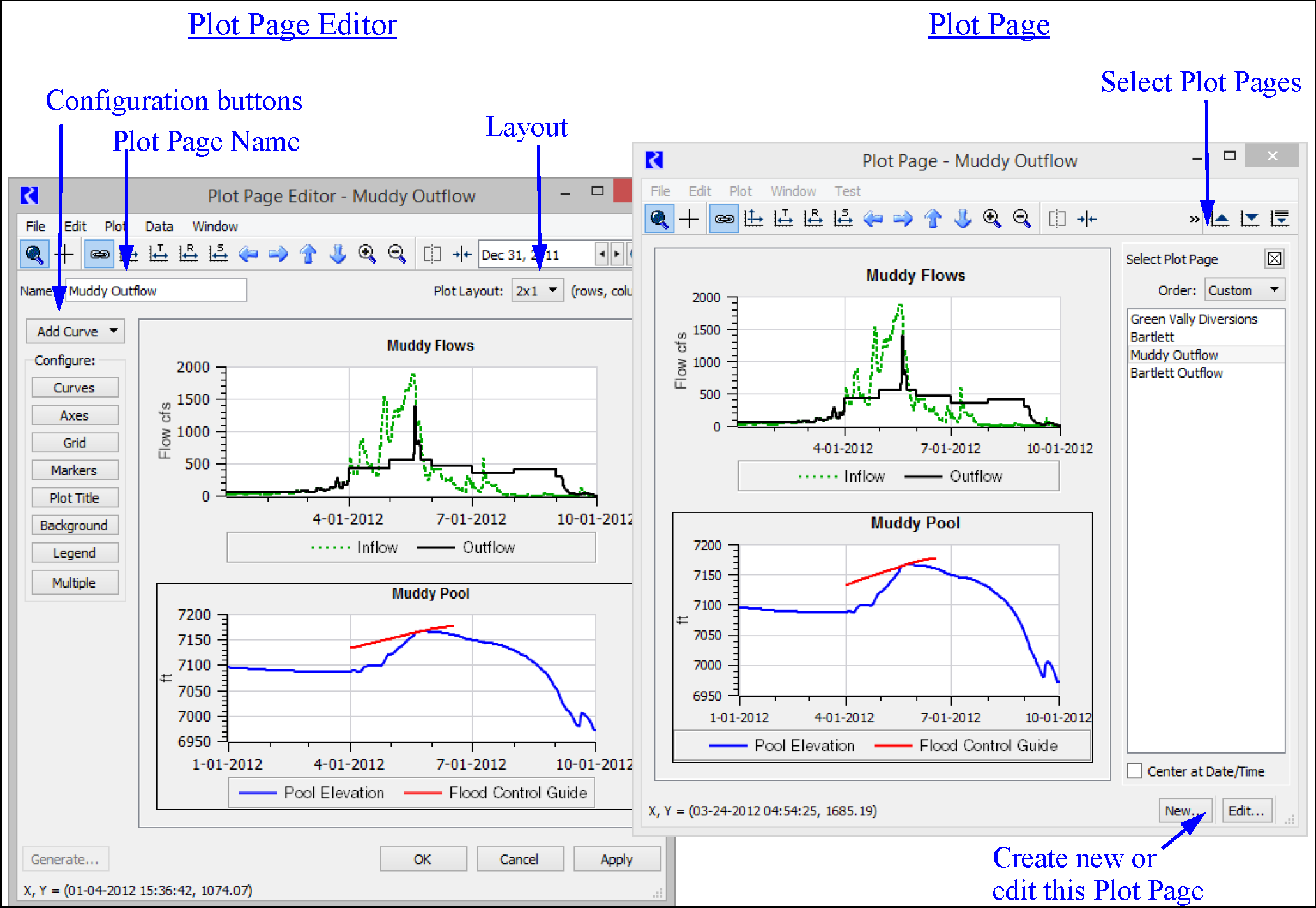
Plot Page Editor
In this section we describe how to use the Plot Page Editor to configure a Plot Page.
Accessing the Plot Page Editor
There are a number of ways to access the Plot Page Editor, as follows:
• From the main workspace, select Utilities, then Plot Page, or select Plotting  .
.
 .
. If there are no pre-configured plots saved in the model, this opens the Plot Page Editor. If there are pre-configured plots already saved in the model file, this will open the Plot Page dialog with the most recently selected plot displayed.
• From the Plot Page dialog, select New in the bottom right corner to open a blank Plot Page Editor. Select Edit to open the Plot Page Editor for the currently selected Plot Page.
• From the Plot Page dialog, select Edit, then Create New Plot from the menu bar to open a blank Plot Page Editor. Select Edit, then Edit Selected Plot to open the Plot Page Editor for the currently selected Plot Page.
• From the Output Manager, select New, then New Plot Page Alternatively, select an existing Plot Page in the list of output devices, and then select New. This will open a blank Plot Page Editor.
• From the Output Manager, select an existing Plot Page in the list of output devices, and then select Edit. This will open the Plot Page Editor for that Plot Page. Alternatively, double-select the Plot Page name to open the Editor, or select Edit, then All Plot Pages.
• From the Open Object dialog, highlight one or more slots and select Slot, then Plot Slots or select the plot icon.  This opens the Plot Page Editor with the selected slot(s) already plotted.
This opens the Plot Page Editor with the selected slot(s) already plotted.
 This opens the Plot Page Editor with the selected slot(s) already plotted.
This opens the Plot Page Editor with the selected slot(s) already plotted.• From the Open Slot dialog, select File, then Plot or select the plot icon.  This opens the Plot Page Editor with the slot plotted.
This opens the Plot Page Editor with the slot plotted.
 This opens the Plot Page Editor with the slot plotted.
This opens the Plot Page Editor with the slot plotted.• From a SCT, highlight one or more slots and select Slots, then Plot Slots or select the plot icon. 

Editing a Plot Page
All configuration for a Plot Page is carried out in the Plot Page Editor. You can plot series slots, table slots, scalar slots, and periodic slots. Series slots can be plotted with time on the x-axis, or two series slots can be plotted against each other. Multiple curves can be plotted on the same plot (set of axes), and multiple plots can be shown in different panels of a Plot Page.
Note: You must either give the Plot Page a name and select Apply or OK in the Plot Page Editor or save the Plot Page using File, then Save As to preserve the Plot Page configuration. Otherwise, when you close the Plot Page Editor, the Plot Page changes will be lost.
Give each Plot Page a name in the Name field near the top left of the Plot Page Editor. This is the name that will appear in the Plot Page Selection list in the Plot Page dialog and in the Output Manager.
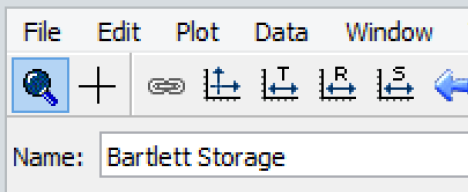
All editing of a Plot Page in the Plot Page Editor applies to the configuration of the Plot Page (e.g., the slots associated with the plots, layout, and line and color choices). Because plots are automatically updated with new slot information (after a new run or after user input values have been changed), a saved Plot Page does not preserve the results of a particular model run. Snapshots can be used to preserve the results of model runs; see “Snapshots” for details.
Plot Page Layout
Plots can be added to a Plot Page in the Plot Page Editor by selecting Window, then Set Layout. Alternatively, select the Plot Layout dropdown menu near the top right of the Plot Page Editor.
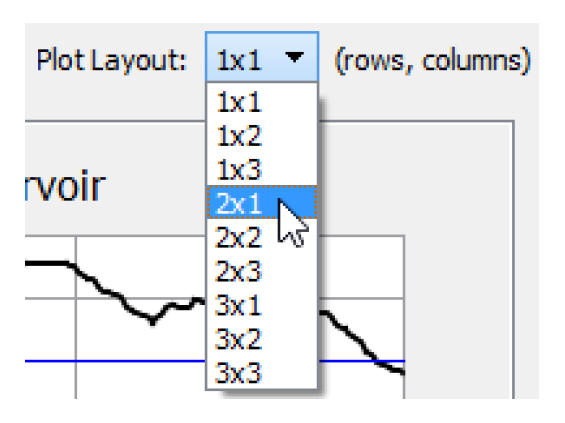
From either of these layout menus, you can choose the number of plots that appear in the Plot Page. You may change the Plot Page from a 1X1 array of plots to as many as a 3X3 array. When the display size of the Plot Page dialog changes, the plots are automatically updated to occupy the new dialog size. Figure 2.3 is a sample.
Figure 2.3 2X1 Plot Page
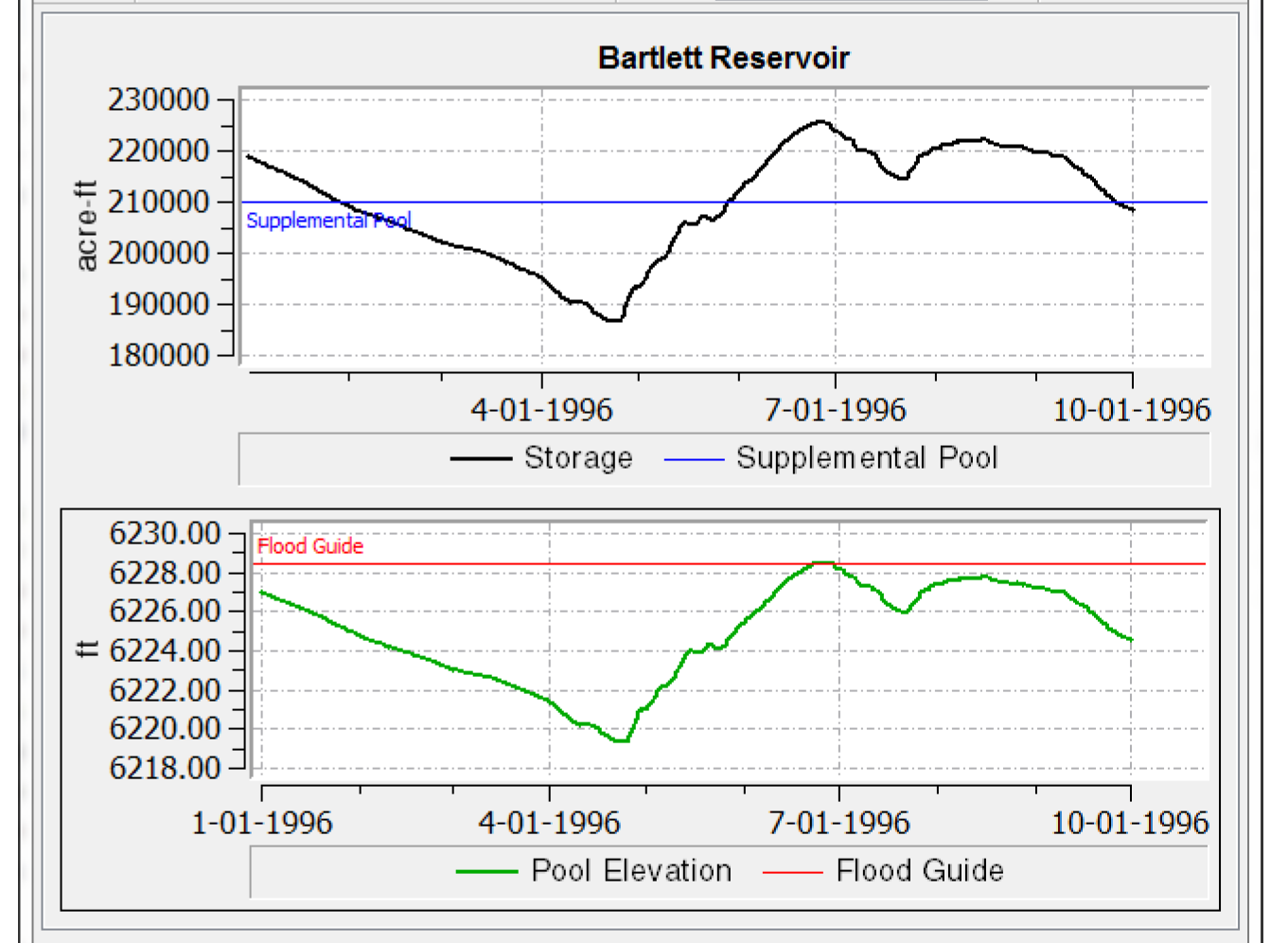
Whenever more than one plot is displayed, configuration changes will apply to the selected plot, which has a black outline around it.
Adding a Curve or Marker to a Plot
There are several methods to add a new curve to a plot. Descriptions for adding a series curve follow. The steps are similar for adding other types of curves and Markers. See “Types of Curves” and “Marker Configuration” for additional information.
• Select the Add Curve menu near the top left of the Plot Page Editor, and select Series.
• Select Data, then Add Series Curve
• Right-click the blank plot area and select Add Series Curve
• Select Data, then Membership, and select Add Series Curve.
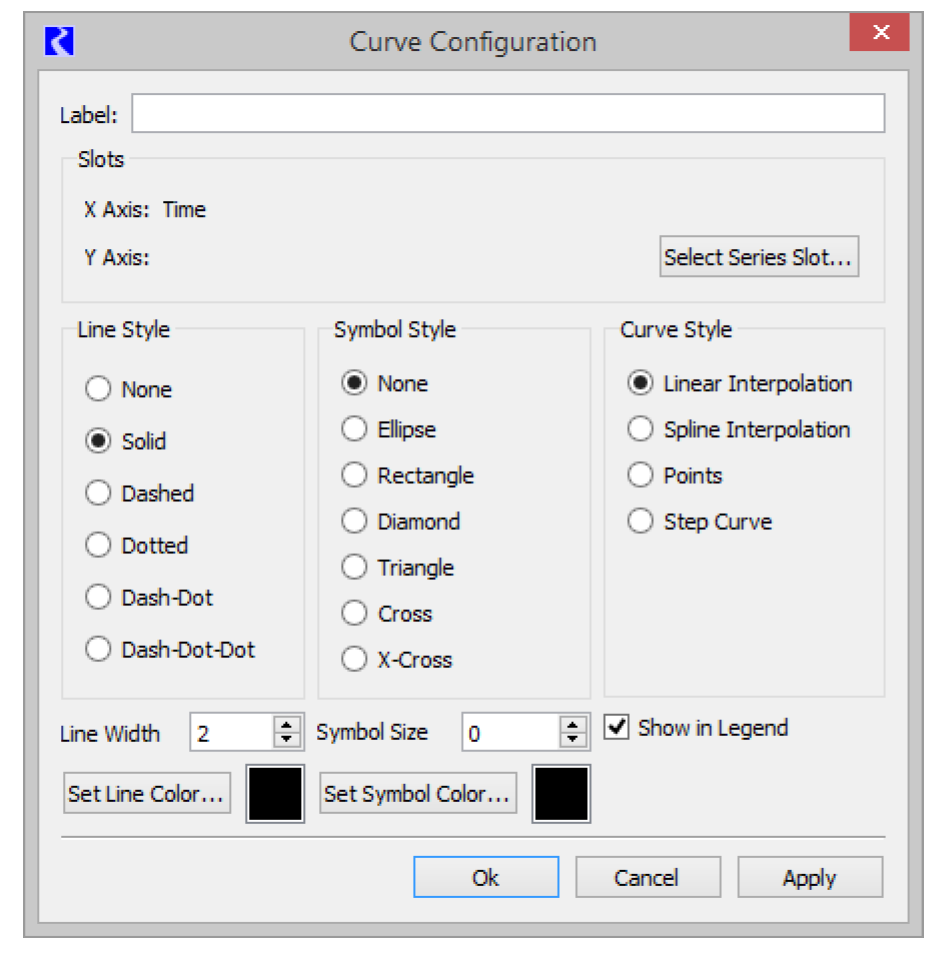
Note: From the Add Curve and similar menus you can directly add a curve for a Snapshot slot associated with a slot on the selected plot. See “Adding Associated Snapshot Curves” for additional information.
Curve Configuration
In the resulting Curve Configuration dialog, select Select Series Slot to bring up the Slot Selector. After selecting the desired slot and setting the curve configuration options, select OK in the Curve Configuration dialog to add the curve to the plot.
Alternatively, it may be more convenient to quickly plot a slot directly from the Open Slot dialog, Open Object dialog or SCT.
• From the Open Object dialog, highlight one or more slots and select Slot, then Plot Slots or select the plot icon. 

• From the Open Slot dialog, select File, then Plot or select the plot icon. 

• From a SCT, highlight one or more slots and select Slots, then Plot Slots or select the plot icon. 

The Curve Configuration dialog can be opened to edit an existing curve in any of the following ways:
• Select Curves on the left side of the Plot Page Editor dialog.
• Select Edit, then Curve Configuration from the menu bar of the Plot Page Editor.
• Right-click a curve label in the legend and select Configure.
• Right-click the plot area, and then in the resulting context menu select Configure, then Curves.
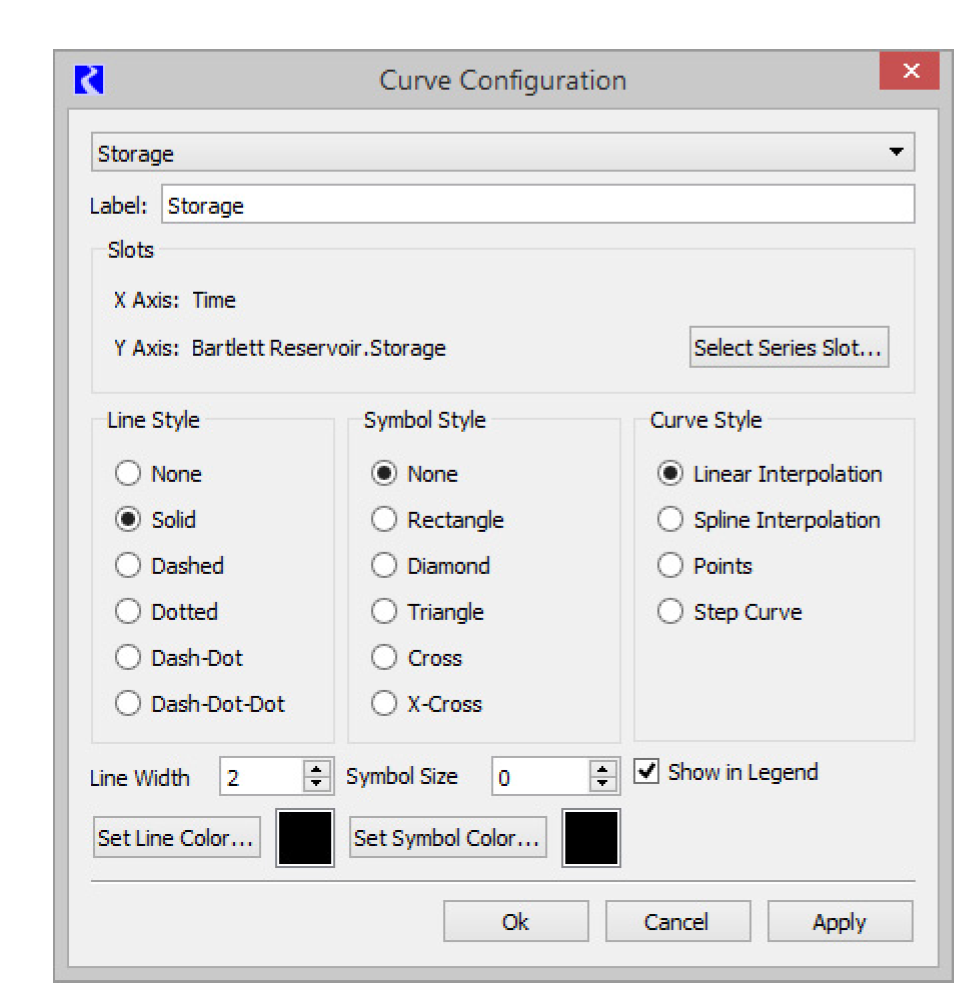
The slot associated with a curve can be changed. Select Select Series Slot to display a Slot Selector and select the desired new slot.
The name for the curve displayed in the plot legend can be modified in the Label field. By default the Object.Slot name is used.
The Curve Configuration window offers a selection of line and symbol styles. It lets you select how you want individual curves to be calculated/displayed. Options include the following:
• Linear Interpolation: Connect points with a line
• Spline interpolation: Use a “natural cubic spline” to fit a curve to the data. The curve is actually a series of spline interpolated points connected by lines. The algorithm creates three times the number of data points for use in the spline curve.
• Points: Only show the points.
• Step Curve: Show horizontal lines to the left of each data point in the series. These interval values are then connected by vertical lines to create a step. A step curve is the default curve style for slots involving units of flow since flow is an average value over a timestep.
To choose from one of several basic colors, or customize and save colors, select Set Line Color or Set Symbol Color. This opens the Set Color dialog. Use this dialog to choose one of several pre-defined colors, or to create and save special colors from an interactive palette. To create a custom color, move the cursor over the palette to find and select a desired color tone and hue. In the lower-right of the dialog, select Save to Custom Colors to save the curve within Custom Colors. To change the color properties of any custom color, select that particular color and make adjustments with the palette. Although you make adjustments to the pre-determined colors in the same manner, the changes are not saved unless you have entered them as custom colors.
The Curve Configuration also allows you to specify whether the curve should be shown in the Legend. Select the Show in Legend checkbox. You can also remove a curve from the legend by right-clicking the item in the legend and choosing Remove From Legend.
To delete a curve from a plot, right-select the curve name in the plot legend. Then in the resulting context menu select Delete Curve.
Axis Configuration
Access the Axis Configuration dialog in one of the following ways:
• Select Axes on the left side of the Plot Page Editor dialog.
• Select Edit, then Axis Configuration from the menu bar of the Plot Page Editor.
• Right-click the plot area, and then in the resulting context menu select Configure, then Axes.
Use the Axis Configuration to control the appearance of the axes. First select the desired Left Y, Right Y, Lower X or Upper X axis. The configuration options are different for numeric data versus time series data. First described are common settings and then the settings that are unique for numeric axes, then below for time axes.
Common Configuration
The following configuration options are common to numeric and time axes.
• Title: The axis label can be combinations of a user-supplied Label and the Unit Name. By default the unit name is used as the axis label.
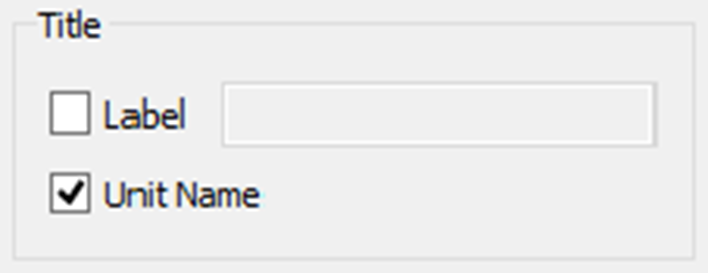
• Label Angle: Use the Label Angle menu to choose from one of the seven rotations.
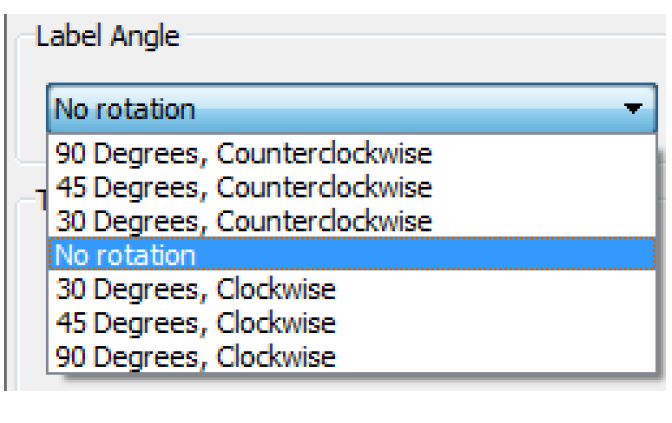
Figure 2.4 is an example of one of the options and the resulting axis labels.
Figure 2.4

Numeric Axis
The following configuration options apply to numeric axes only.
• Numeric Scale: You can configure numeric axes to use a Linear or Logarithmic scale. If the units displayed are percent, you also have the option to select a Probability scale as you would see on normal probability paper. On such a scale, normally distributed values will plot as a straight line. Figure 2.5 is a sample.
Figure 2.5

• Bounds: Set the Minimum and Maximum bound, the plotted range on each numeric axis.
• Numeric Display: Set the format of the numeric display using the options. Select one of the following options:
– Determine by Plotted Slots: The axis will use the display settings for the first slot assigned to the plot. These are based on the Unit Scheme rules for that slot.
– Use Custom Settings: Specify the settings for this axis. Change the Scale, Precision, Units, or Format. Format choices include Float (the default), Scientific (e.g. “1.046 E4”), or Scientific/Float. The Scientific/Float format uses Float format if the number is within a specific range, beyond which, the Scientific format is used.
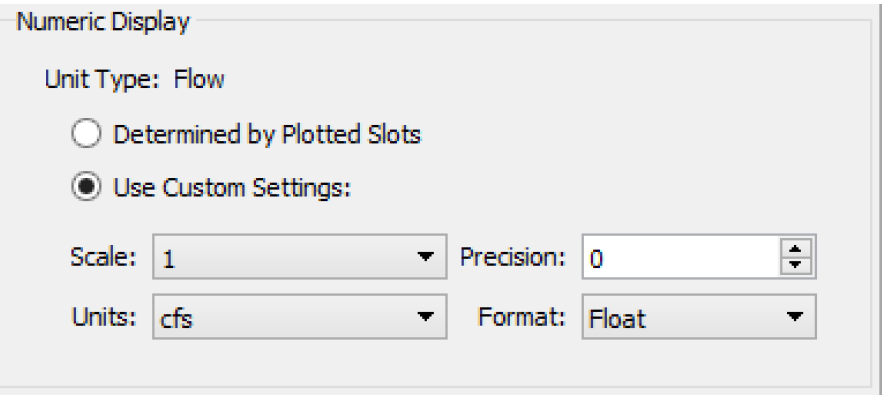
• Tick Marks: Specify the Max Major Ticks and Max Minor Ticks to show.
Note: This is the maximum possible; often there will be fewer tick marks shown.
Time Series Axis
Time series axes have alternative controls for the configured range and format. Time scales are always plotted linearly. The number of tick marks are computed automatically. Major and minor ticks are placed at reasonable time intervals based on the amount of time shown on the plot. For example, if you are plotting a year of data, the ticks will be on the start of each month. If you are plotting a month of data, the ticks will be on each day.
The Time Scaling panel includes the following fields:
• The Apply each time plot is shown checkbox. If this is selected, the configured time range is shown every time the plot is generated (regardless of the last zoom/scaling). In addition, with this on, the graph is also automatically re-scaled when the model's Run Range is changed.
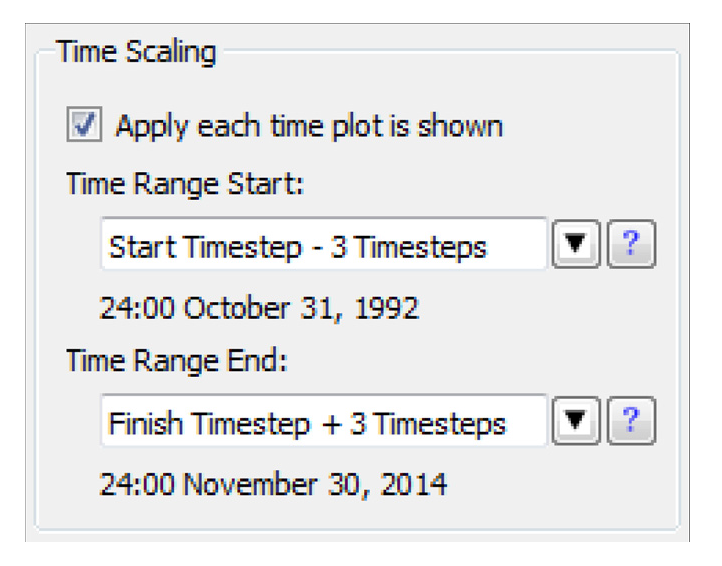
• Time Range Start and Time Range End editable selectors to define the time range.
These time controls are editable text and use the same symbolic datetime representation as RPL DATETIMES; see “DATETIME” in RiverWare Policy Language (RPL) for details. Text below the editor field indicates the actual datetime of the entered symbolic time text (if it is valid), or “undefined.” You can also use the drop-down menu to specify one of the common datetimes. Some of these are expressions which must be edited to become valid, e.g. by replacing “N” with a nonnegative integer and the HH:00 MMM DD, YYYY formula, where you substitute the hour, month, day and year.
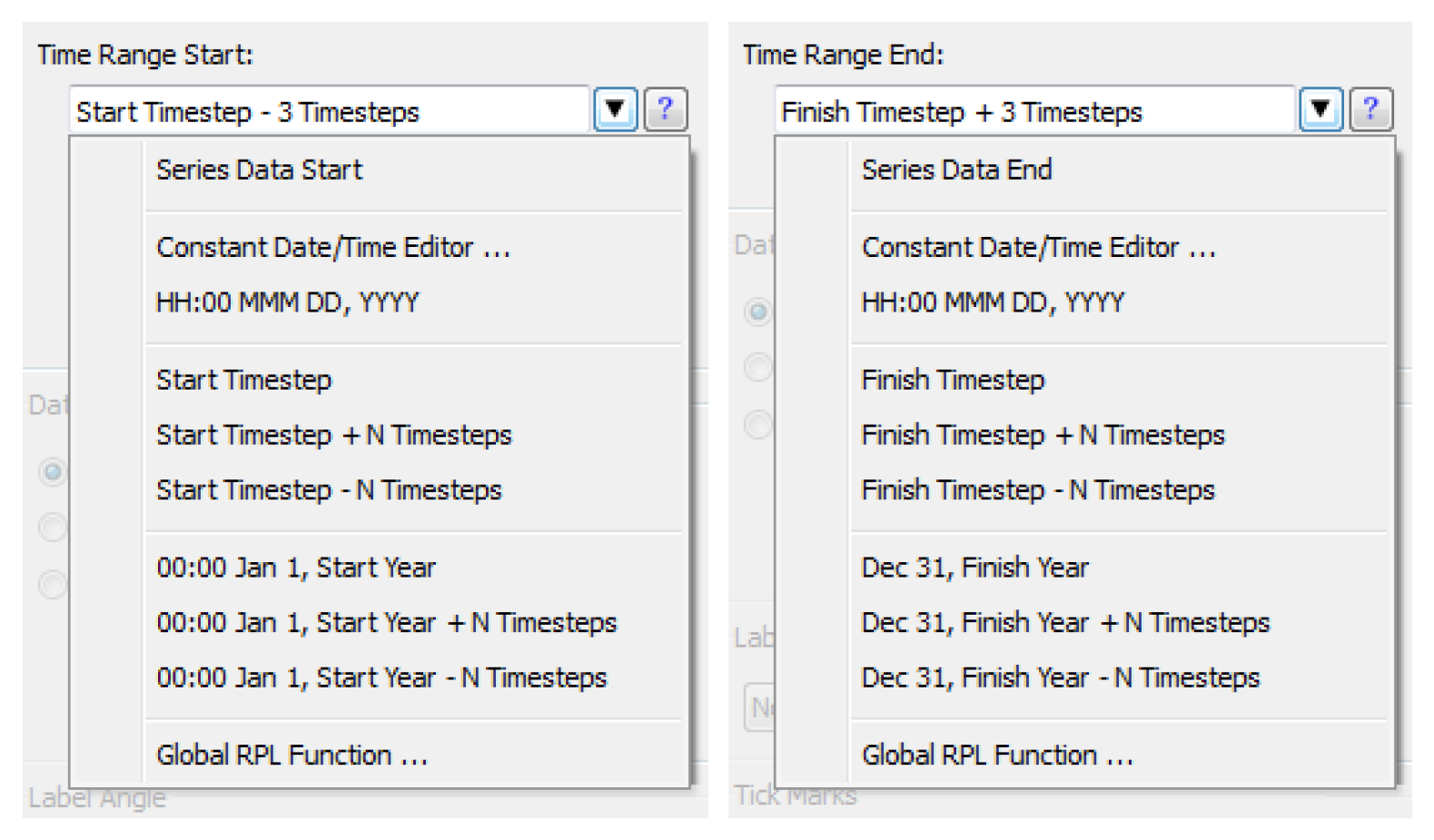
The Series Data Start and Series Data End represent the earliest and latest datetimes based on data within the plot’s series curves.
The Constant Datetime Editor selection opens a separate dialog to specify the datetime using a selector configured for the model's timestep size.

The choices with 00:00 Jan 1, and Dec 31, specify the beginning and end of a year expression, optionally plus or minus a specified number of timesteps.
The Global RPL Function opens a Function Selector to select a RPL function in a Global Function Set. The selected function must have a return type of DATETIME, and must not have any arguments.
Select Help (question mark icon) on the right side of the symbolic datetime editor to show a description of symbolic datetime representations.
Alternatively, enter any RPL fully specified DATETIME expression; see “DATETIME” in RiverWare Policy Language (RPL) for details.
For time series (i.e. lower x axis typically), you can specify the Date/Time Format.
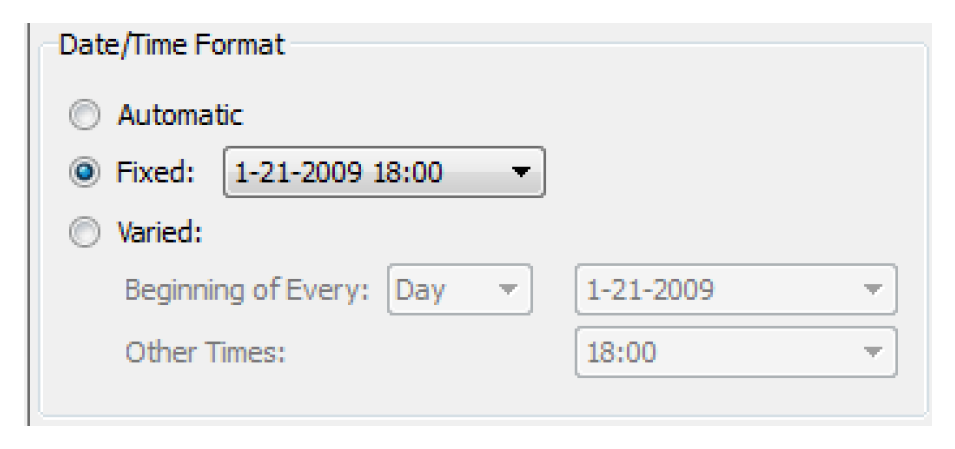
• Automatic mode supports the traditional format. Date labels on the time axis are presented based on the overall time range of the plotted series data:
– Time range > 3 days: 1-21-2009
– Time range < 3 days: 01-21-2009 18:00
• Fixed mode provides a single format for all labeled tick-marks.
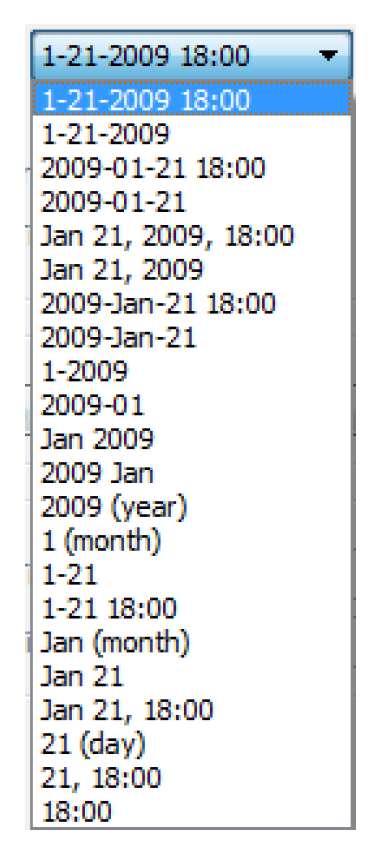
• Varied mode displays date/time axis label text in two different selected formats:
– One format for date/times starting at the beginning of every Year, Month, or Day, and
– A different format for all other date/times.
For example, Figure 2.6 shows a varied format, with the full date at the beginning of the day and just the time for all other labels. The resulting axis is shown.
Figure 2.6

Grid Configuration
Access the Grid Configuration dialog in one of the following ways:
• Select Grid on the left side of the Plot Page Editor dialog.
• Select Edit, then Grid Configuration from the menu bar of the Plot Page Editor.
• Right-click the plot area, and then in the resulting context menu select Configure, then Grid
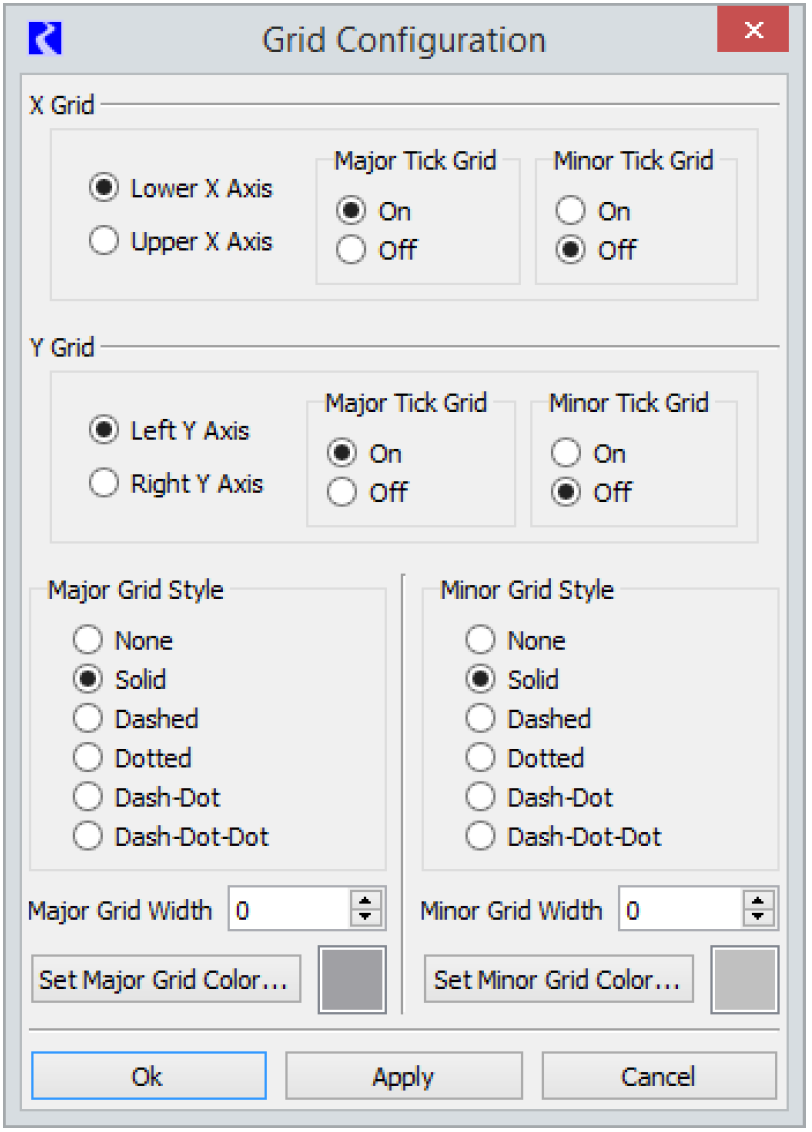
In the Grid Configuration dialog you may select whether major and minor grid lines are visible on each axis. You also select from this dialog the grid line style and color.
Marker Configuration
Markers allow you to add horizontal or vertical lines on a plot marking some important threshold or boundary. You can add, delete or edit markers from the Marker Manager. Access the Marker Manager in one of the following ways:
• Select Markers on the left side of the Plot Page Editor dialog.
• Select Edit, then Marker Manager from the menu bar of the Plot Page Editor.
• Right-click the plot area, and then in the resulting context menu select Configure, then Markers.
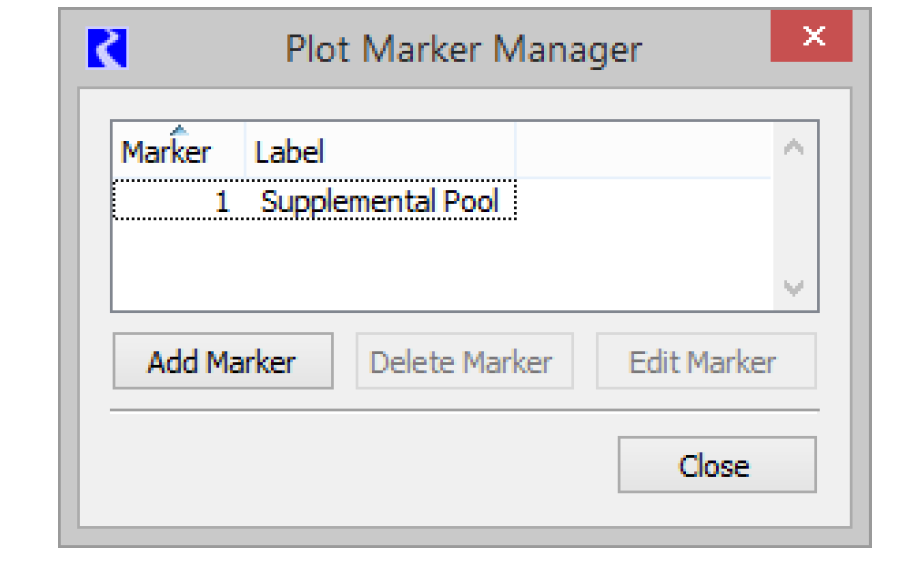
Add a marker by selecting Add Marker in the Marker Manager. To edit the marker, highlight the marker in the Marker Manager and select Edit Marker.
The Marker Configuration dialog box provides marker configuration options.
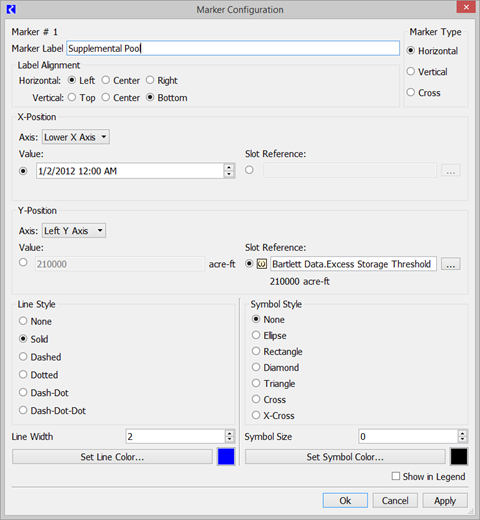
In the upper-right, under Marker Type, select the axis/axes in which the marker appears. The horizontal marker creates a line at a specified Y value, the vertical marker creates a line at a specified X value, and the cross marker creates both a horizontal and vertical line. Optionally, add a label to the marker in the Marker Label field, and its position can be set by selecting the appropriate Horizontal and Vertical Alignment option.
Next, select the location of the marker on each axis, in the X-Position and Y-Position regions. Select the desired axis (Lower X or Upper X / Left Y or Right Y) and then specify either:
• Value: Enter a static value in the axis units. For an X-axis displaying time, toggle through timestep intervals, using the arrows or type in the text.
• Slot Reference: Use the button to open a slot selector and select a scalar slot that holds the marker value. Once chosen, the value will be shown. The slot must be a scalar slot (regular scalar or scalar with expression) and have the same unit type as the axis. Use this option if the value referenced by the marker will change via DMI, Initialization Rule, Script or user input.
Also, in the Marker Configuration, specify the Line Type, Line Width, Line Color, Symbol Style, Symbol Size, and/or Symbol Color.
Specify whether to display a legend entry for the marker by selecting the Show in Legend checkbox. You can also remove a marker from the legend by right-clicking the item in the legend and selecting Remove From Legend.
Set Plot Title
A separate title can be given to each plot in a Plot Page. Access the Plot Title Editor in one of the following ways:
• Select Plot Title on the left side of the Plot Page Editor dialog.
• Select Edit, then Set Plot Title from the menu bar of the Plot Page Editor.
• Right-click the plot area, and then in the resulting context menu select Configure, then Title.
In the resulting Plot Title dialog, provide a customized name for the plot. Then select OK or Apply. The font for the plot title can be changed in the Plot Settings; see “Plot Page Settings”. However, the font is a user setting and will apply for all plot titles in RiverWare for that user.
Set Background Color
Access a color selector for the plot background in one of the following ways:
• Select Background on the left side of the Plot Page Editor dialog.
• Select Edit, then Set Background Color from the menu bar of the Plot Page Editor.
• Right-click the plot area, and then in the resulting context menu select Configure, then Background Color.
Select the desired background color from the color selector dialog.
Reorder Legend
Access the Reorder Plot Legend dialog in one of the following ways:
• Select Legend on the left side of the Plot Page Editor dialog.
• Select Edit, then Reorder Legend from the menu bar of the Plot Page Editor.
• Right-click one of the legend items in the plot, and then in the resulting context menu select Reorder Legend.
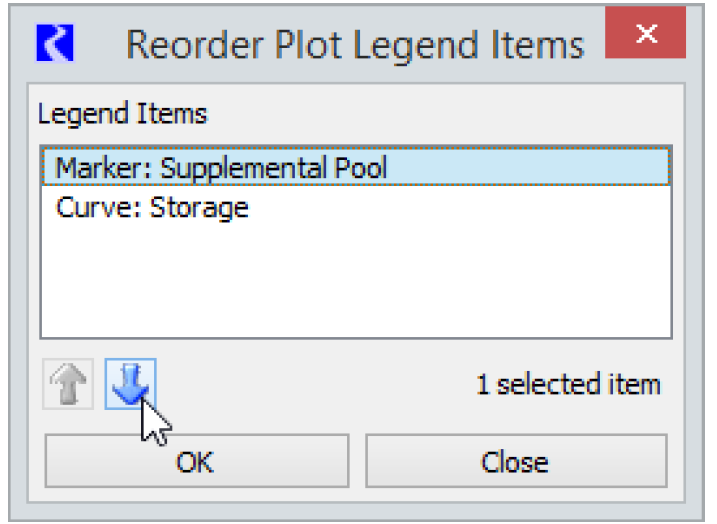
Select one or more curves or markers and use the Up and Down arrows to re-arrange the order. Curves or Markers in the italics font are not shown in the legend (based on their Curve/Marker configuration) but are still listed in the Reorder dialog.
Plot Page Editor Menus
Following is a description of each menu in the Plot Page Editor.
File Menu
The File drop-down menu offers options for saving Plot Pages in the model, creating templates or similar Plot Pages, exporting the Plot Page to a file, and exporting or printing plot images. Following are descriptions of the available selections.
• Save As: Select Save As to save the Plot Page with a name if it does not already have one (same as entering a name in the Name field of the Plot Page Editor and selecting Apply). If the Plot Page has already been saved with a name, the Save As selection can be used to save a copy of the Plot Page with a new name. In both cases the new name will be added to the Plot Page Selection List in the Plot Page dialog. Saving a Plot Page will preserve the configuration of the Plot Page (e.g., the slots associated with the plots, layout, and line and color choices). Because plots are automatically updated with new slot information (after a new run or after user input values have been changed), a saved Plot Page does not preserve the results of a particular model run. Snapshots can be used to preserve the results of model runs; see “Snapshots” for details.
Note: You must either save a Plot Page using Save As or give the Plot Page a name and select Apply in the Plot Page Editor to preserve a Plot Page configuration. Otherwise, when you close the Plot Page Editor, the Plot Page is lost.
• Save As Template allows you to save the current Plot Page as a template. See “Plotting Templates” for details on creating and using templates.
• Create Similar Plot Pages allows you to directly create Plot Pages similar to the existing Plot Page using different objects, accounts, slots, or supplies depending on which sub-menu is selected. See “Creating Similar Plot Pages” for details.
• Import Plot Page Configurations allows you to import Plot Page Configurations that have been exported to a file. Select a desired import file from the resulting File Chooser dialog and select Open. An informational dialog is displayed that summarizes the devices that were imported. Unique names are created (via a numbered suffix) for any Plot Pages with names that already exist as Plot Pages in the model.
Note: This is the same import capability that is available through the Output Manager; see “Exporting and Importing Output Devices” for details.
Note: If Plot Pages are exported from one model and imported into another one that does not have the same objects and slots, the curves of the plots will not have valid slots associated with them.When you generate the Plot Pages, the curves will appear in the legend of the plots, but without data for the curves. You can then select new slots using the curve configuration section; see “Curve Configuration” for details.
• Export Plot Page Configuration allows the selected Plot Page configuration to be exported to a file. Select or enter a desired file path and name in the resulting File Chooser dialog, and select Save. All Plot Page configuration information is saved to the file.
• Export Image allows saving of the image of a selected plot or all plots on the Plot Page to a graphics file. The graphics file can be in one of a number of image formats. Other options include the export image’s size (number of pixels) and resolution (low-medium-high). See “Printing and Exporting Plots” for additional information.
• Print Preview will show of preview of the plot as it would appear on the specified printer. See “Printing and Exporting Plots” for additional information.
• Print will send a selected plot or all plots on the plot page to your printer. See “Printing and Exporting Plots” for additional information.
Edit Menu
The Edit menu lets you access several configuration options.
• Copy Plot Image copies the plot or plot page as an image for pasting to a document or email. See “Copy Plot as an Image” for additional information.
• Configure Multiple Curves and Plots has the same behavior as selecting Multiple. See “Curve Configuration” for details.
Plot Page Settings
Select Edit, then Plot Page Settings menu to display the Plot Page Settings dialog which allows you to change settings for fonts, and how tools behave. Plot settings are saved with a user account on a particular machine rather than with the Plot Page or model file. This allows you to restore your default settings as desired.
Figure 2.7
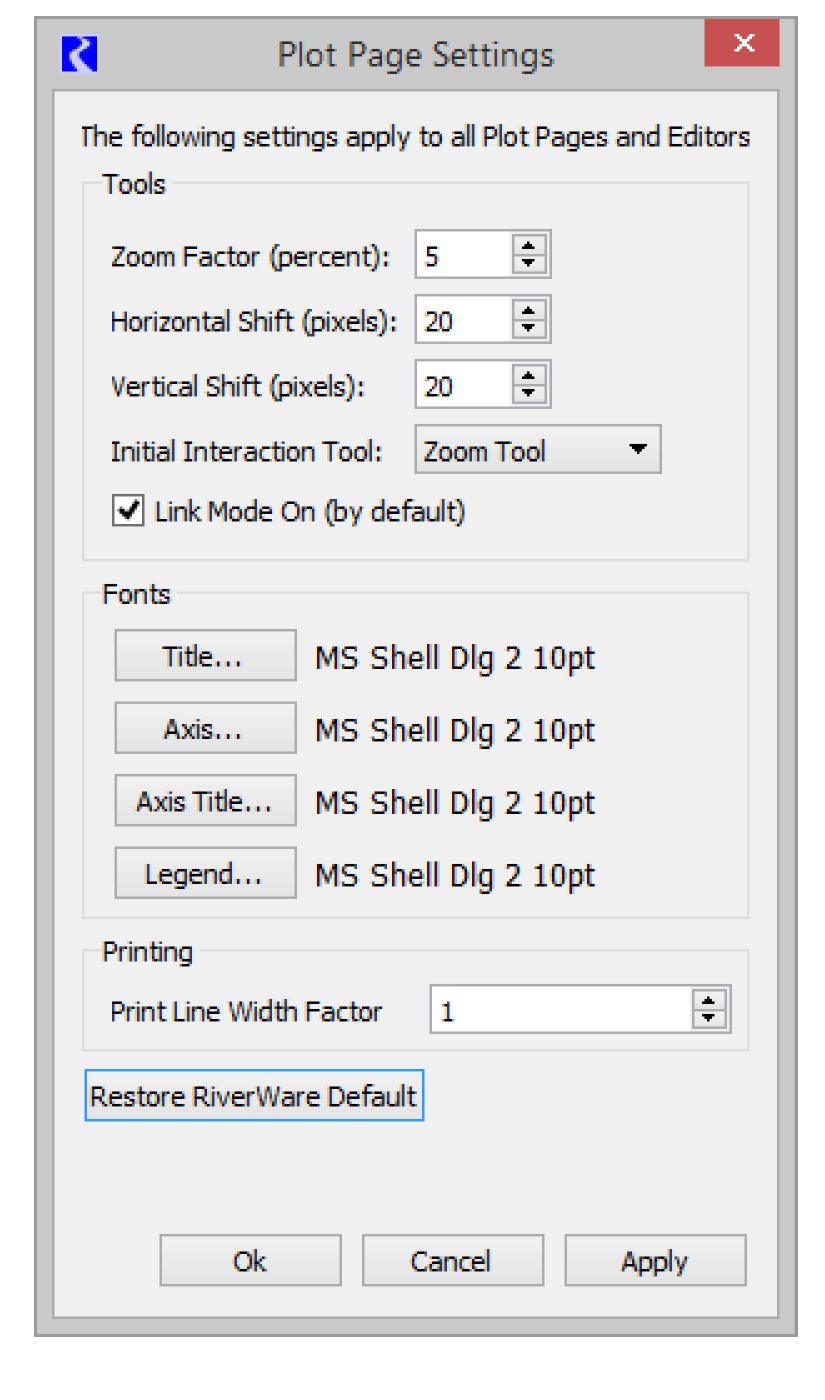
The top of Plot Dialog Settings controls the tools that appear on the plot dialog. Selections at the top of this dialog box let you determine
• Zoom Factor: the extent to which the plot size is enlarged or decreased when you select the Zoom tool.
• Shift: here is also a function that lets you set the number of pixels to which the plot is moved along either axis with the translate tool. You can enter these values manually or toggle them with the arrows adjacent to each window.
• Initial Interaction Tool: Also, you may select whether the default mouse tool zooms or re-centers the plot.
• Link Mode On: whether the link mode is on or off by default. In the event that there is more than one plot in a Plot Page at any given time, use the link mode. Having the link mode on causes any manipulation, such as zooming or translating along an axis, to be carried out by all of the plots in the Plot Page.
The Plot Dialog Settings has options to customize the fonts used for the plot Title, Axis, Axis Title, and Legend separately. There are options for various font sizes, styles and types. The font characteristics are stored per user—not as part of the model file. This eliminates potential problems with loading plots on machines that may not have the same set of available fonts.
Note: Changes to the settings and fonts in the Plot Page Settings will apply to all existing plots.
The Print Line Width Factor is used to specify how wide you would like printed lines on paper or PDFs. During printing, all of the slot curves' and markers' line widths are increased using a function of this factor in order to give the lines a proper appearance when printing. Default is 1, but you can increase it as needed.
Select Restore RiverWare Default to restore the system defaults; as shown in Figure 2.7. For Fonts, MS Shell Dlg 2 is used as the RiverWare default for all fonts. This selected font essentially tells the system to decide which font to use. In most cases, the Tahoma font is displayed.
Configuration Defaults
The Edit, then Configuration menu opens the Plot Defaults for curves, axes, grids, and background color. These configuration options set the defaults for new plots.
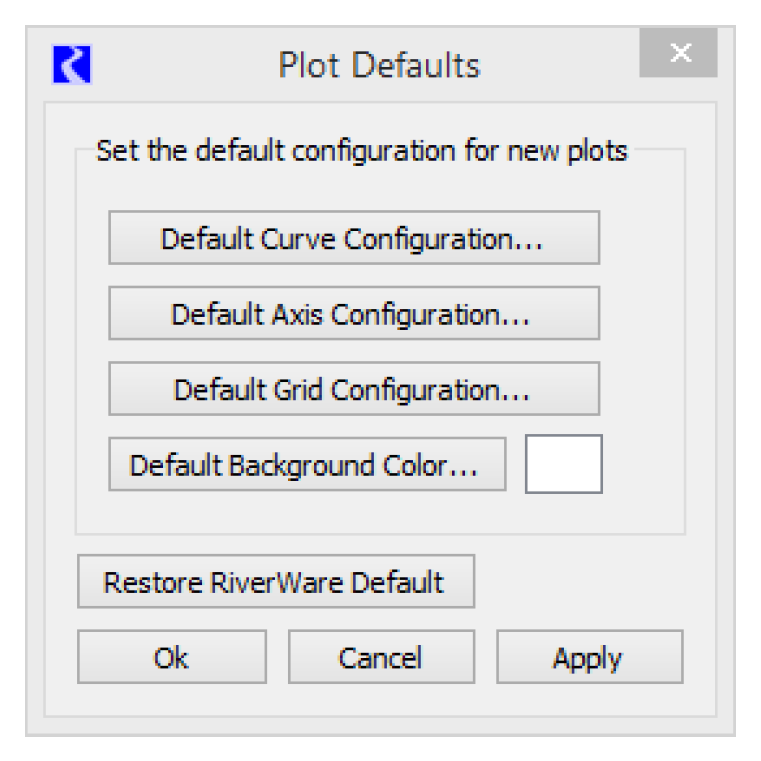
• Default Curve Settings sets default line, symbol, and curve styles.
• Default Axis Settings sets defaults for the axes, including the following:
– Format for the numeric display on the axes.
– Time scaling used when the plot is created. See “Time Series Axis” for additional information on use of this format.
– Default Date/Time Format
– Major and minor tick mark settings.
– Two-column table slot defaults. This setting allows table slots with length units in the first column to be shown with the length unit as the vertical axis. This overrides the default behavior. See “Table Curves” for additional information.
• Default Grid Settings sets default major and minor grid styles, width and color.
• Default Background Color sets the color used by default for the plot background.
Select Restore RiverWare Default restore the system defaults. These include a white background, curve line thickness of 2, major grid line thickness of 1, with dotted grey line type. There are no minor grid lines.
Plot Menu
The Plot drop-down menu displays options that deal with an individual plot or panel including zoom and scaling capabilities. For easy access, many of the functions listed here also appear on the toolbar and the plot right-mouse context menu, or you can execute them using key commands. These include the Auto-scale, Zoom-In, Zoom-Out, and Move commands. Next to each command are displayed keyboard shortcuts for each action.
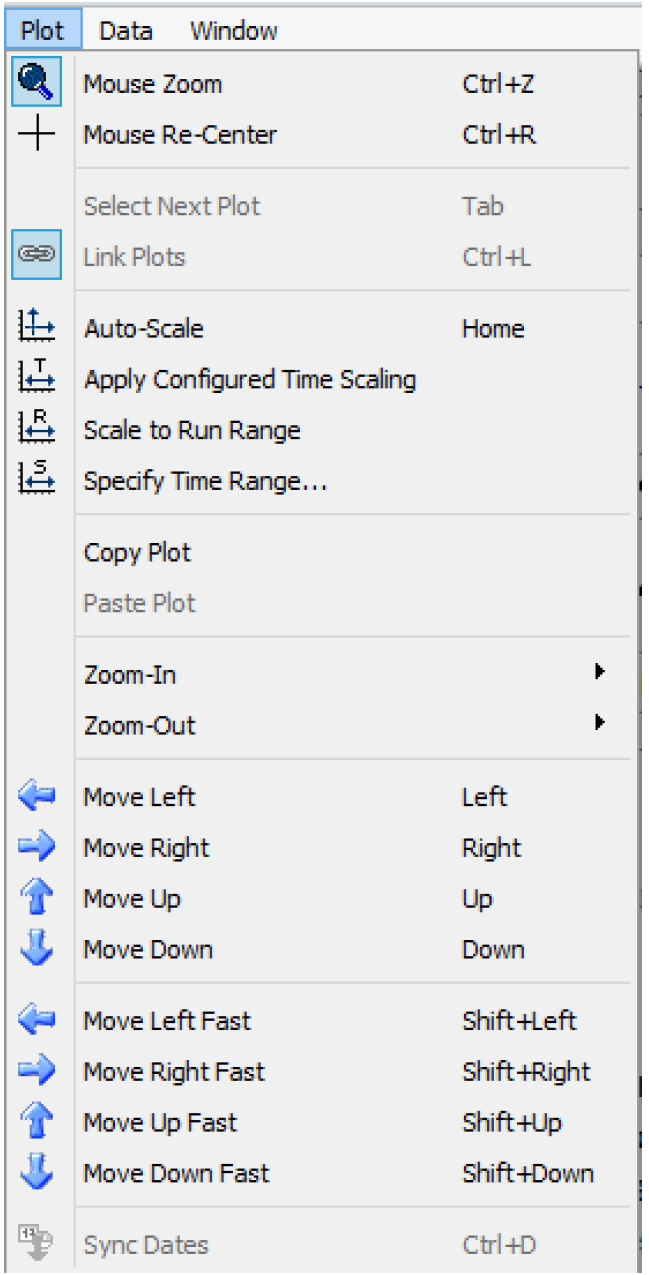
Following is a description of each command in the Plot menu.
Mouse Zoom/ Mouse Recenter 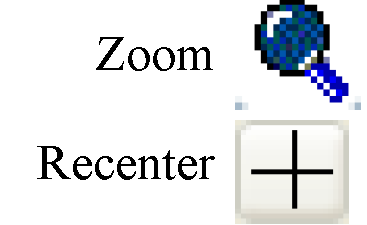

The Mouse Zoom and Mouse Recenter features determine the function of the mouse icon. The Recenter tool displays crosshairs as a mouse icon and causes the plot to be centered around the point at which the mouse is selected. The Zoom tool displays a magnifying glass cursor icon, which lets you select a zoom rectangle by click-and-dragging the mouse.
Select Next Plot
Selects the next plot, shortcut: Tab key. In a multi-column layout, the next plot is the one to the right, then down.
Link Plots 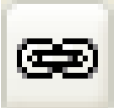

If there is more than one plot in the Plot Dialog the Link Plots tool is active, letting you do manipulation operations on all of the plots in unison (including AutoScale, the Shift Tools, the Zoom Tools, Date Spinner, and Date Center). If Link is off, you manipulate the currently selected plot (selected by selecting the plot or by using Tab to toggle). If you are using only one plot, this function is not available. You may not link plot customization operations—they must be performed on individual plots.
Auto-Scale 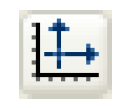

The Auto-Scale feature scales and translates the plot to include the entire range of data.
Apply Configured Time Scaling 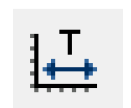

The Apply Configured Time Scaling feature scales and translates the plot to the range configured on the axis. This can be a symbolic or absolute time range. In addition, you can configure the plot to always use this configured time range when opening the plot. See “Time Series Axis” for more information.
Note: This operation does not affect the y axis scaling.
Scale to Run Range 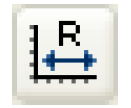

The Scale to Run Range scales the x axis to the run range defined on the run control. It is available only for times series plots. The y axis display is not affected.
Specify Time Range 

The Specify Time Range operation scales the plot to a range that you specify in the dialog. This operation does not affect the y axis scaling. There is also the option to Apply to All Open Plots. This sets the visible range of all open plots to the specified range. Each Plot Page would need to be saved to preserve that range.
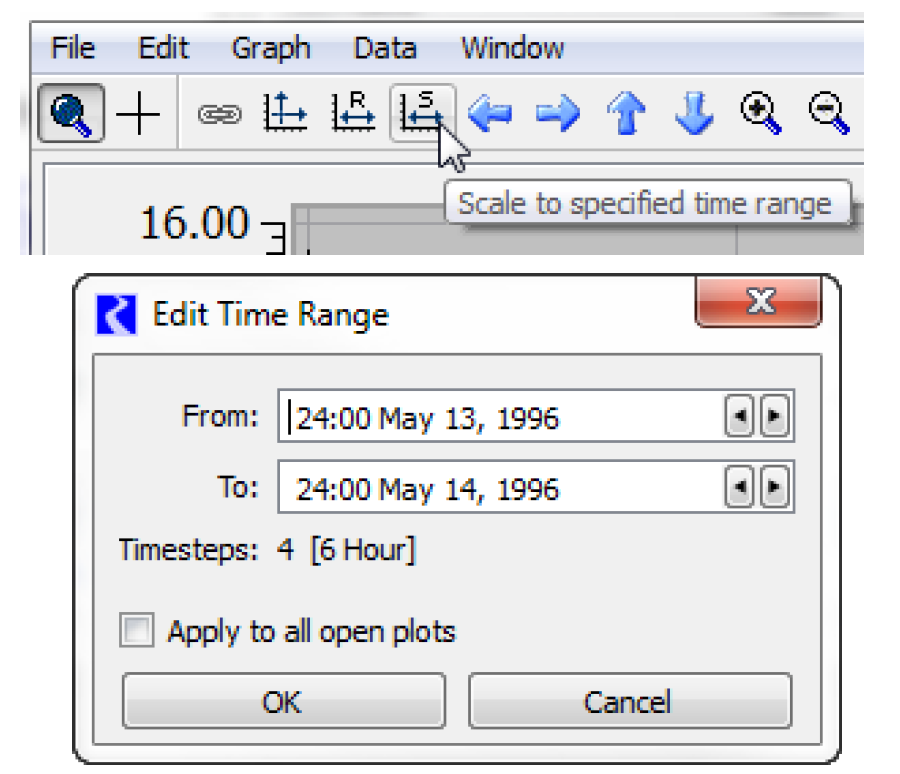
Copy Plot / Paste Plot
The Copy Plot menu item allows you to copy the selected plot to the plotting clipboard and then the Paste Plot menu item allows you to paste that plot to a new location. These two menus allow you to quickly combine or separate multi-layout Plot Pages. For example, you may have two great 1X1 Plot Pages configured as desired. Now you wish to combine those individual plots into a 2X1 Plot Page so that you can see them on a linked x axis. Select one of the plots, and copy it. Then create a new 2X1 Plot Page and paste the first plot onto one of the empty plot panels. Repeat the copy for the second plot, and then paste it into the empty plot panel in the 2X1 layout.
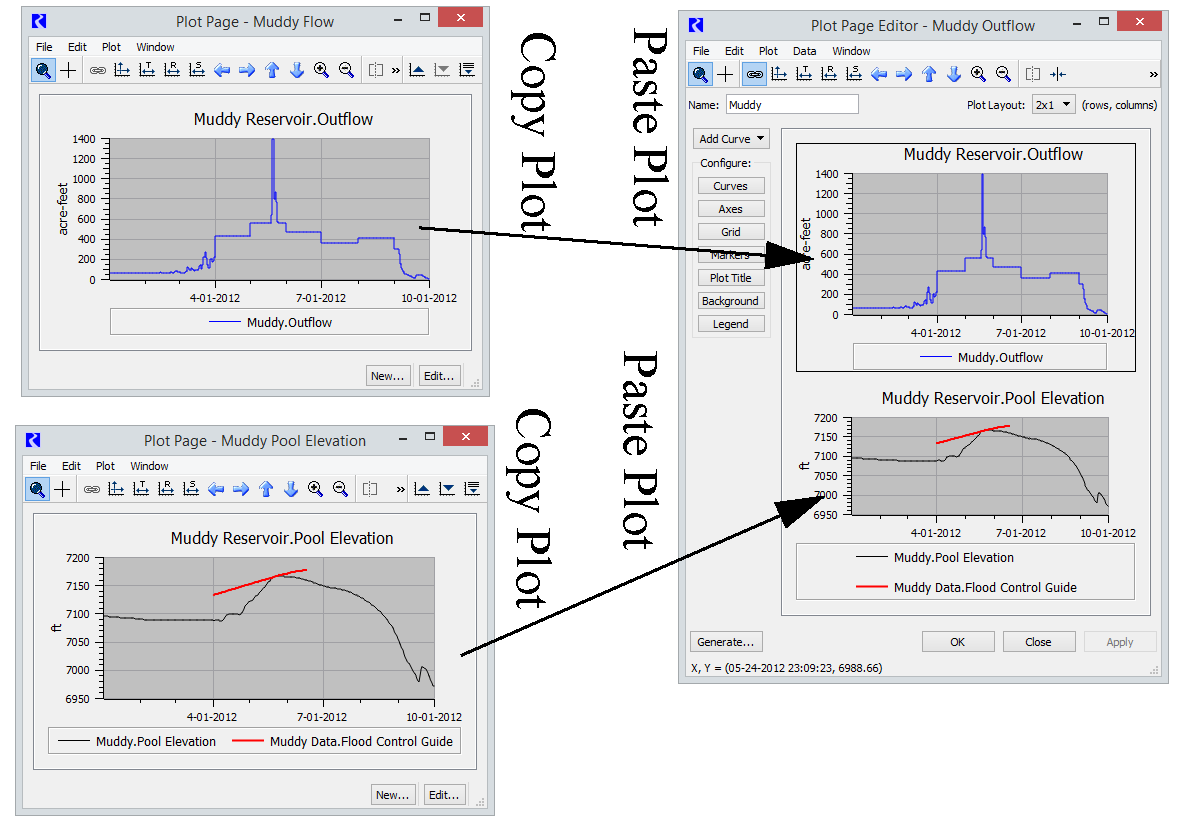
Note: This option is used to copy the plot for use in another plot. If you want to copy the plot as an image and paste it in a document, use Edit Copy Plot Image. See “Copy Plot as an Image” for details.
Zoom Tools 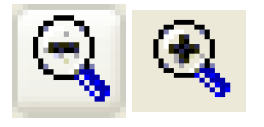

The Zoom feature zooms in or out on the center of the plot dialog.
Note: Use the middle mouse wheel to zoom in/out on either the plot area or an axis. See “Mouse Button Actions” for additional information.
Move Tools 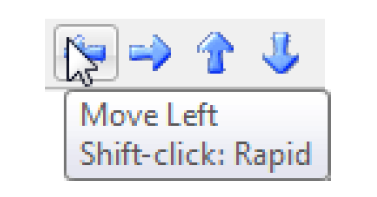

The Move tools shift the plot in either the X or Y direction. You set the magnitude of the move from the Plot Page Settings. There are also options to do a rapid move. Use the arrow keys as shortcuts. Use the Shift-Arrow or Shift-select to do a rapid move.
Note: Click the middle mouse button/wheel to pan the plot area. See “Mouse Button Actions” for additional information.
Sync Dates 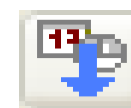

The Sync Dates feature synchronizes the dates on all plots in the selected column. If there is only one plot on the Plot Page, this function is not available.
Plots can be autoscaled individually or together. To autoscale or manipulate multiple plots in unison, they must first be linked. Plots can be linked by selecting Plot, then Link Plots or select Link Plots. Autoscaling the plots is then achieved by selecting Plot, then Autoscale or selecting Autoscale.
Data Menu
The Data menu is used to add data or markers to the plot.
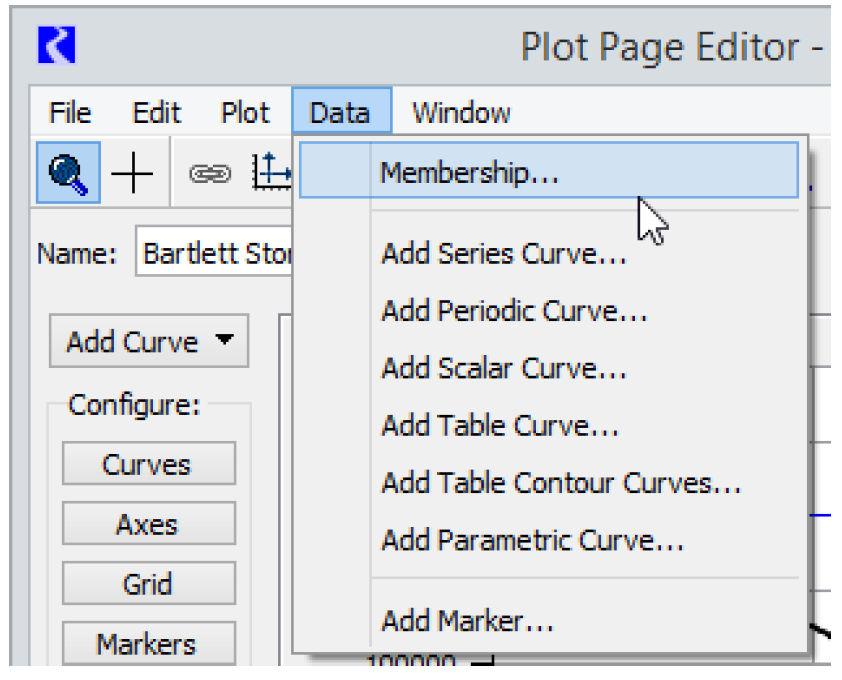
Membership
From the Data, then Membership menu, the user can add or view the various types of plots.
Add Curve Functions
The Data drop-down also lets you select each slot type individually with the Add Series Curve, Add Periodic Curve, Add Scalar Curve, Add Table Curve, Add Table Contour Curves, and Add Parametric Curve items. Selecting one of these commands prompts the Curve Configuration dialog for the specific curve to appear.
Add Marker
Lets you insert a marker into the plot.
To insert a marker into the plot: Select Add Marker. The Marker Manager dialog appears. See “Marker Configuration” for details.
Window Menu
Set Layout
In the Window, then Set Layout drop-down menu of the Plot Page Editor, you select the number of plots that appear in the plot dialog. To change the dialog from a 1X1 array of plots to as many as a 3X3 array: Select the Set Layout menu item.
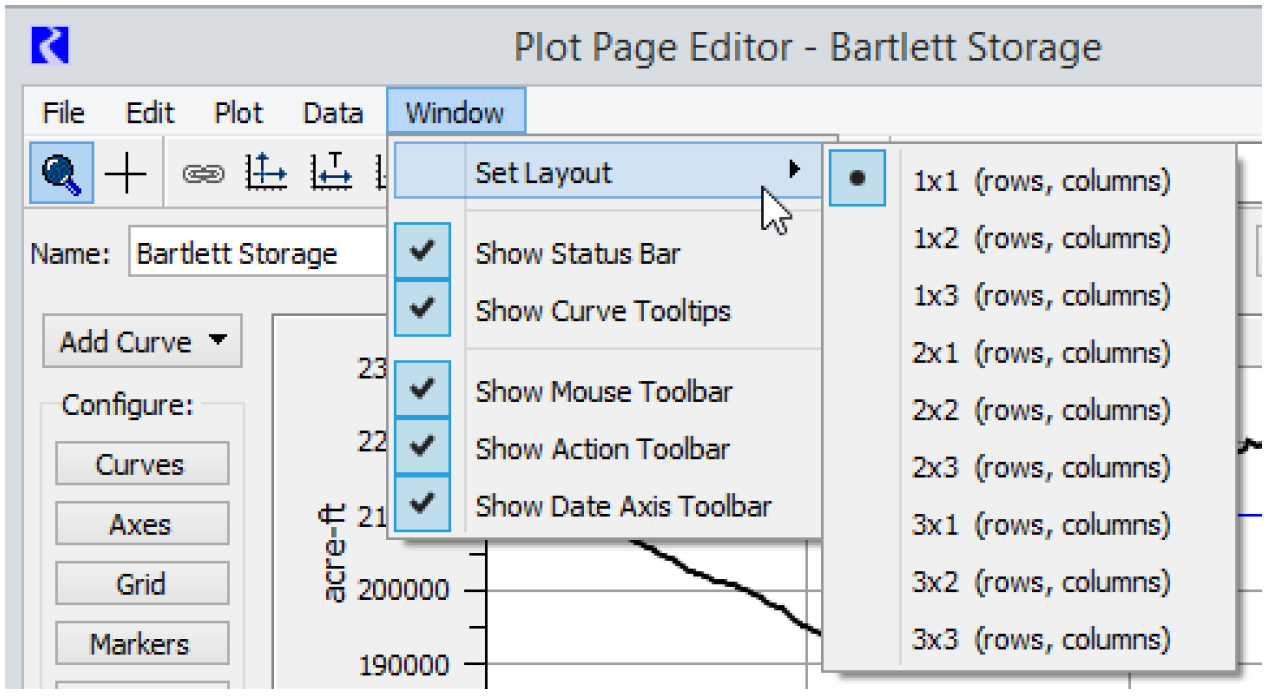
When the display size changes, the plots are automatically updated to occupy the new dialog size.
You can then copy and paste individual plots by selecting Plot, then Copy Plot and Plot, then Paste Plot. See “Copy Plot / Paste Plot” for details.
Context Menus
The plotting dialog allows the concept of context sensitive right-mouse functions. This lets you manipulate, configure, and export or print a plot using the menus. Global Time Scroll allows you to move all dialogs in the model (including future ones) to the date at which you selected. This is especially useful for debugging. When the Global Time Scroll is activated on a plot, a dotted red vertical marker line can be shown on the plot. This line can be hidden by selecting the Date Spinner in the toolbar. See “Toolbar Actions” for additional information.
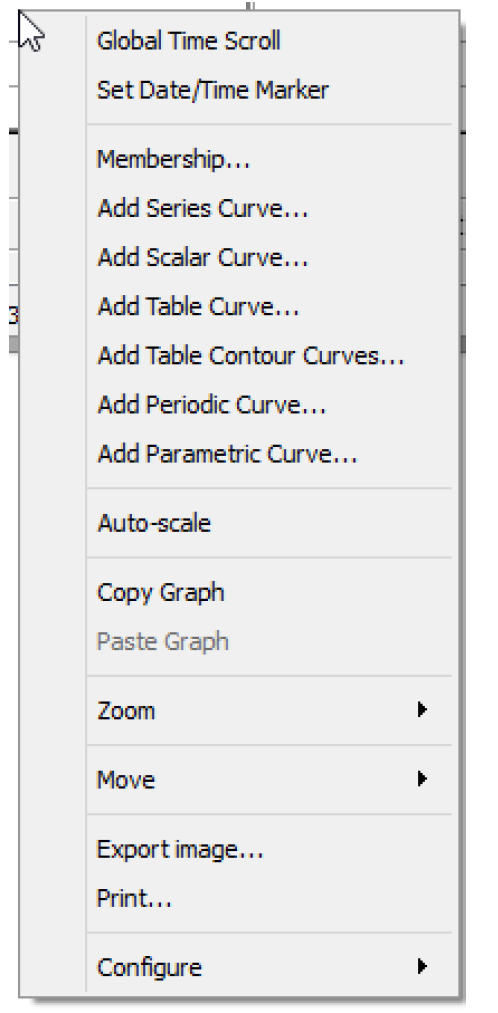
Types of Curves
There are six types of curves described in the following sections: Series, Scalar, Table, Table Contour, Periodic, and Parametric.
Series Curves
A Series Curve plots a timeseries of data from a Series Slot. The x-axis is time and the y-axis is the value. Multiple series can be plotted on one curve and can have multiple axes. Figure 2.8 is an example of two series curves.
Figure 2.8
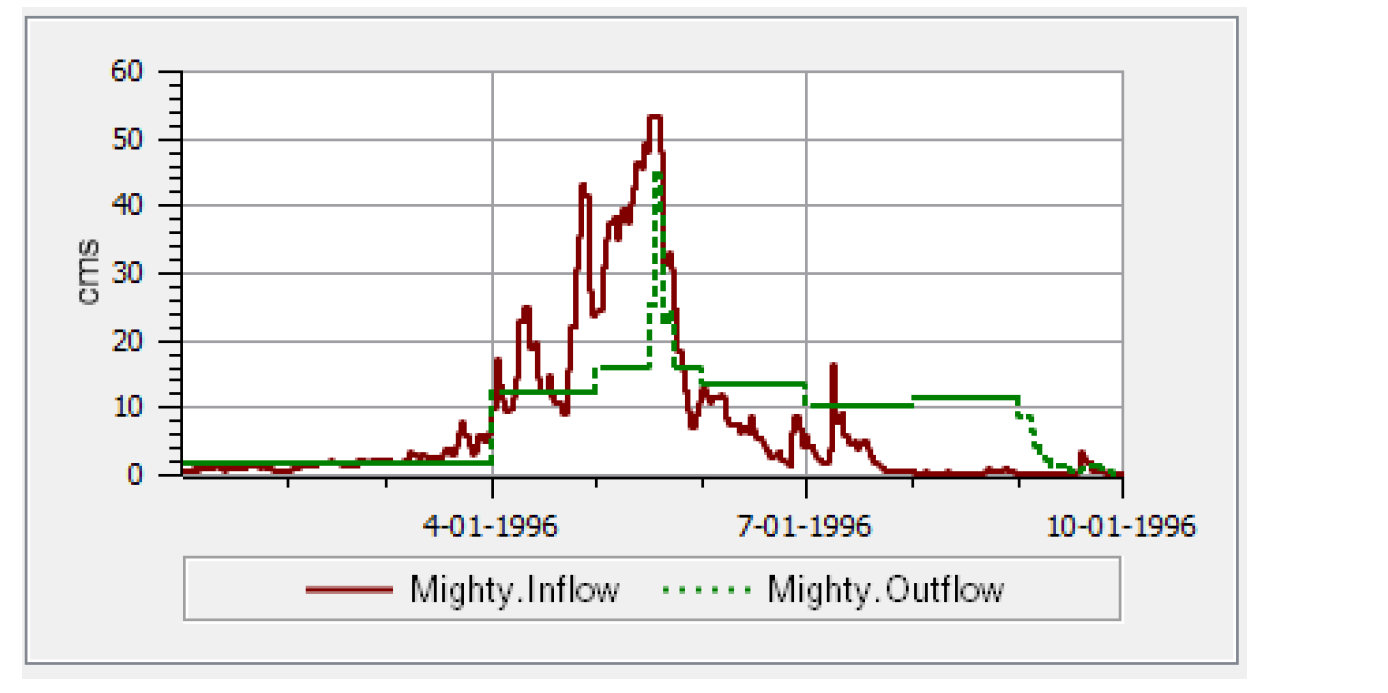
The displayed time range of the plot is initially taken from the setting in the axis defaults. To view or modify the setting, in any Plot Dialog, select the Edit menu’s Configuration Defaults item (see “Configuration Defaults”). This brings up the Plot Defaults dialog. In the Plot Dialog Settings dialog, select Default Axis Configuration. This displays the Axis Default Configuration Settings dialog. To specify the initial time range shown, select the desired start and end range of the plot. See “Time Series Axis” for descriptions of the options.
Scalar Curves
A Scalar Curve plots a single value from a Scalar Slot on a time series plot. Usually, the x-axis is time and the y-axis is the value. The only exception is if the scalar slot has the datetime unit type. In which case, the scalar curve is plotted as a vertical line. Figure 2.9 shows two elevation scalar slots plotted as horizontal lines along with one datetime scalar slot plotted as a vertical line.
Figure 2.9
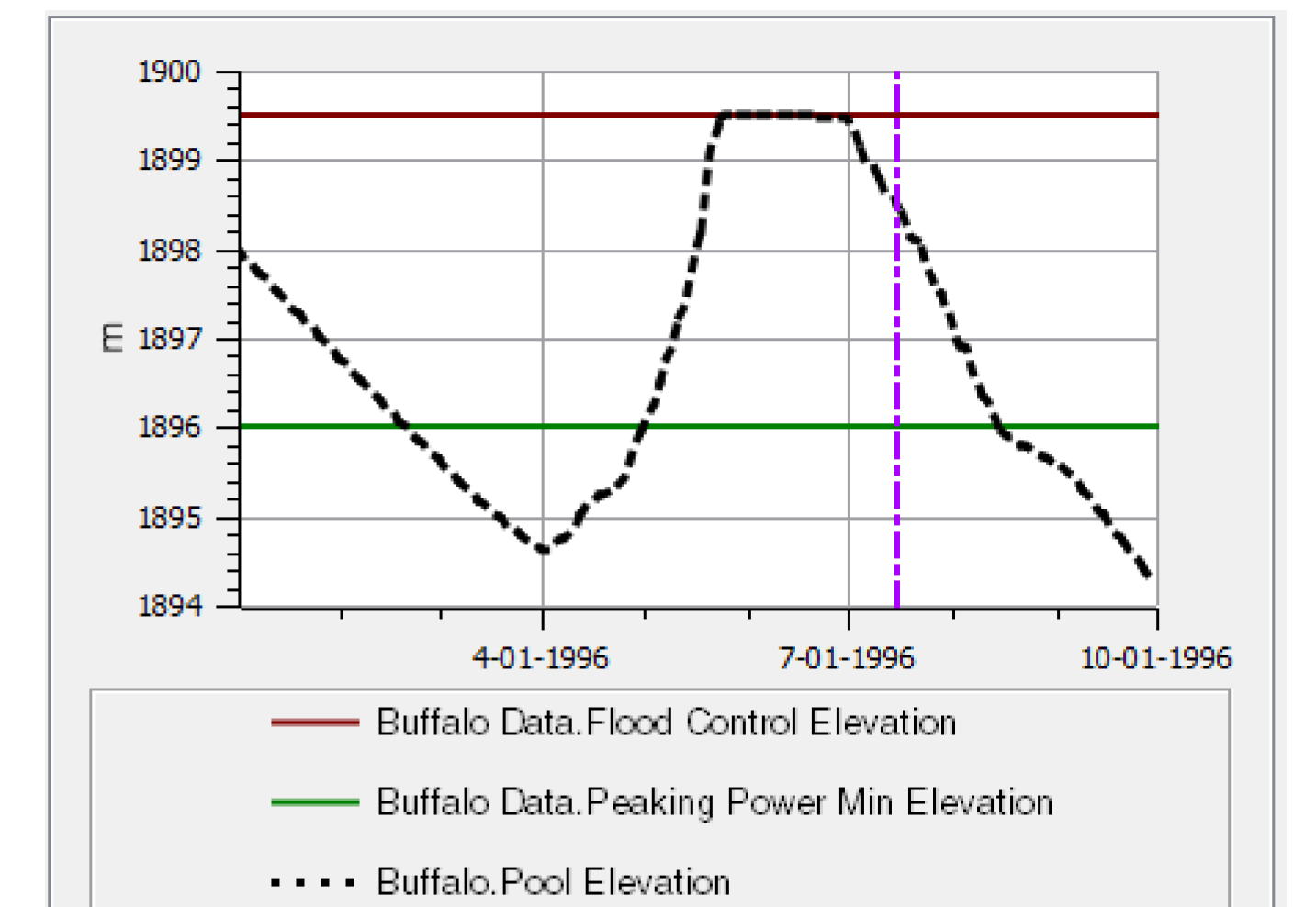
Table Curves
A table curve plots two sets of data from a table slot. Multiple table curves can be shown on one plot using one or more sets of axes. Figure 2.10 is a plot with two table curves and two y-axes.
Figure 2.10
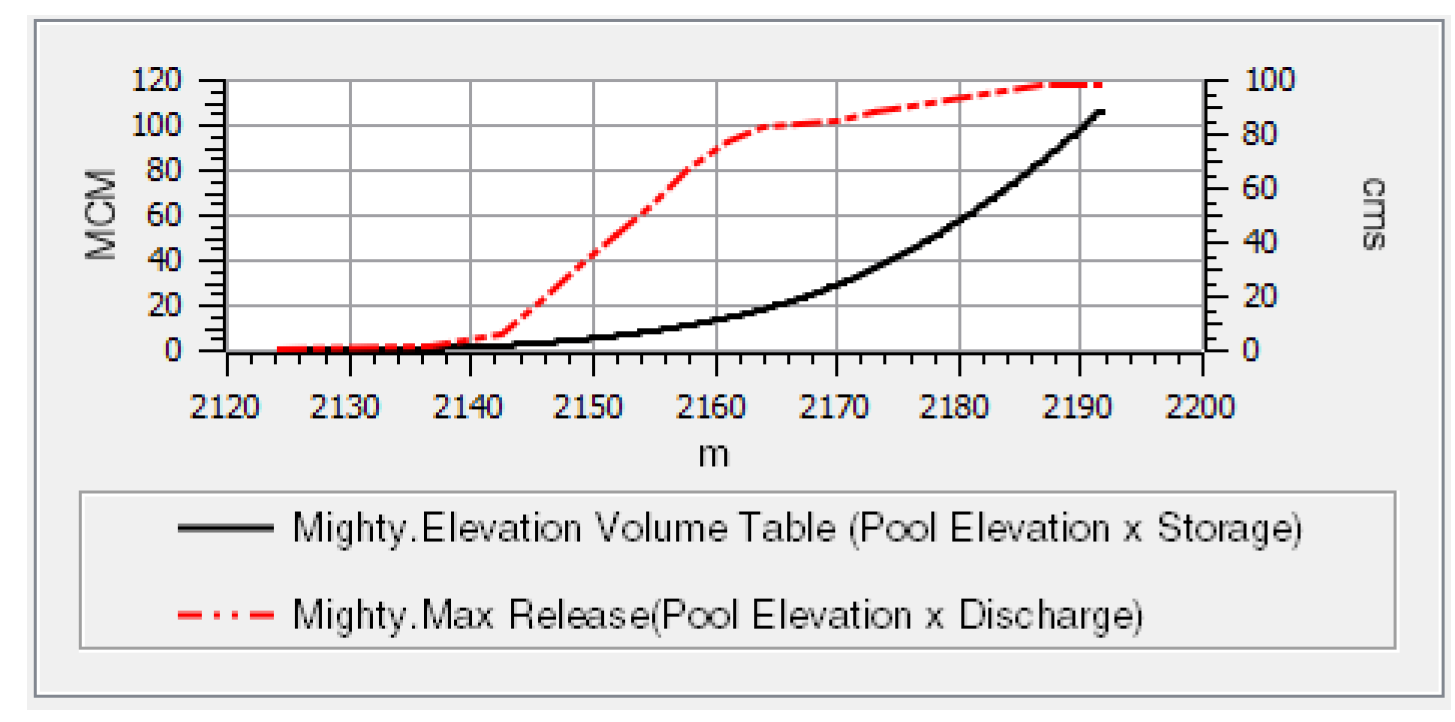
When plotting a Table Slot with more than two columns, the user has the opportunity to pick particular columns for the X and Y axes.
When plotting a two-column Table Slot, the numeric values from the first column are plotted along the horizontal (“X”) axis, and the values from the second column are plotted along the vertical (“Y”) axis, by default. See Figure 2.11. This can be changed within the configuration. The default configuration is often not ideal for elevation plots where the length unit would more naturally be on the Y axis. To override this, use the Two-Column Table Slot: Plot Axes Assignment Override checkbox in the defaults described in the remainder of this section.
Figure 2.11
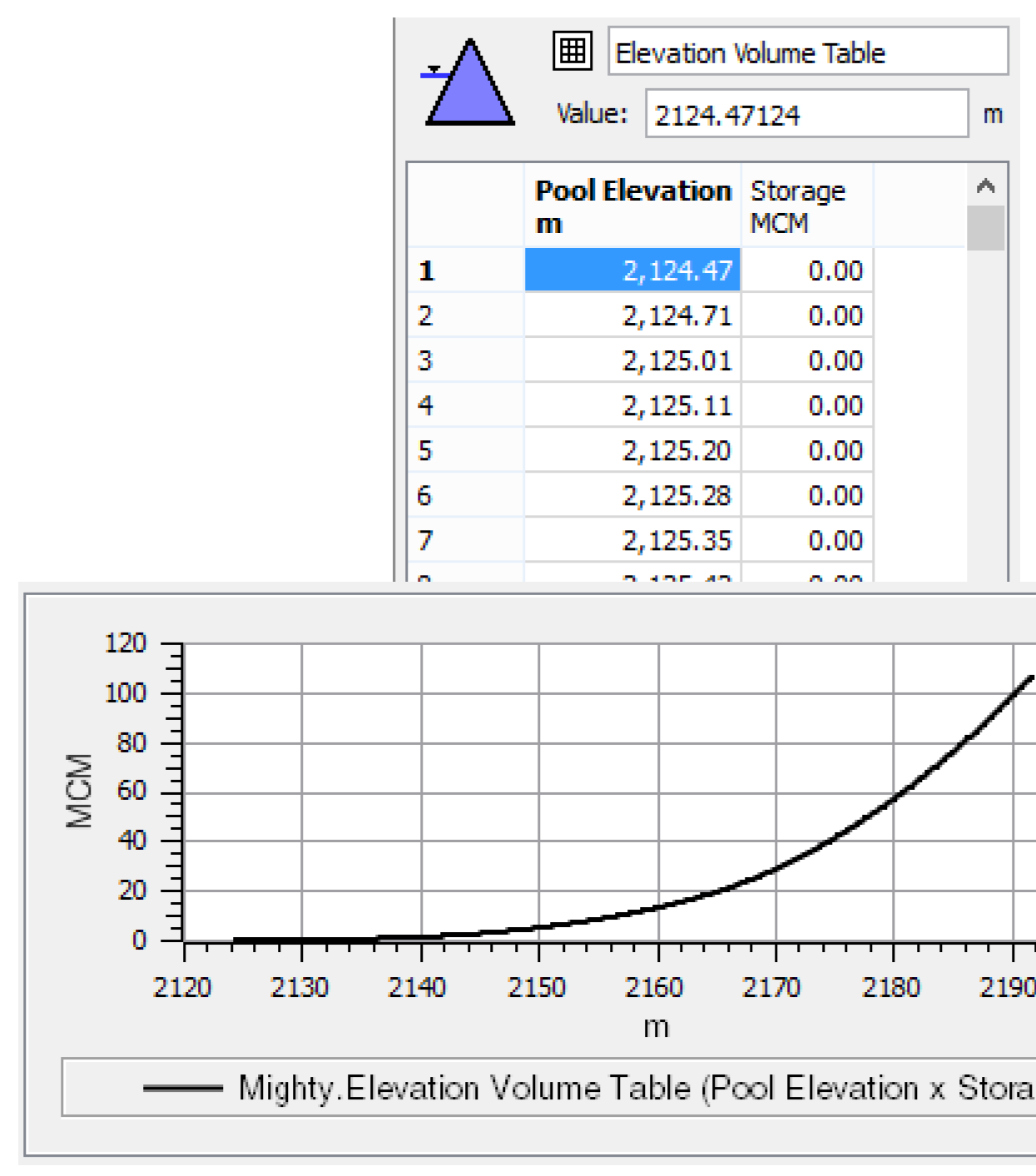
To view or modify this setting, in any Plot Page Editor, select Edit, then Configuration Defaults item (see “Configuration Defaults”). This brings up the Plot Defaults dialog. Select Default Axis Configuration. This brings up the Axis Default Configuration Settings dialog.
The setting is represented by the Override checkbox in Figure 2.12.
Figure 2.12
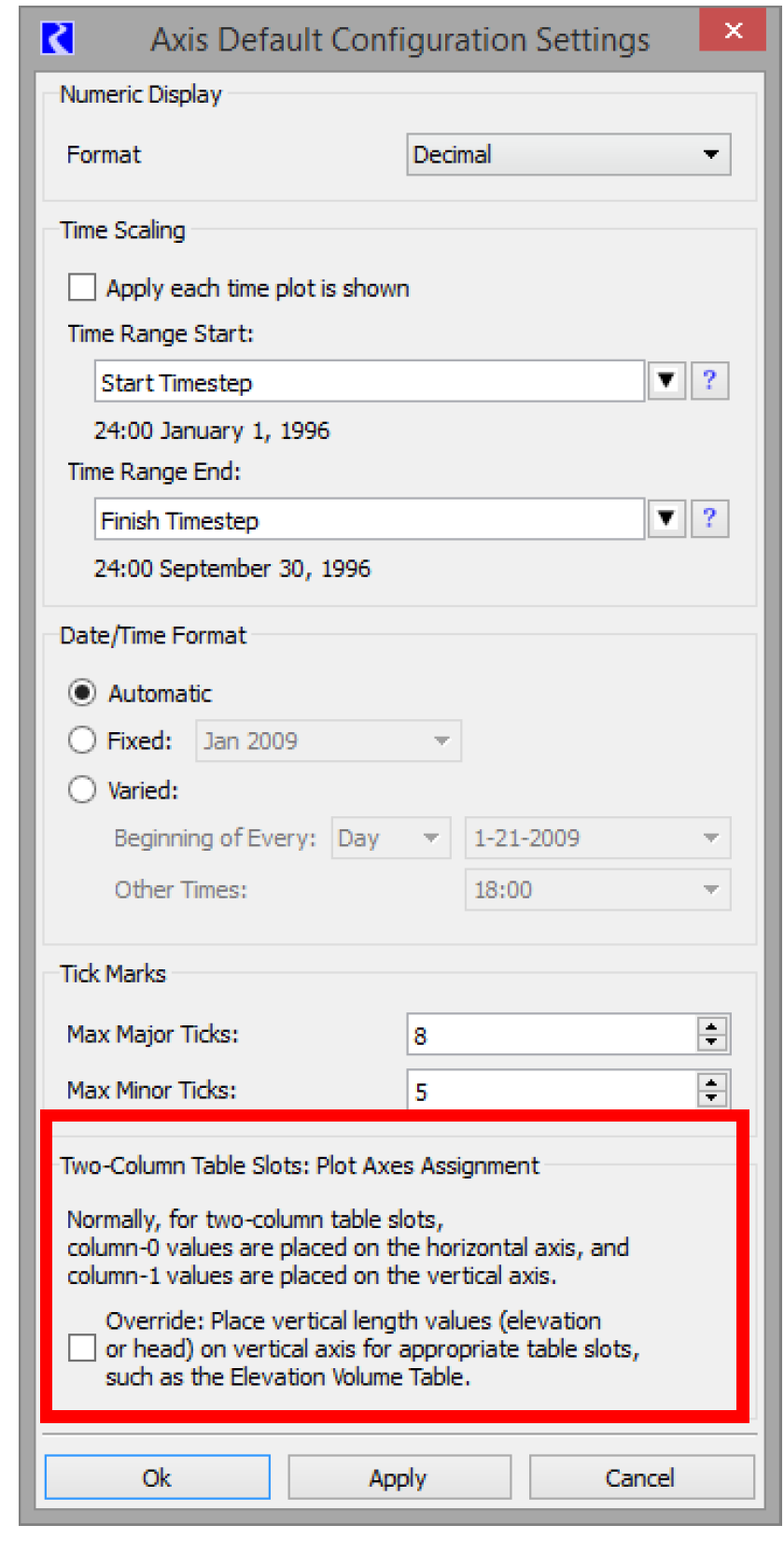
This setting is associated with the RiverWare model file rather than with user-login based configuration.
Note: This differs from other defaults related to plot configuration—these are generally stored as user-login based configurations.
The automatic switching of plot axes is applied at the time of creation of the plot -- so changing the setting of this toggle does not effect plots already created and saved with a RiverWare model file.
When the toggle is checked and a new plot is created, the standard mapping of two-column Table Slot columns to the plot axes is reversed on certain Table Slots. The plot axes reversal will occur if the following criteria are true:
• Column 0 is determined to be a “vertical distance”, and
• Column 1 is determined to NOT be a “vertical distance”
A Table Slot column entity is regarded as a “vertical distance” if both of these are true:
• The unit type of the column is LENGTH, and
• The column label is blank OR the column label contains the substring “ELEV” or “HEAD”, in either upper case, lower case or mixed case.
When these conditions are met, the plot will be created with reversed axes. In Figure 2.13, the second image depicts an axes reversal of the plot on the left as a result of this setting.
Figure 2.13

Table Contour Curves
A table contour curve is used to plot a three dimensional table. Figure 2.14 is an example of a table contour curve representing the headwater backwater, storage curve. Each curve represents a given Headwater.
Figure 2.14
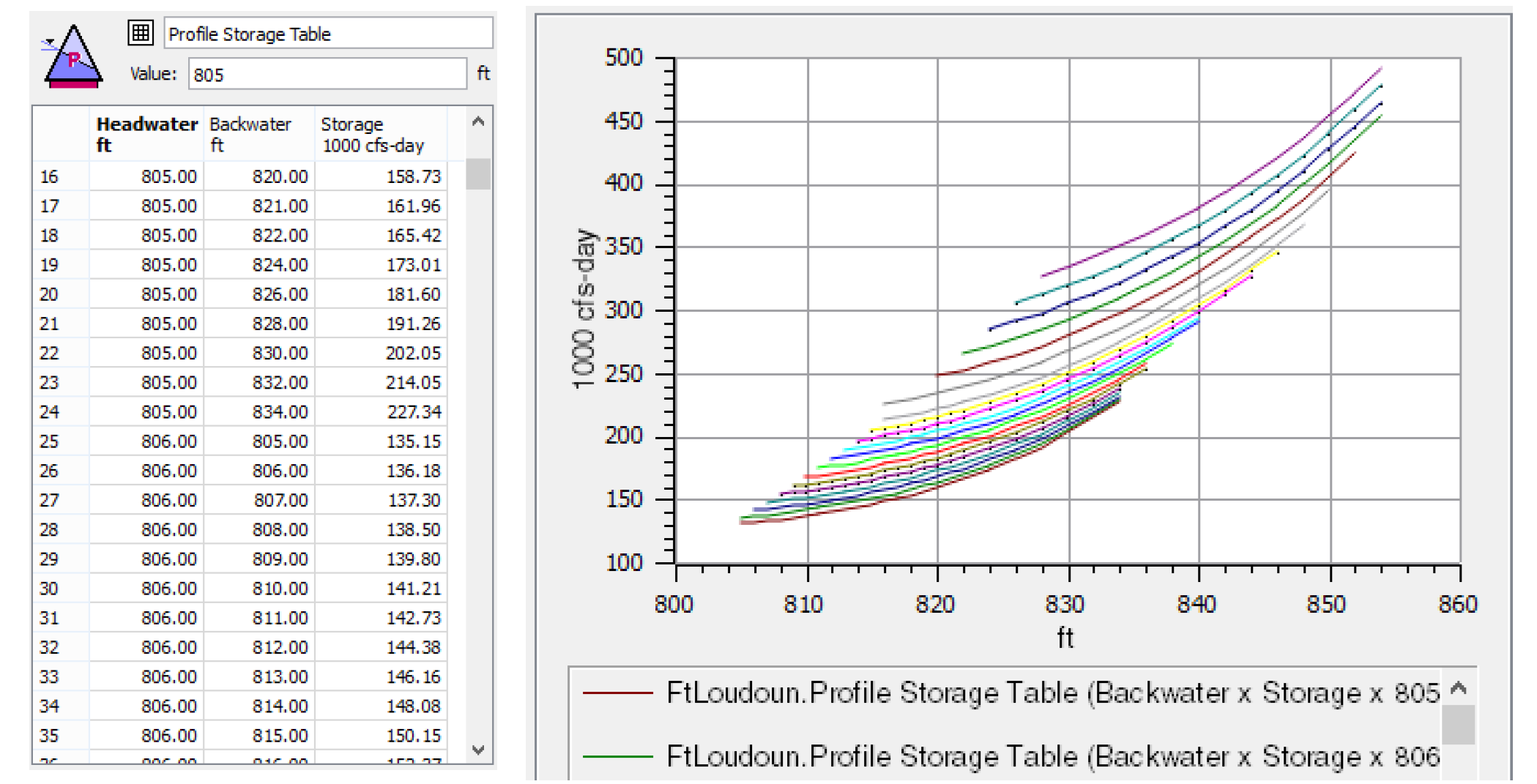
Periodic Curves
A periodic curve is used to plot a column of a periodic slot (y-axis) versus the time on the x-axis. The user is able to specify the column to plot. The curve is shown for whatever time range is plotted. If there are not other plots on the curve, it defaults to the run length. Select Scale to Specified  to enter your desired range of dates.
to enter your desired range of dates.
 to enter your desired range of dates.
to enter your desired range of dates. Figure 2.15
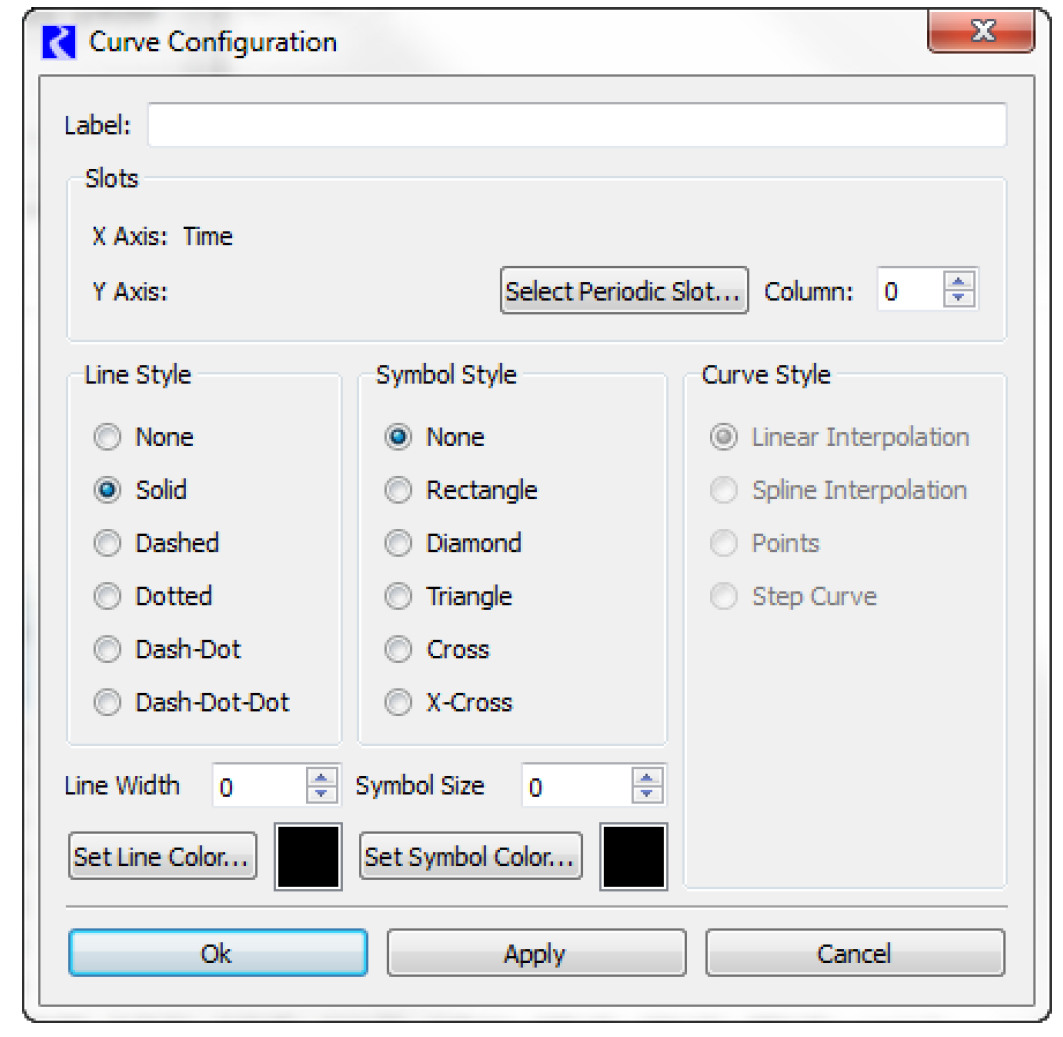
Figure 2.16 is a plot of one of the levels from an operating level table. The curve repeats, showing the periodic nature.
Figure 2.16
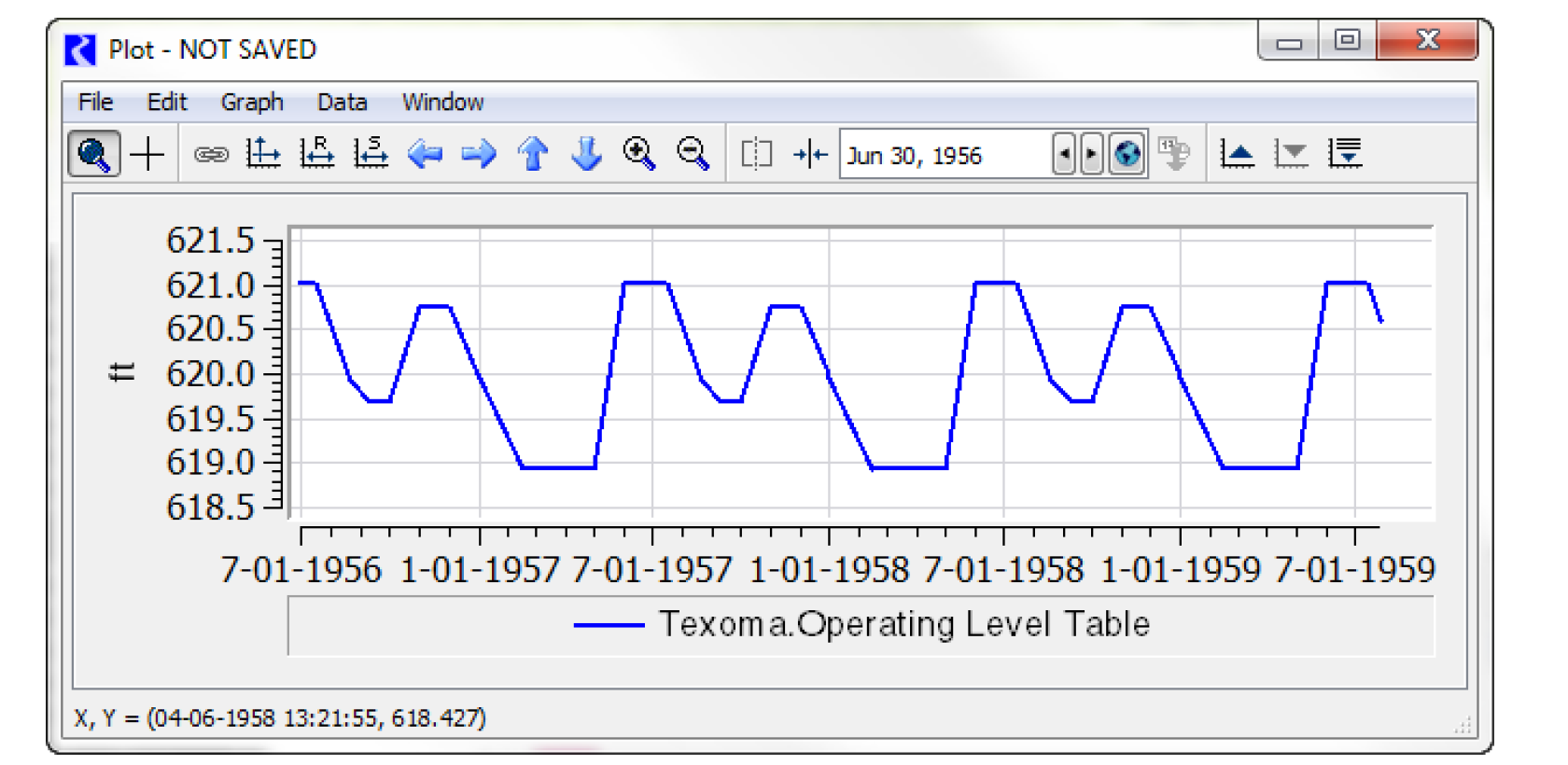
Parametric Curves
A parametric curve is used to plot one set of series data against another set of series data. The user selects a series slot for the x-axis and another series slot for the y-axis. In Figure 2.17, Inflow is plotted against Outflow to see if there is any relationship between the two.
Figure 2.17
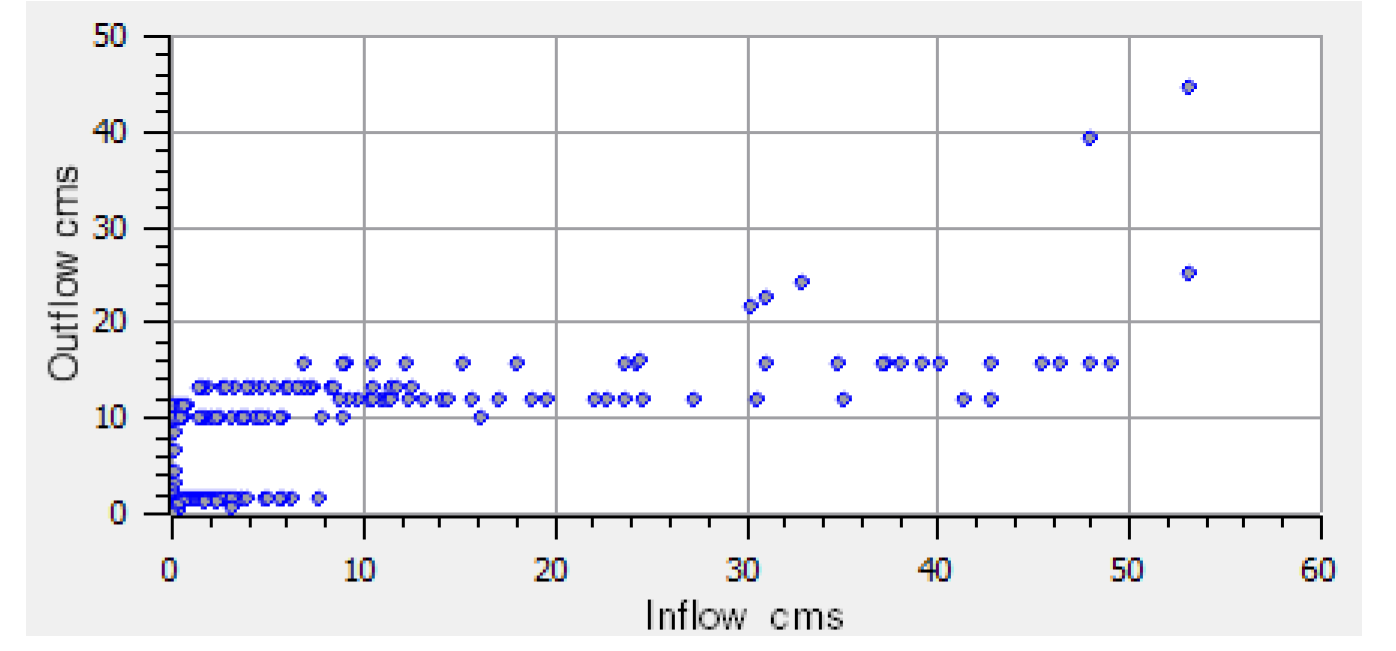
Adding Associated Snapshot Curves
Snapshots are way to preserve results between runs; see “Snapshots” in Output Utilities and Data Visualization for details. For comparison, it is useful to plot both the slot and one or more of its snapshots. The plotting utility allows you to quickly add curves for the associated snapshots. Given a plot that contains curves for a slot of interest, there are the following ways to add curves for the associated snapshots from the Plot Editor.
• Right-click the legend for the slot and select Add Associated Snapshot Curve and then select the desired snapshots. In this case, only the snapshots of the given slot are shown.
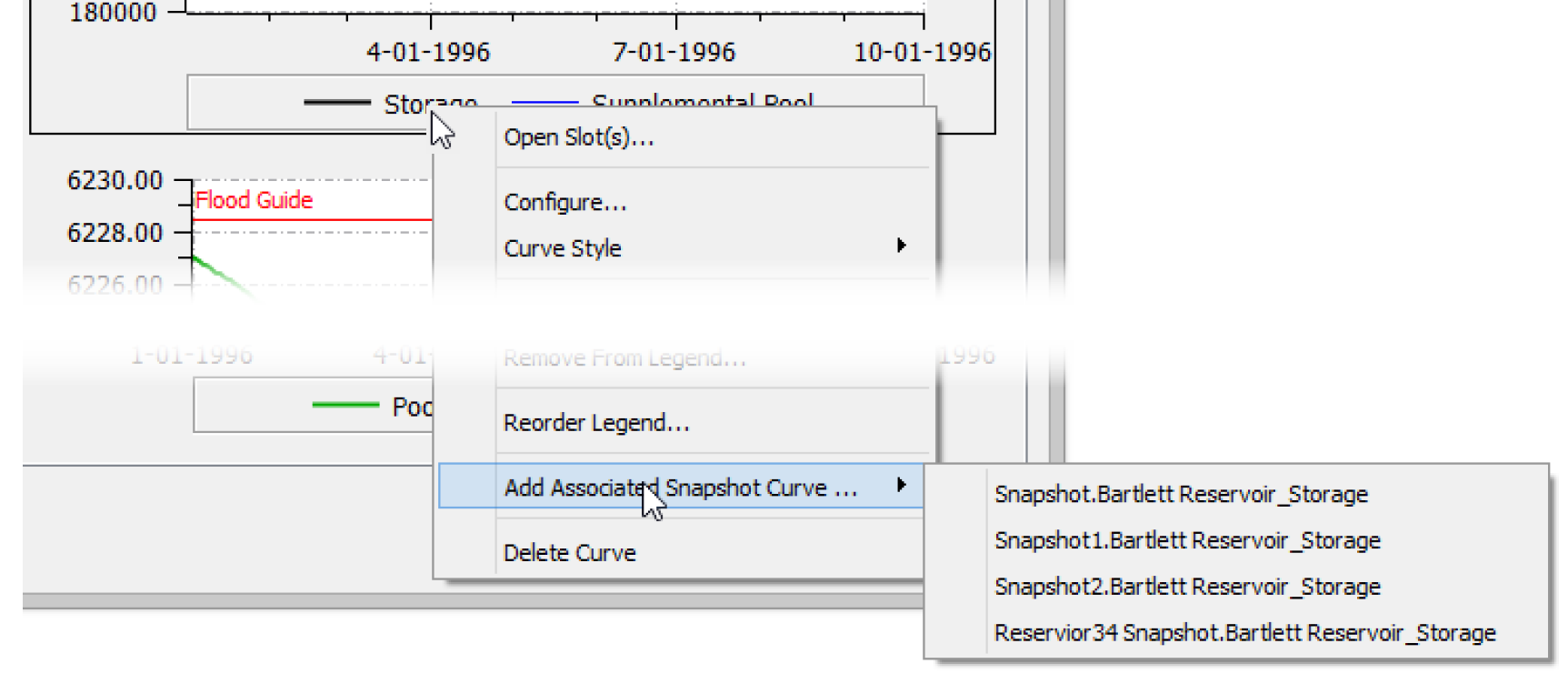
• Select Add Curve and select Add Associated Snapshot Curve and then select the desired snapshot and slots. In this case, snapshots of all slots on the selected plot are shown in the menu.
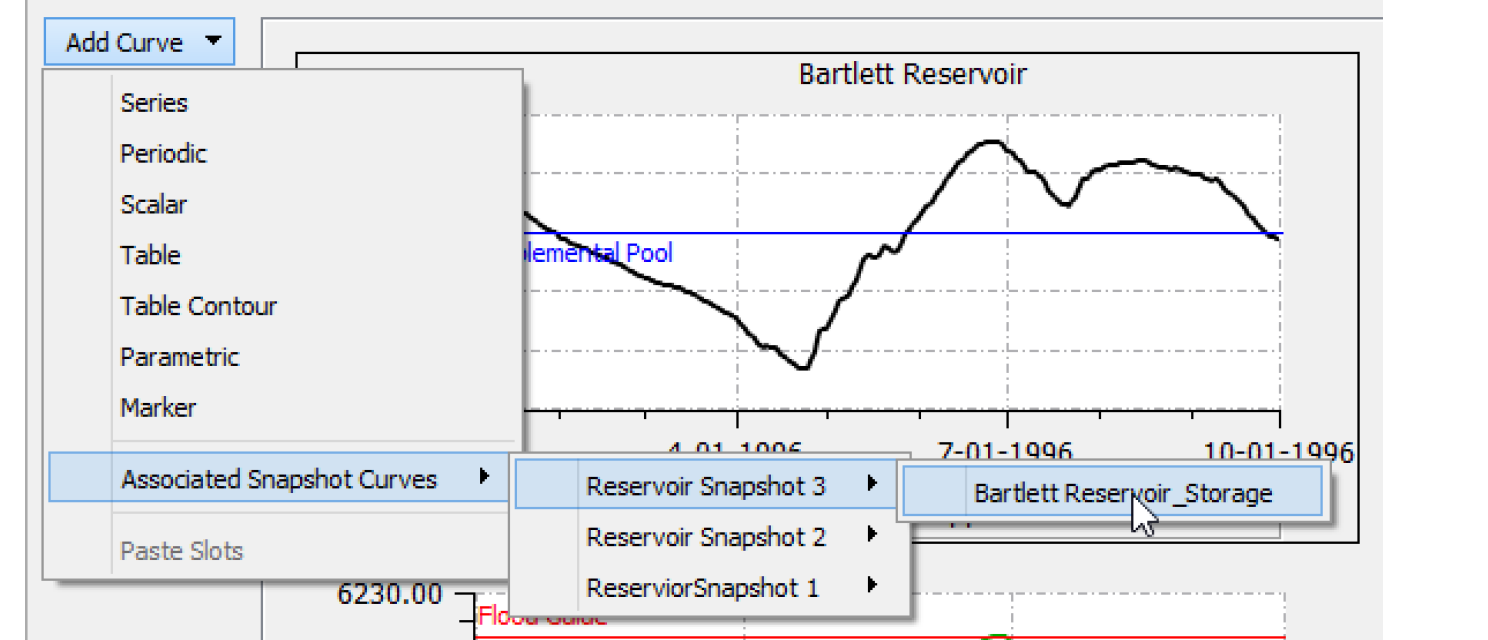
• Right-click the plot area (or use the Data menu) and select Add Associated Snapshot Curve and then select the desired snapshot slots. In this case the snapshots of all slots on the selected plot are shown.
In all cases, the Add Associated Snapshot Curve only is shown when there are snapshots of the plotted slot and there is not already a curve for that slot. Once added, the curves of snapshot slots are no different than other curves. The labels are SnapshotName.OrginalObject_Slot.
Configuring Multiple Plots and Curves
The Configure Multiple Plots and Curves dialog centralizes editing controls into a single editor. Most plot settings for the optional nine separate plots within a plot page are editable within the dialog. The user can select multiple items within a plot page, e.g. curves and markers, and apply selected settings to those items in a single operation. The dialog is shown in Figure 2.18.
Figure 2.18
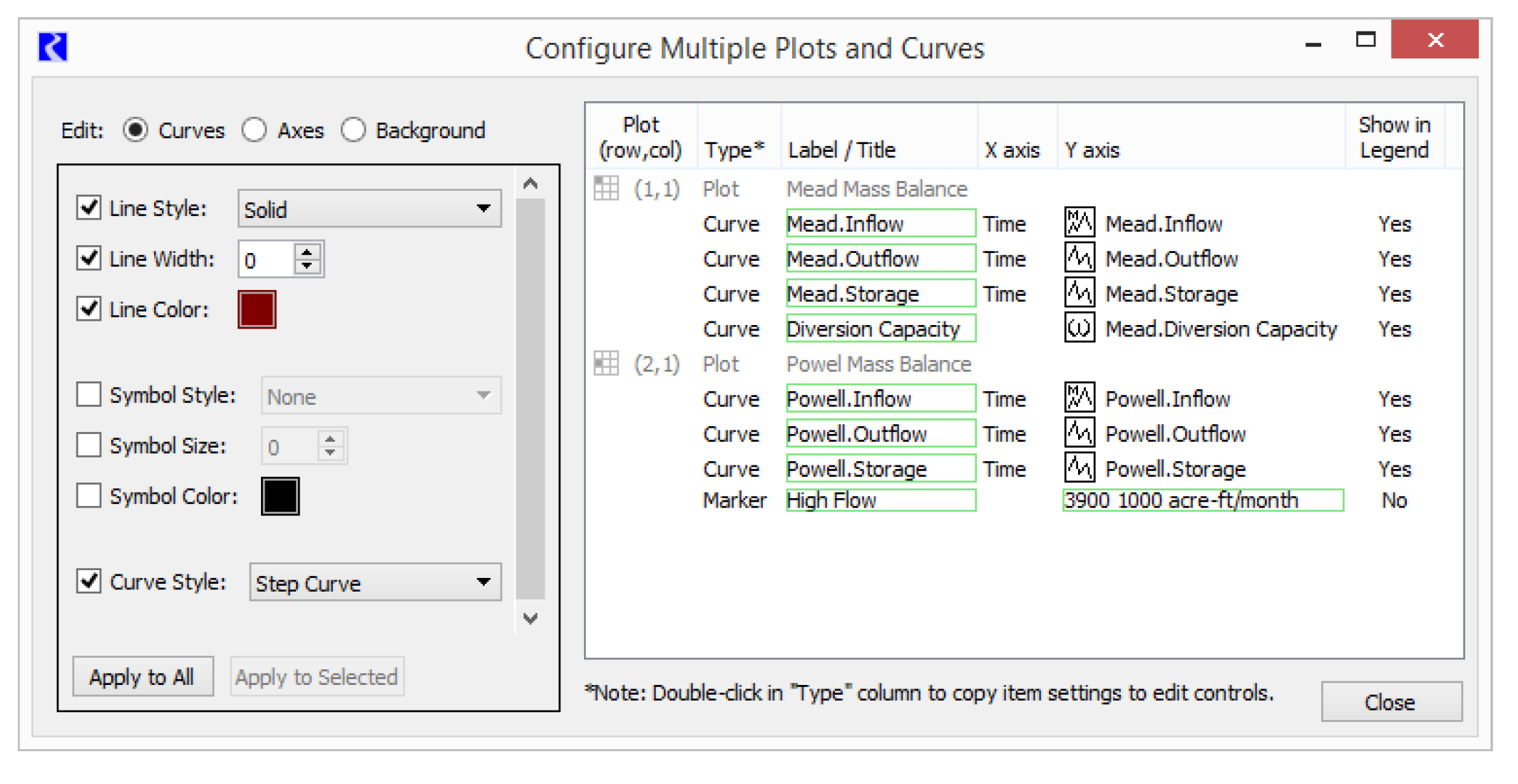
Accessing the Configure Multiple Plots and Curves Dialog
The Configure Multiple Plots and Curves dialog is accessible from the Plot Page Editor dialog via the Edit menu operation and the Multiple configuration. See Figure 2.19.
• Select Edit, then Configure Multiple Plots and Curves from the menu bar of the Plot Page Editor.
• Select Multiple on the left side of the Plot Page Editor dialog.
Figure 2.19
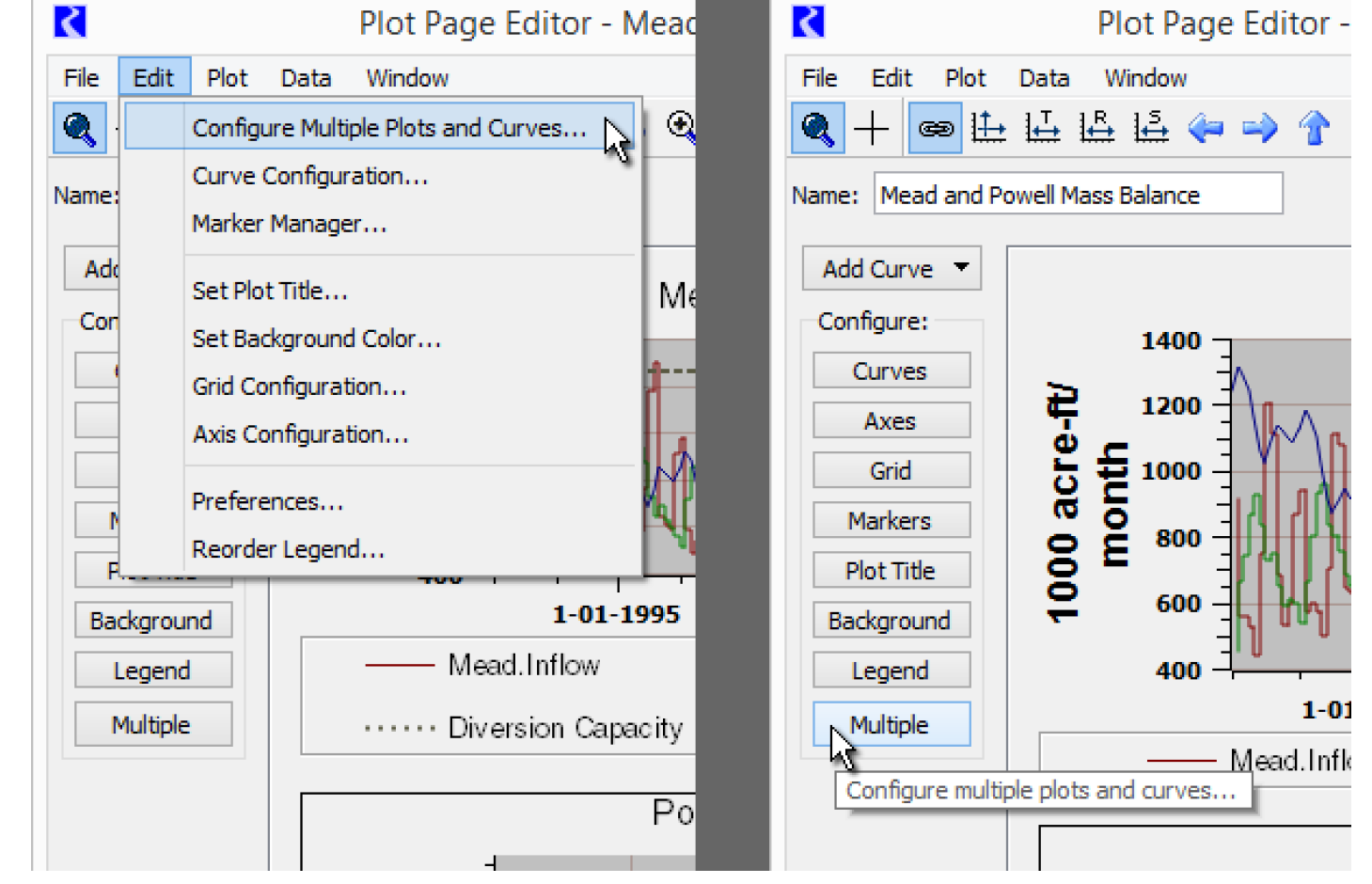
Tour of the Configure Multiple Plots and Curves Dialog
This dialog has three major panels as follows and noted in Figure 2.21.
• Edit modes for Curves, Axes, and Background
• Setting Editing Controls that provides controls based on the mode
• Plot Item Table with items for plots, curves and markers.
Figure 2.20
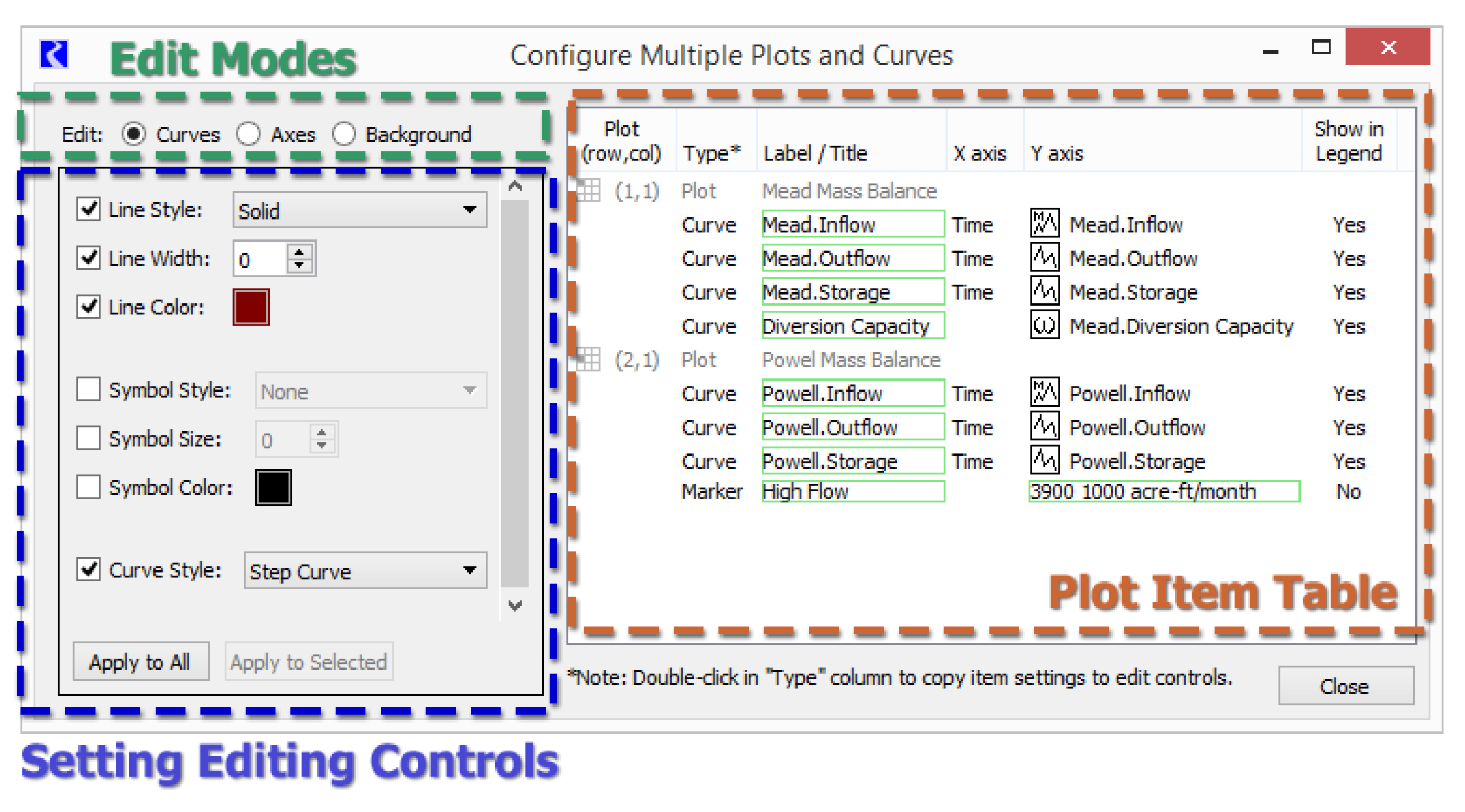
Directly editable cells within the plot item table are indicated with a green border. Double-clicking such cells starts an edit. These are typically used for editing labels, titles, and marker values.
Figure 2.21

Selecting Apply to Selected or Apply to Alls applies the checked or enabled settings in the left panel to the selected (or all) items selected in the right panel.
Note: Edits made to this dialog are applied to the plot page being edited in the Plot Editor Dialog. In that dialog, you can either accept those changes (OK or Apply) or Cancel those changes.
Curve and Marker Editing
In Curves edit mode, the curve and marker items within the plot item list are active. Double-clicking an item either starts an in-cell edit within the selected cell or copies that curve or marker's setting values to the editing controls panel. Curves' and markers' label text and markers' values can be directly edited.
Figure 2.22
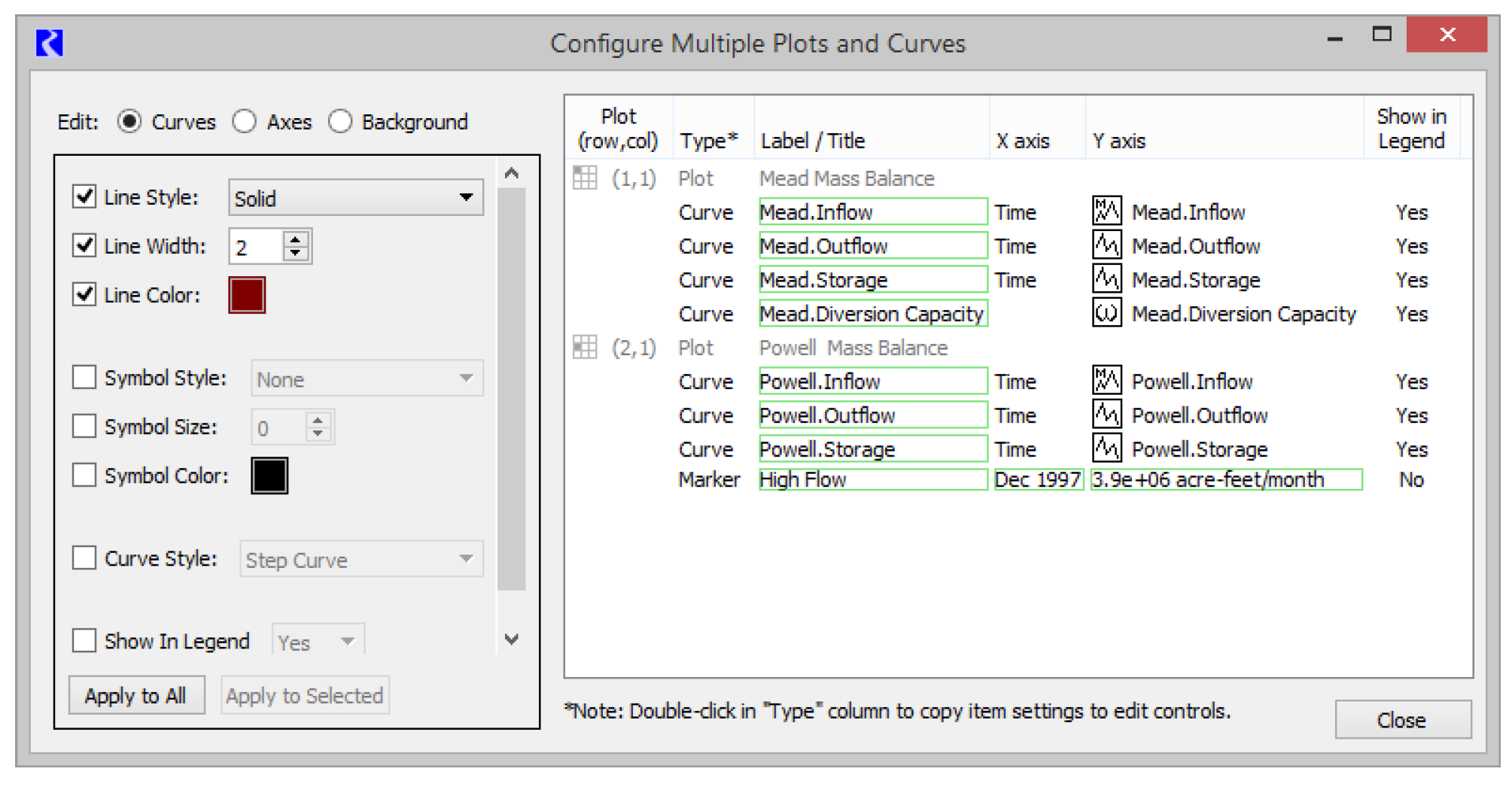
All of the setting operations provided in the Curve Configuration dialog are provided in the Configure Multiple Plots and Curves dialog. See “Curve Configuration” for details.
Various operations for curves and markers are supported with a context (right-click) menu:
• Edit Label -- initiates an edit in the Label / Title column. Double click a label to edit, as well.
• Copy Setting to Edit Controls -- copies the values of the selected item to the Setting Editing Controls panel. This is the same as double-clicking a non-editable cell.
• Copy Slots -- copies the selected plot items' slots to the RiverWare slot clipboard. The full names of those slots are also copied to the system clipboard.
• Open Slot -- shows the Open Slot Dialog for the selected slot.
• Select Slot -- shows the general slot selector to replace a curve's slot with a different slot. Only a slot of the same type (e.g. Series Slot) and unit type (e.g. Flow) can be used.
Note: Current support for marker editing is limited to the settings that are also available for curves. This includes all setting operations provided by the Marker Configuration dialog and the Plot Marker Manager. See “Marker Configuration” for details. The following edits are not yet supported:
• Marker Type: Horizontal / Vertical / Cross
• Label Alignment: Left, Center, Right / Top, Center, Bottom
• Axis Assignment: Lower/Upper X Axis, Left/Right Y Axis.
Figure 2.23
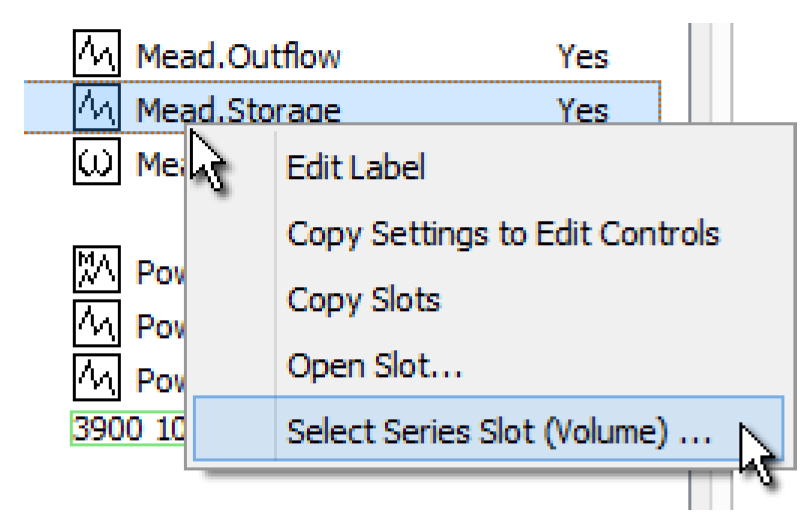
Axis Editing
In the Axes edit mode, the plot items (not curve and marker items) within the plot item table are enabled for selection.
Select which of the four axes are to be modified (Left Y, Lower X, etc) among the selected plots.
Only those settings appropriate for the selected axis are presented. I.e. DateTime axes support different settings than numeric axes.
All setting operations supported in the Axis Configuration dialog are supported in the Configure Multiple Plots and Curves dialog. See “Axis Configuration” for details.
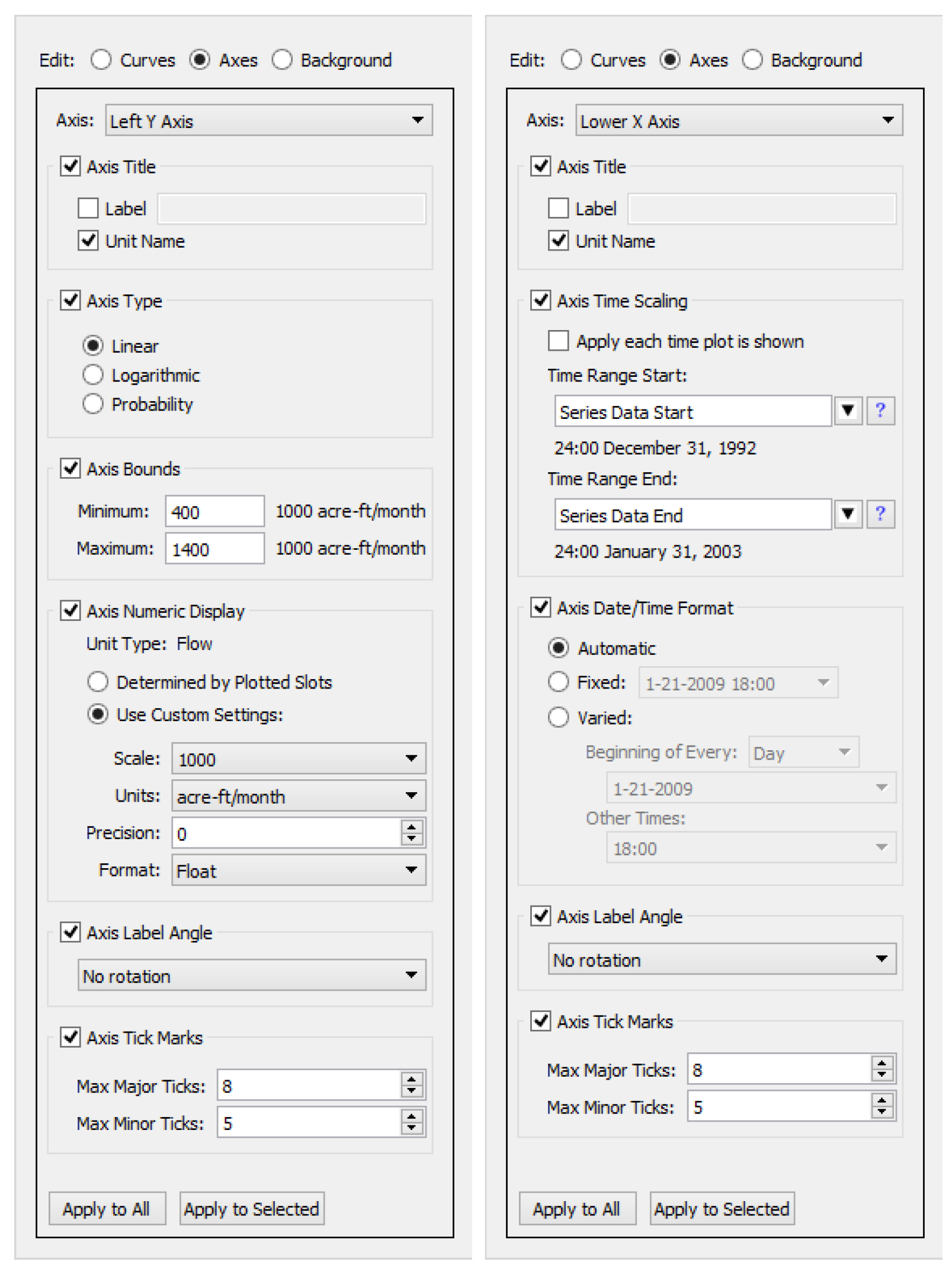
Background Editing—Background Color and Plot Grid
As with Axes edit mode (see “Axis Editing”), in Background edit mode, the plot items (not curve and marker items) within the plot item table are enabled for selection. Changes to plot background color and grid configuration can be applied to the selected plots, or to all plots in the plot page.
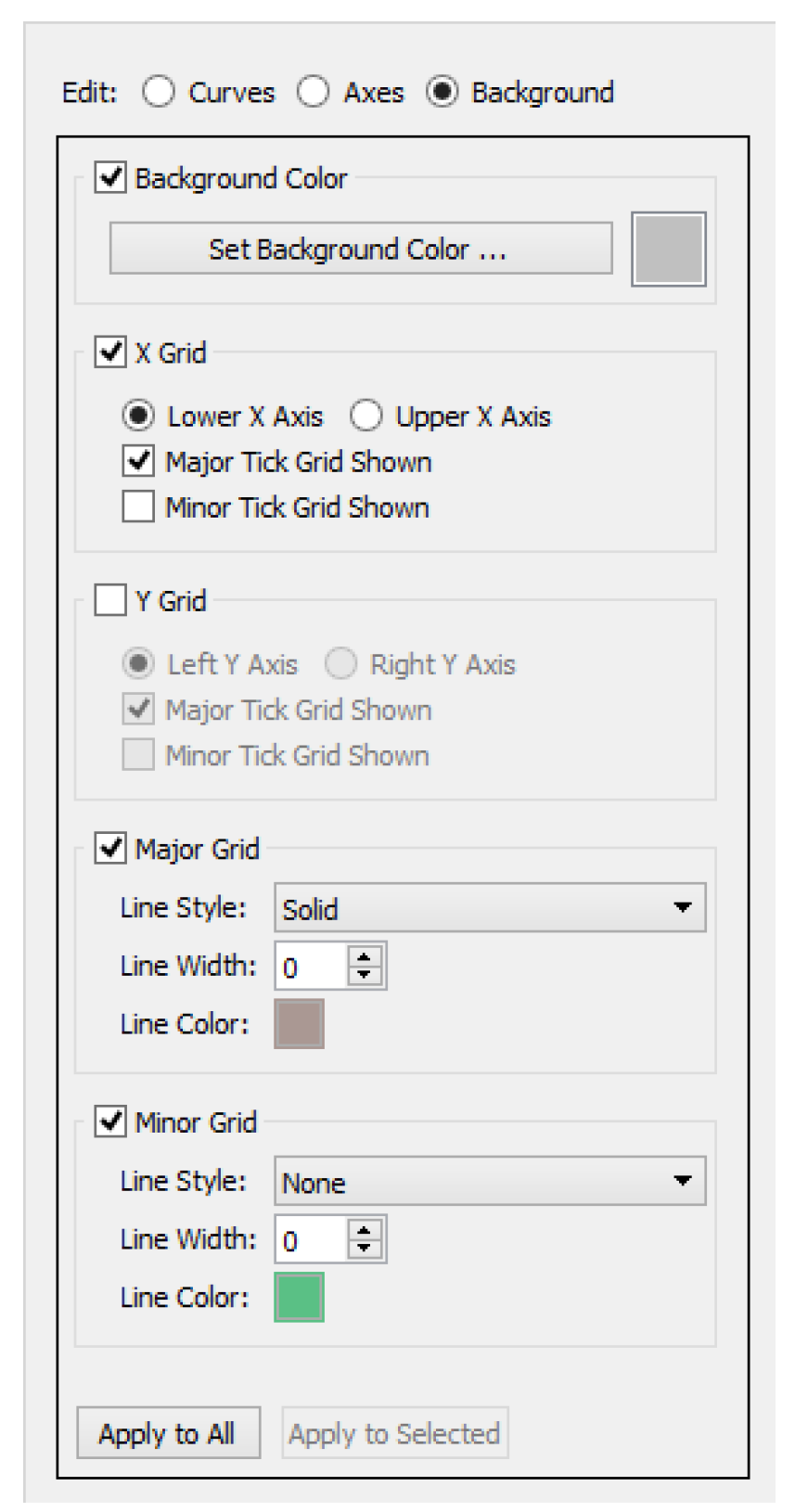
All setting operations supported in the Grid Configuration dialog are supported in the Configure Multiple Plots and Curves dialog. See “Grid Configuration” for details.
Plot Page
Once a Plot Page has been configured in the Plot Page Editor, it can be viewed in the Plot Page dialog. Use of the Plot Page dialog is described in this section.
Accessing the Plot Page
The Plot Page dialog can be accessed in the following ways:
• From the main workspace, select Utilities, then Plot Page or select Plotting 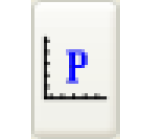 .
.
 .
. If there are no pre-configured plots saved in the model, this will open the Plot Page Editor. If there are pre-configured plots already saved in the model file, this will open the Plot Page dialog with the most recently selected plot displayed.
• From the Plot Page Editor, select Generate in the bottom left corner to open the Plot Page dialog for the Plot Page currently open in the Editor.
• From an already open Plot Page dialog, select File, then Open from the list of Plot Pages saved in the model file to open a Plot Page dialog displaying that plot.
• From the Output Manager, select an existing Plot Page in the list of output devices, and then select Generate. This will open a Plot Page dialog displaying that plot. Alternatively, select Generate, then Generate Selected Outputs from the menu bar.
Using the Plot Page
Most of the tools and actions used in the Plot Page dialog are the same as those used in the Plot Page Editor. See “Editing a Plot Page” for details.
Components of the Plot Page dialog that are not in the Plot Page Editor are the Plot Page List, and the New and Edits.
Select Plot Page List
The right portion of the Plot Page has controls to step through saved Plot Pages. Select any of the items to open that Plot Page in the current window. Right-click any item to add the slots in that list to an SCT. If the Select Plot Page List is not shown, select the  button, or select Window, then Show Plot Page Selection List.
button, or select Window, then Show Plot Page Selection List.
 button, or select Window, then Show Plot Page Selection List.
button, or select Window, then Show Plot Page Selection List.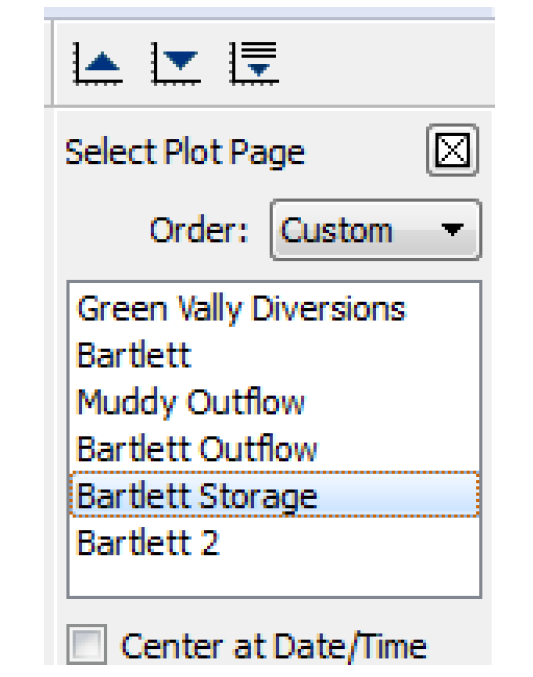
The buttons on the toolbar can also be used to navigate the list of plots or show the plot list. See Figure 2.24.
Figure 2.24
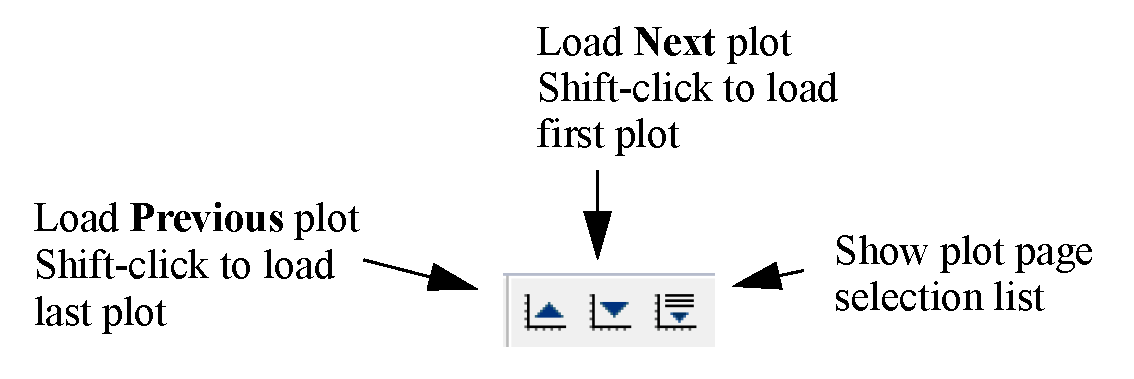
Select  to close the plot list.
to close the plot list.
 to close the plot list.
to close the plot list. The Plot Pages in the selection list are ordered using the Order menu, as follows:
• Custom: Use the custom order as defined by the user. See the third option for how to define this order.
• Name: The plot pages are sorted alphabetically by name.
• Define: This option takes the user to the Output Manager where a custom order can be defined. See “Sorting” for additional information.
Note: In the Plot Page list, only Plot Pages are shown, so only the relative order in the Output Manager is important. Other types of output devices can be intermixed as desired

Create New Plot Page
To create a new Plot Page from the Plot Page dialog, select New in the bottom right corner. This will open a blank Plot Page Editor.
Edit Plot Page
To edit the current Plot Page, select Edit in the bottom right corner. This will open the Plot Page Editor for the current Plot Page.
Plot Page Menus
Following is a description of each menu in the Plot Page dialog.
File Menu
The File drop-down menu offers options for opening a new Plot Page, exporting the Plot Page to a file and printing plot images. Following are descriptions of the available selections.
• Open: Selecting the Open menu item will show the Plot Page Selection list at the right of the Plot Page Dialog; see “Select Plot Page List”. If the Plot Page Selection list is already displayed, then the Open menu item will be disabled.
• Export Plot Page Configuration allows the selected Plot Page configuration to be exported to a file. Select or enter a desired file path and name in the resulting File Chooser dialog, and select Save. All Plot Page configuration information is saved to the file.
• Export Image allows saving of the image of a selected plot or all plots on the Plot Page to a graphics file. The graphics file can be in one of a number of image formats. Other options include the export image’s size (number of pixels) and resolution (low-medium-high). See “Printing and Exporting Plots” for additional information.
• Print Preview will show of preview of the plot as it would appear on the specified printer. See “Printing and Exporting Plots” for additional information.
• Print will send a selected plot or all plots on the plot page to your printer. See “Printing and Exporting Plots” for additional information.
Edit Menu
The Edit menu options to create a new Plot Page or edit the current Plot Page.
• Create New Plot will open a blank Plot Page Editor. This is the same as selecting New in the bottom right corner of the Plot Page.
• Edit Selected Plot will open the Plot Page Editor for the current Plot Page. This is the same as selecting Edit in the bottom right corner of the Plot Page.
• Copy Plot Image copies the plot or plot page as an image for pasting to a document or email. See “Copy Plot as an Image” for additional information.
Plot Menu
The options in the Plot menu are the same as for the Plot Page Editor, with the exception that there is no option to paste a plot into a Plot Page. See “Plot Menu” for details. A plot can only be pasted into a Plot Page Editor. (More generally, changes to the Plot Page configuration can only be made in the Plot Page Editor.)
Window Menu
The Window menu contains an option to show or hide the Plot Page Selection List. See “Select Plot Page List” for details.
Other options in the Window menu show or hide components of the tool bar.
Plot Page Navigation
Following are common actions used to navigate, scale, and otherwise view a plot in both the Plot Page and Plot Page Editor. Figure 2.25 shows a sample Plot Page Editor dialog.
Figure 2.25 Plot Page Editor dialog box
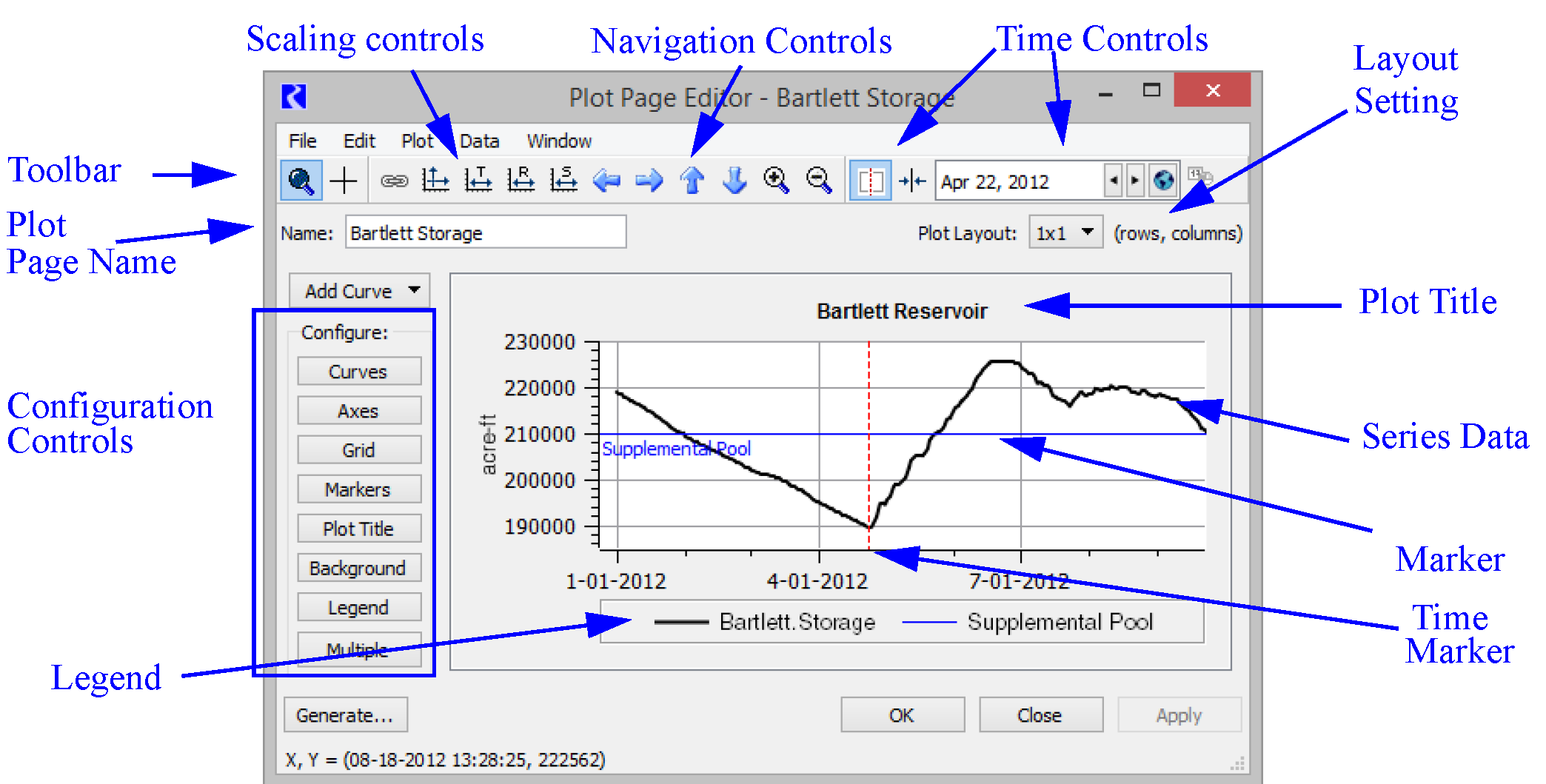
Toolbar Actions
Following is a description of the toolbar buttons. Use these buttons to scale, zoom, and navigate through the plot. These buttons apply for both the Plot Page Editor and the Plot Page dialog.
Button | Description |
|---|---|
Mouse Zoom/ Mouse Recenter 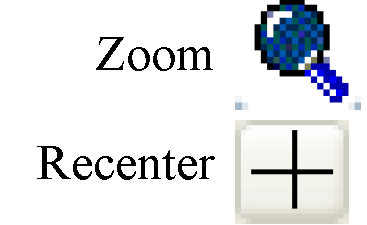 | The Zoom tool displays a magnifying glass cursor icon, which lets you select a zoom rectangle by click-and-dragging the mouse. The Recenter tool displays crosshairs as a mouse icon and causes the plot to be centered around the point at which the mouse is selected. |
Link Plots 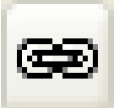 | If there is more than one plot in the Plot Page, the Link Plots tool is active, letting you do manipulation operations on all of the plots in unison (including AutoScale, the Shift Tools, the Zoom Tools, Date Spinner, and Date Center). |
Auto-Scale 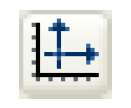 | The Auto-Scale feature scales and translates the plot(s) to include the entire range of data. |
Apply Configured Time Scaling 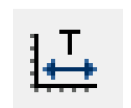 | The Apply Configured Time Scaling feature scales and translates the plot(s) to the range specified in the Axis Configuration. This can be a symbolic or absolute time range. In addition, you can configure a plot to always use this configured time range when opening the plot. See “Time Series Axis” for additional information. This operation does not affect the y axis scaling. |
Scale to Run Range 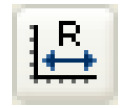 | The Scale to Run Range scales the x axis to the run range defined on the Run Control. It is available only for times series plots. The y axis display is not affected. |
Scale to Specified Range  | The Scale to Specified Range scales the plot(s) to a range that you specify in the dialog. This operation does not affect the y axis scaling. When the button is shift-selected, all open Plot Page dialogs are raised to the top and the time range is synchronized to the specified time range of the selected plot. 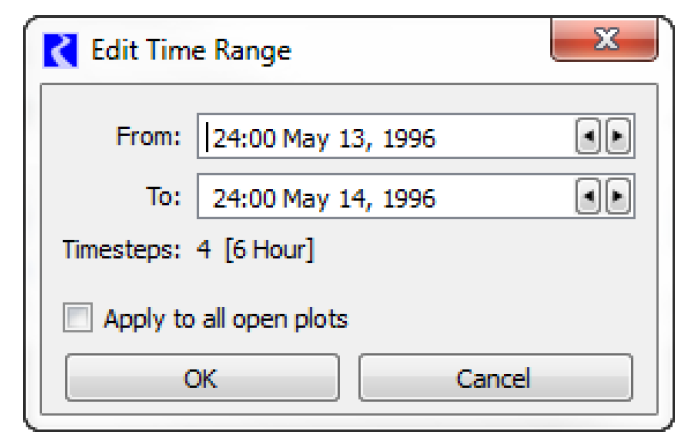 |
Zoom Tools 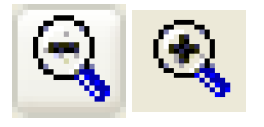 | The Zoom feature zooms in or out on the center of the plot dialog, on either the X, Y, or both axes. Use the middle mouse wheel to zoom in/out on either the plot area or independent axes. See “Mouse Button Actions” for additional information. |
Date Spinner  | The Date Spinner is used to scroll to a specified date. |
Date Center  | The Date Center icon is used in conjunction with the Date Spinner to center the plot on the specified date. |
Date Marker  | The Date Marker icon is used to show a red marker line at the specified date in the Date Spinner. This feature works in two ways. If the plot is showing the entire timeseries, i.e. it was auto-scaled using the Auto-scale  icon, the Date Marker will move to the specified date but the plot will not be re-centered. If the plot is not auto-scaled, i.e. it has been zoomed or panned, the Date Marker will center the plot on the specified date. icon, the Date Marker will move to the specified date but the plot will not be re-centered. If the plot is not auto-scaled, i.e. it has been zoomed or panned, the Date Marker will center the plot on the specified date. The line can be hidden or shown by selecting the button. The marker line will be shown on all linked plots, but not on unlinked plots. 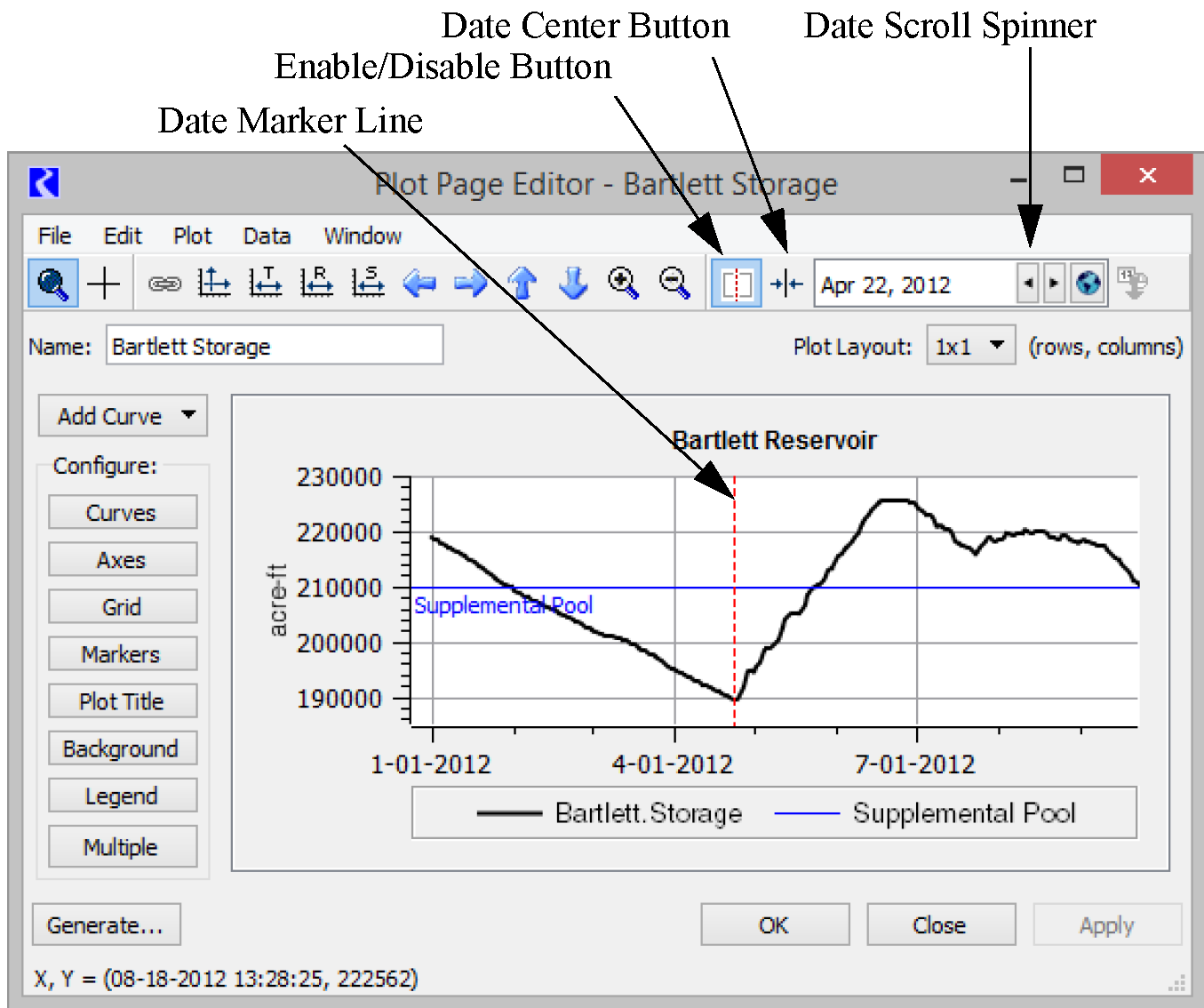 |
Sync Dates 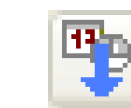 | The Sync Dates feature syncs the dates on all plots. If there is only one plot in the plot page, this function is not available. |
Legend | The legend shows the curves displayed in the plot. Select a curve name in the legend to temporarily hide that curve. Select again to show it The hidden/shown status is preserved within a RiverWare session but is not saved to the model file. All curves/markers are shown when the plot is first opened. Right-selecting the curve name will show a context menu with options to edit the curve configuration, remove from legend, reorder the legend, or to delete the curve.  |
Mouse Button Actions
There are three special operations provided by the middle mouse button and/or wheel:
Mouse Wheel Plot Zoom
While the cursor is in the main plot area, use the mouse wheel to zoom both axes. The plot will remain centered during zooming operations regardless of cursor position.
Single Axis Plot Zoom
When the cursor is positioned over an axis, use the mouse wheel to zoom the plot in or out along only that axis. This single axis zoom also supports zooming independent Left or Right Y axes and Top or Bottom X axes.
Plot Panning
While the cursor is in the main plot area, click the middle mouse button/wheel to pan the plot in any direction. During panning, the cursor changes to a closed-hand shape to indicate panning is in progress.
Note: On some devices, the middle button is the wheel itself while on others, there may be a middle button separate from the wheel.
Plotting Templates
Plot Templates allow you to create a Plot Page involving particular slots on particular objects and then generalize this Plot Page as a “Template”. You can then apply the Template to other objects and slots of the same type. This is useful when you have data that you wish to plot for many objects or slots.
For example, for a basin with 10 reservoirs, you may wish to view Storage and a guide curve, Outflow and flow targets, and Energy produced. You wish to view this exact same data in the same plotting format for each reservoir. Plot Templates allow you to create and configure one Plot Page, save that as a Template and then apply that to the other 9 reservoirs in the basin.
Another example, you might create a 3X1 Plot Page that has the following curves by plot:
• BigReservoir.Pool Elevation and BigDataObject.FloodGuide
• BigReservoir.Storage and DeepReservoir.Storage
• BigReservoir.Outflow
Turning this Plot Page into a Template will give you the ability to easily substitute reservoirs, for example, into the Template:
• SmallReservoir for BigReservoir
• ShallowReservoir for DeepReservoir
• SmallDataObject for BigDataObject
This could then create the 3X1 Plot Page that has the following curves by plot:
• SmallReservoir.Pool Elevation and SmallDataObject.FloodGuide
• SmallReservoir.Storage and ShallowReservoir.Storage
• SmallReservoir.Outflow
The three aspects of creating and using Plot Templates are illustrated in Figure 2.26 and described in the following sections.
Figure 2.26

Create and Configure a Base Plot Page
A Plot Template is created from an existing Plot Page. Thus, it is important to configure the Plot Page as desired before saving it as a Template. Make sure you have your colors, line widths, axis labels, axis precision, and titles correct. Once you save the Plot Page as a Template, you cannot change these settings in the Template itself. You can change any configuration setting in Plot Pages generated from the Template, but configuring it as desired in the first place, can save you time. Figure 2.27 is the original Plot Page used in the subsequent example screenshots.
Figure 2.27
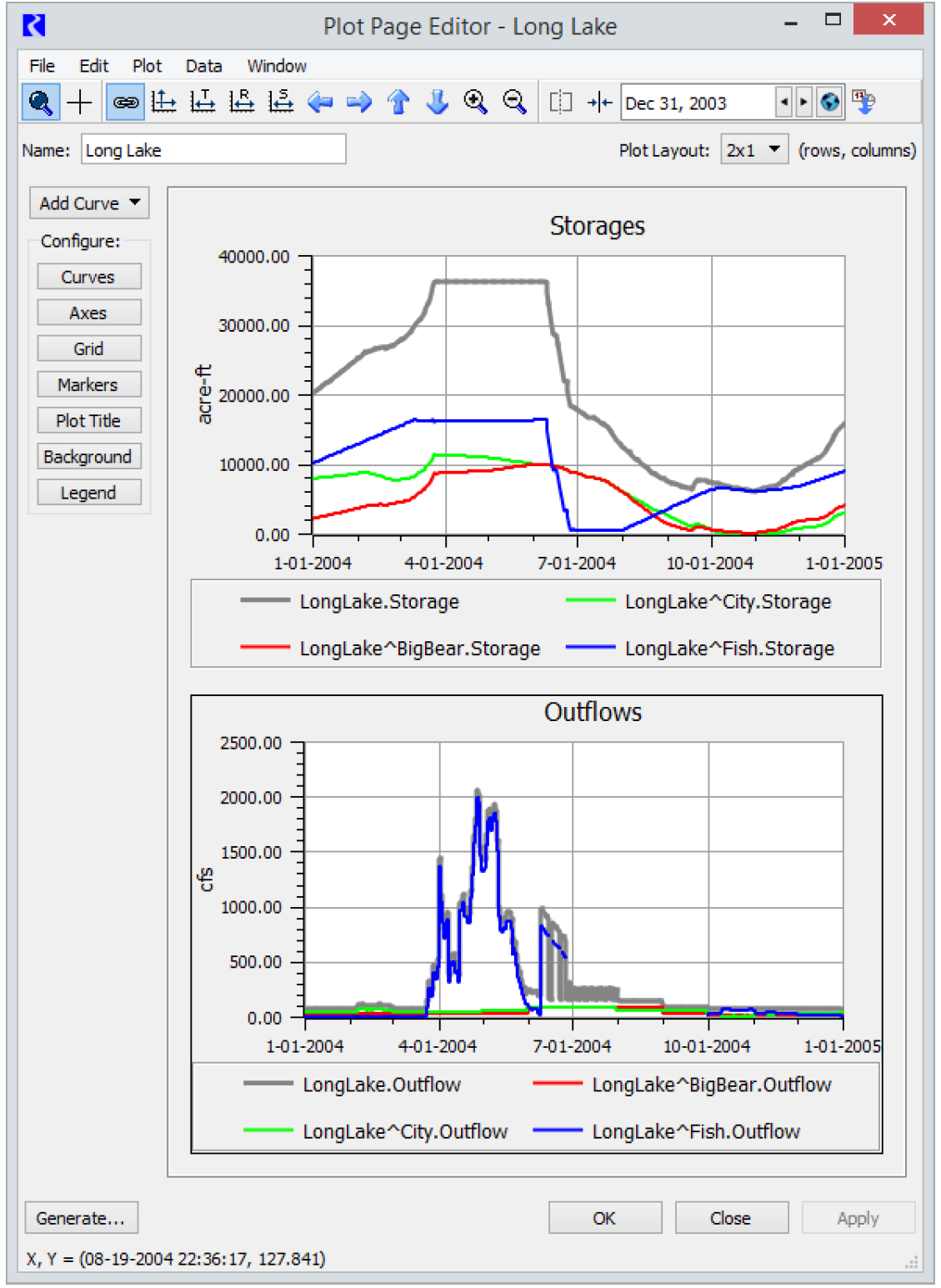
Save a Plot Page as a Template
Once a Plot Page is configured as desired, you can save it as a Template. From the Plot Page Editor, select: File, then Save As Template,
This opens the Save Plot Page as Plot Page Template dialog shown in Figure 2.28.
Figure 2.28
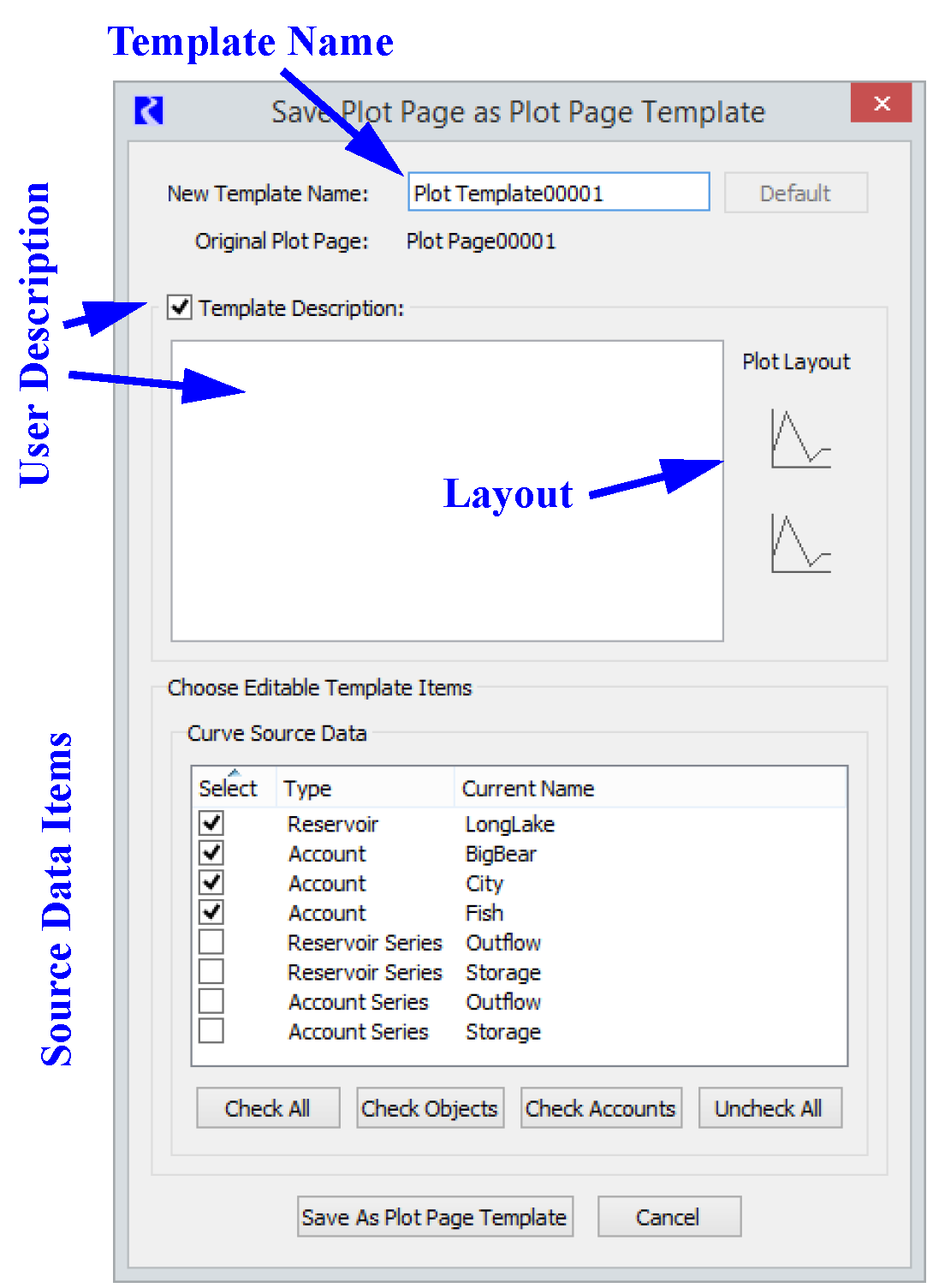
In the Save Plot Page as Plot Page Template dialog, the user specifies the Name of the new template, and any Descriptive text about the plots in the template. This description can optionally be hidden by selecting the checkbox next to the Template Description. You should enter enough text in here to describe the items in the template. The graph layout is shown to help describe the template. Tooltips (mouse-hover) on the graph icon show the Title for each graph.
The bottom part of the dialog, Choose Editable Template Items is where you specify which items in the plot you want to make editable in the template. Select the checkbox of each desired item. Options include the following:
• Objects
• Accounts
• Slots
• Supplies
Because certain slots (like Hydrologic Inflow) are only available for certain objects, (Reservoirs). The slots are broken into further types such as “Reservoir Series” or “Account Series”. Also, because certain objects only have certain slots, substitution is limited to like objects. Thus, in the same screenshot, Long Lake is classified as a “Reservoir”.
In Figure 2.29, we select the first two items in the list: Long Lake Reservoir and Big Bear Account.
Figure 2.29
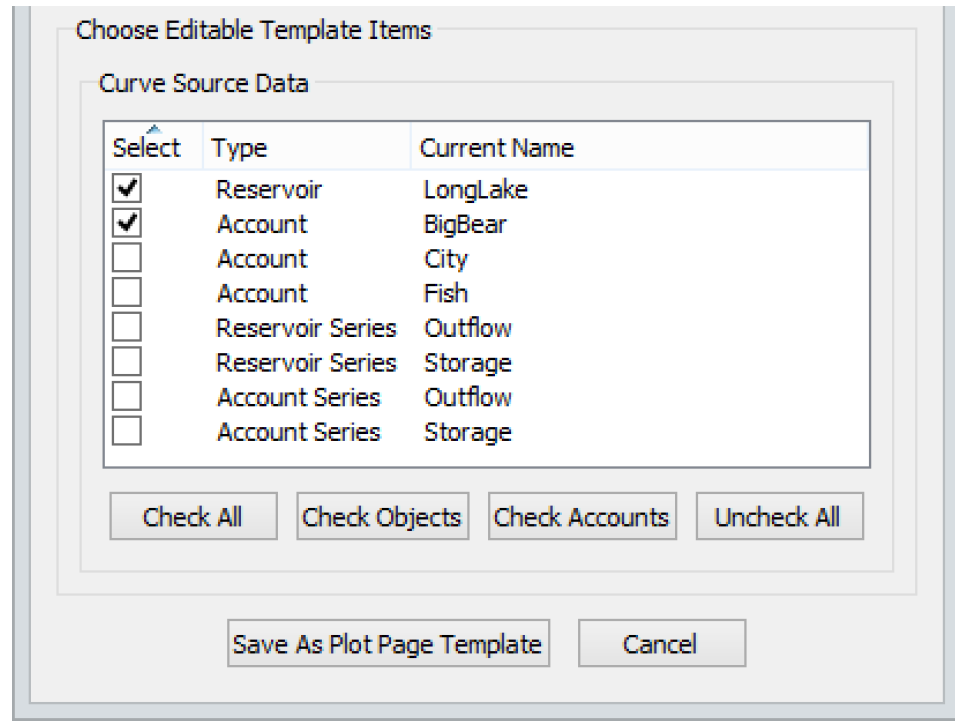
Buttons at the bottom of the frame allow you to Check All, Check Objects, Check Accounts, Uncheck All.
When finished, select Save As Plot Page Template. The dialog closes and the Output Manager opens with the newly created Plot Page Template selected.
If the Save As Plot Page Template is inactive, the tooltip describes the reason.
Apply the Template
Once the Template has been created, it is stored in the Output Manager. From the Output Manager, highlight the template item and select Generate or Edit (or double-click the item). The Plot Page Template dialog opens. It shows the Template’s Name, Description, Titles, and Curve Source Data as described in the following sections.
Figure 2.30
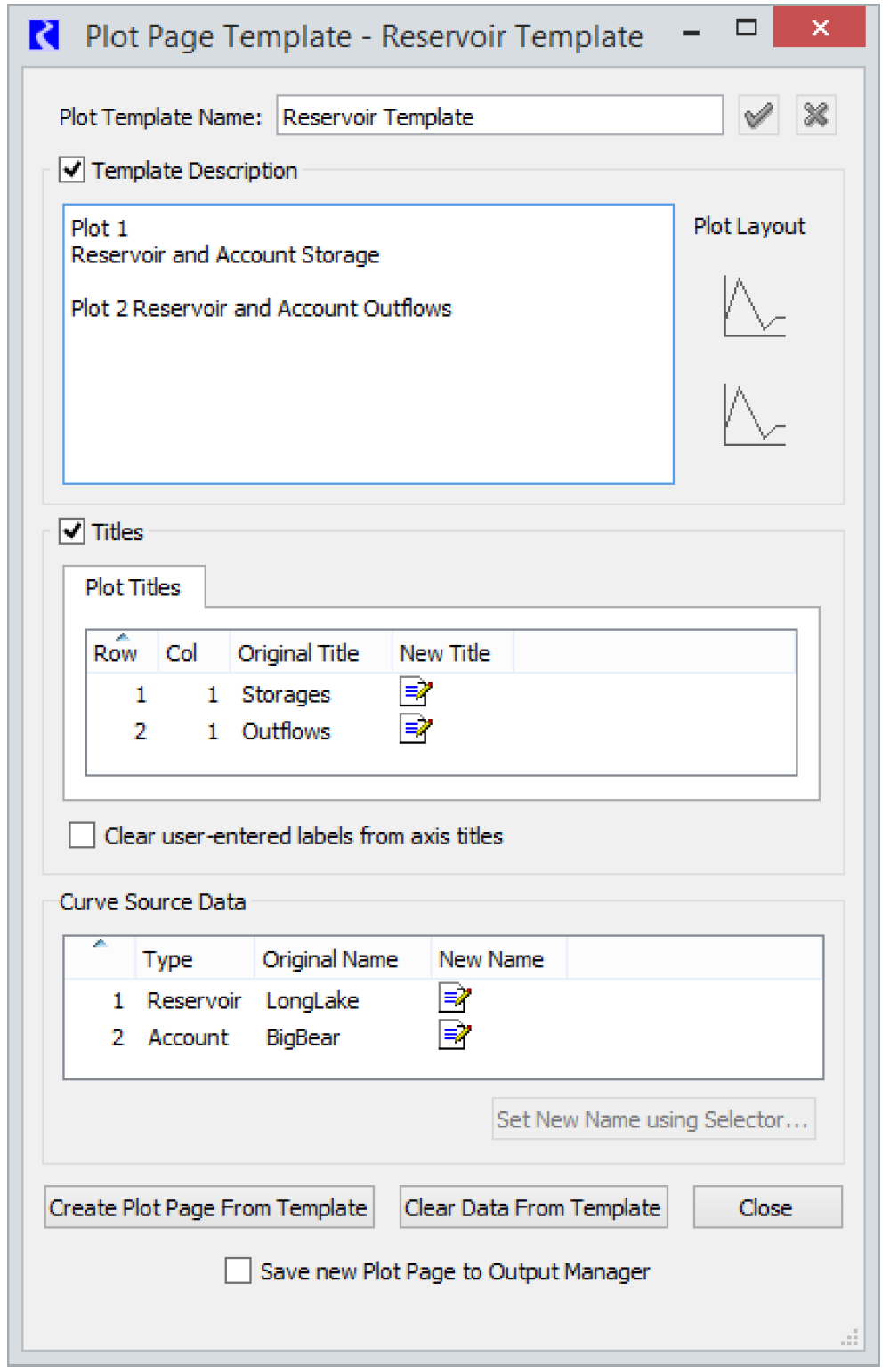
Plot Template Name
The Plot Template Name is shown. If you would like to change the name of the template, enter a new name and select the green check to confirm.
Template Description
This shows the description entered when the template was created. This description is not editable. The region also shows the layout for informational purposes. Tooltips (mouse-hover) on the graph icon show the original Title for each plot.
Titles
The titles for the original plots are shown. You can hide the whole region by clearing the Titles checkbox.
Edit titles as necessary by selecting the New Title cell and entering new text.
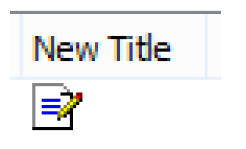
To clear any user-entered labels from the axes titles in new plots, check the Clear user-entered labels from axis titles box. If you want to keep user-entered labels for the axes, leave the box unchecked. Any unit labels for the axes will be recomputed based on the units for the newly plotted slots.
Curve Source Data
The Curve Source Data region is where you substitute new items for the originals. You can do this in either of the following ways.
• Select the New Name field and enter new text.
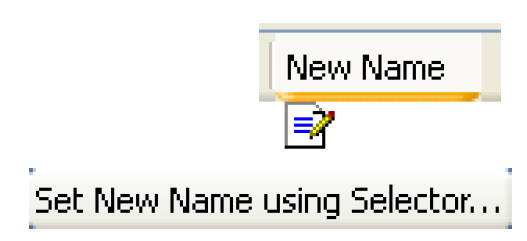
• Select a row and then select Set New Name using Selector This opens the Selector dialog preset to the appropriate type. For example, if you are substituting for a Reservoir, the selector will only allow you to select from Reservoirs.
Buttons
The buttons at the bottom of the window allow you to create the plot, clear the data (New Titles and New Names) from the template or close the dialog.
A final checkbox at the bottom, when checked, will open a Save As dialog allowing you to immediately save the generated plot to the Output Manager.
When you Create Plot Page From Template a Plot Page is created with the new data substituted for the old, see Figure 2.31. If you left any New Name fields blank, the Template’s original values will be used. Also, if your Template does not apply to certain data in the Plot Page, it will just be plotted as it was originally
Figure 2.31
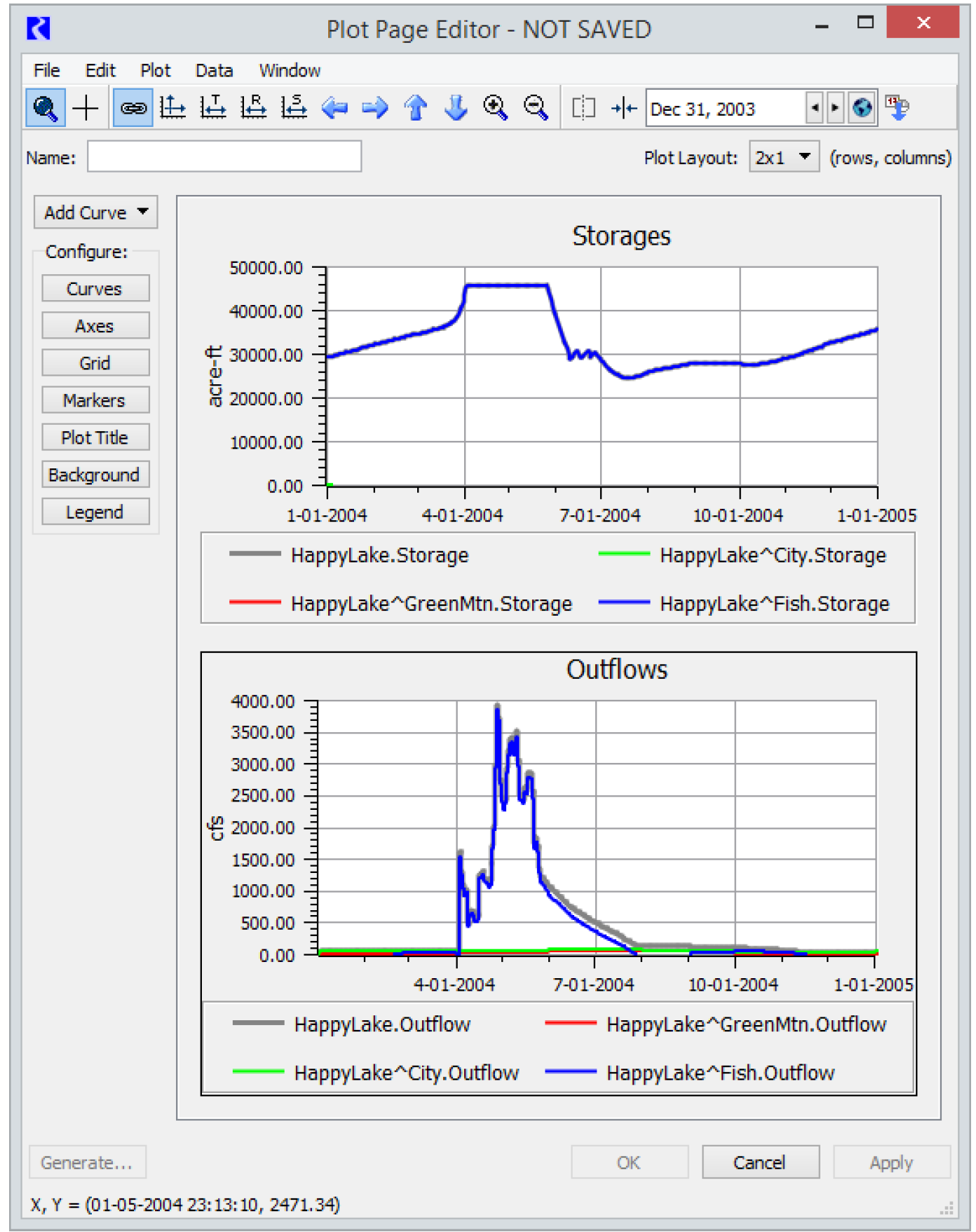
The Template remains open and has not changed. You can then specify new source data for the Template, Clear Data from Template or close the dialog.
In the generated Plot Page, if the source data does not exist, the Plot Page will be created with a placeholder. For example, in Figure 2.31, the Storages plot has no HappyLake^GreenMtnStorage, so there is a legend item, but no data is plotted. You can pick new slots for such curves or delete them using the menu shown by right-clicking the curve in the legend.
If no data can be plotted at all (for example you specified an object that does not exist on the workspace), the plot may be completely blank with no axis.
Also, the plots are zoomed as they were in the original plot, you may need to select Auto Scale 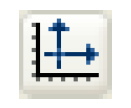 to see the new curves.
to see the new curves.
 to see the new curves.
to see the new curves. The newly created Plot Page is a normal Plot Page that you can edit and/or save to the Output Manager as desired. It can also be saved as a Plot Template, possibly replacing the original template from which it was generated.
Creating Similar Plot Pages
The Create Similar Plot Pages utility allows creation of Plot Pages similar to the existing Plot Page when you only want to replace objects, accounts, slots, or supplies that are the source of data for curves on the Plot Page. This approach is similar to Plot Templates, but Plot Templates allow you to replace multiple entities, like both objects and slots, for example. A Template only creates one Plot Page at a time. However, creating similar plot pages is more direct; you do not have to create an intermediate Template. Also, creating similar Plot Pages applies to multiple items (like four reservoir objects) at one time, allowing you to create multiple new Plot Pages in one action. See “Plot Page” for details.
Accessing the Similar Plot Pages Utility
To create a similar Plot Page, from the Plot Page Editor, select File, then Create Similar Plot Pages. Then, select the desired item type you wish to change:
• For Different Objects
• For Different Accounts (when accounting is enabled)
• For Different Slots
• For Different Supplies (when accounting is enabled)
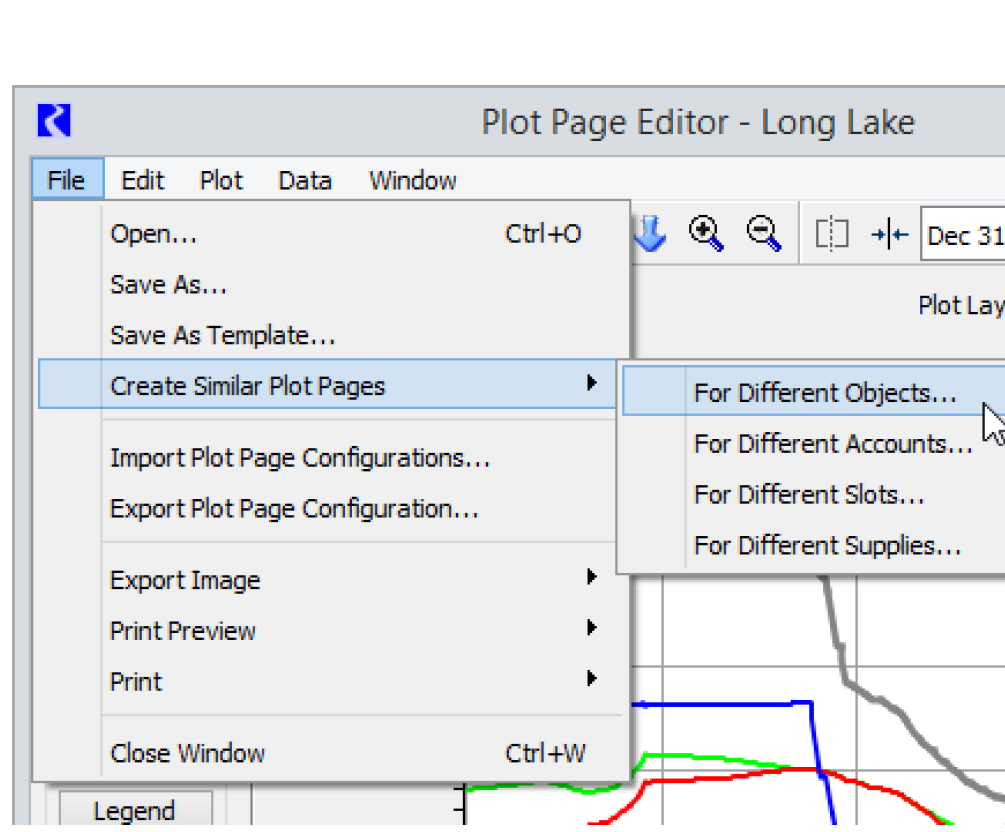
Create Similar Plot Pages Tour
The Create Similar Plot Pages dialog is modified based on the type of item that will be substituted, so the screenshots may not match for other items. The Create Similar Plot Pages dialog is used by selecting and configuring items in each of four areas from top to bottom. These four areas are described in the following sections.
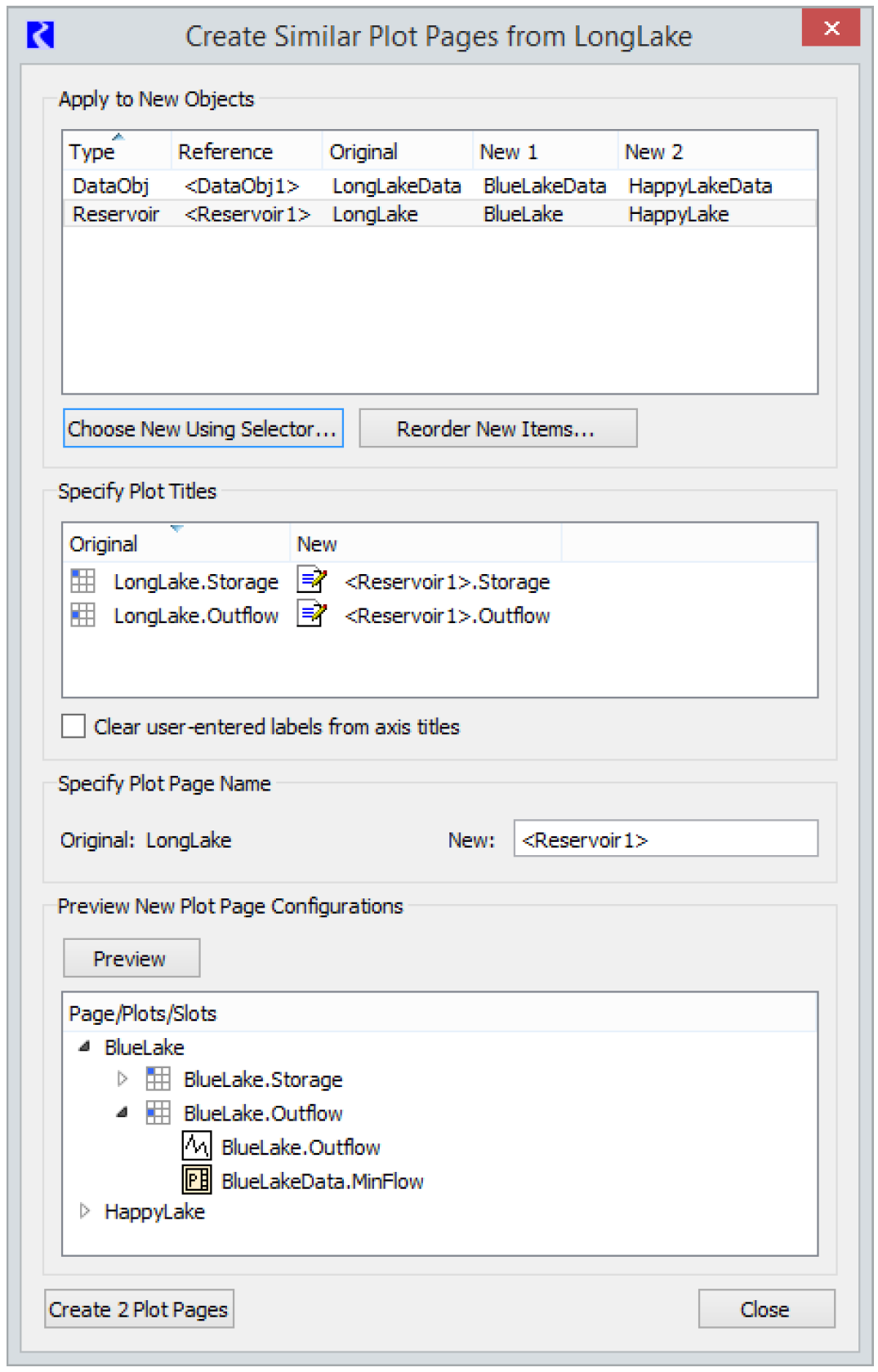
Apply to New Objects/Accounts/Slots/Supplies
Use the Apply to New Objects/Accounts/Slots/Supplies area to specify the different items you wish to use. For example, if you wish to create similar Plot Pages for different objects, use the Apply New Objects area to select those new objects. Replacement items are chosen by selecting Choose New Using Selector. Multiple items can be selected, in which case there will be multiple New columns populated with the items. A new Plot Page will be created for each New column, thus you can create multiple plot pages at once.
If there is more than one row in the objects list, the same number of new items should be selected for each row; there is a one to one matching of items across rows for a new Plot Page. Alternatively, one new item can be selected for a row, in which case that same new item will used in all Plot Pages if the other rows do have multiple new items.
By default, multiple items are listed in alphabetical order. If the new objects do not match properly across the rows for the desired Plot Pages, the items can be reordered for a row by selecting Reorder New Items. This brings up a dialog with a list of the items, which can be reordered by selecting an item and selecting Up and Down arrows to move them as desired.
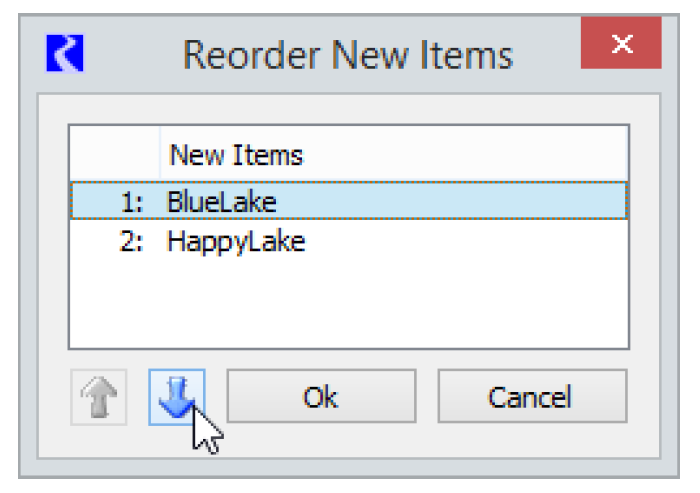
Specify Plot Titles
The Specify Plot Titles portion of the Create Similar Plot Pages dialog shows the original titles for the different plots in the original Plot Page and how corresponding new titles for new plots look when the original object names are represented as entities using the object reference names. For example, when substituting reservoir objects, the entity might be <Reservoir1>. Entities are of the following types:
• <ObjectType#>
• <Account#>
• <Supply#>
• <ObjectType Series#>
• <Account Series#>
Object reference name entities will be replaced with the appropriate new object name when a new Plot Page is created. The new title representation can be selected and edited as desired by the user. Even if not shown, you can type in the entity from above to use it in new plot titles. To determine which reference name entities you can use, look at the Reference column in the top panel.
If there are user-entered labels for plot axes in the original plot page, they can be cleared for newly generated plots by checking the Clear user-entered labels from axis titles box. If the box is unchecked, any user-entered titles for axes will be carried over to the new plots.
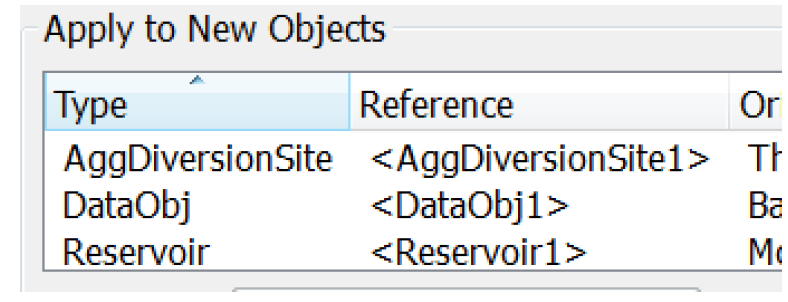
Specify Plot Page Name
Similar to plot titles, the Specify Plot Page Name portion of the dialog shows a new name with original object names replaced with object reference entities. These entities will be replaced with the corresponding new object name when new Plot Pages are created. The new name representation can be edited by the user. See above for more information on entities.
Note: If the resulting new name for a Plot Page is not unique in the Output Manager, an index number is added to the end and incremented until the name is unique.
Preview
The Preview New Plot Page Configurations section of the dialog allows you to preview in a tree-view the Plot Pages that will be generated based on the information entered into the dialog. This listing includes the save name for each Plot Page, the plot title for each plot on the page, and the slots that will be placed onto each plot. This gives the user the opportunity to review basic information about the Plot Pages that will be created before actually generating them.
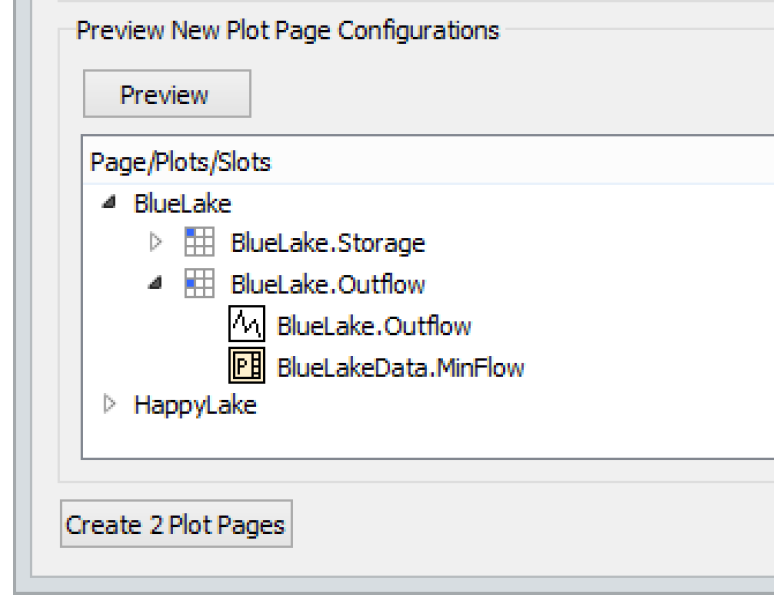
Create N Plot Pages
The Create N Plot Pages button creates the new plot pages based on the information entered into the dialog and gives you feedback about how many plot pages were created. From the informational dialog, you can select to either Create more plot pages to go back to the Create Similar Plot Pages dialog or View in Output Manager to go to the Output Manager with the new plot pages selected (Select Generate to view the plot pages.). In either case, the new Plot Pages appear in the Output Manager and are available for viewing or editing just like any other Plot Page.
Printing and Exporting Plots
You can print or export plots to image files from both the Plot Page dialog and the Plot Page Editor in the same manner. You can print or export either individual plots or entire Plot Pages.
Print Preview
To preview a plot from either the Plot Page dialog or the Plot Page Editor, select File, then Print Preview, then All Plots. (or Selected Plots). This will preview a plot as it would appear using the specified printer. Selecting All Plots will show all plots on the Plot Page. Selecting Selected Plots will only show the single selected plot. You can change the printer by selecting File, then Print Preview, then Choose Printer. The print preview shows a preview of the plot, as shown in Figure 2.32.
Figure 2.32
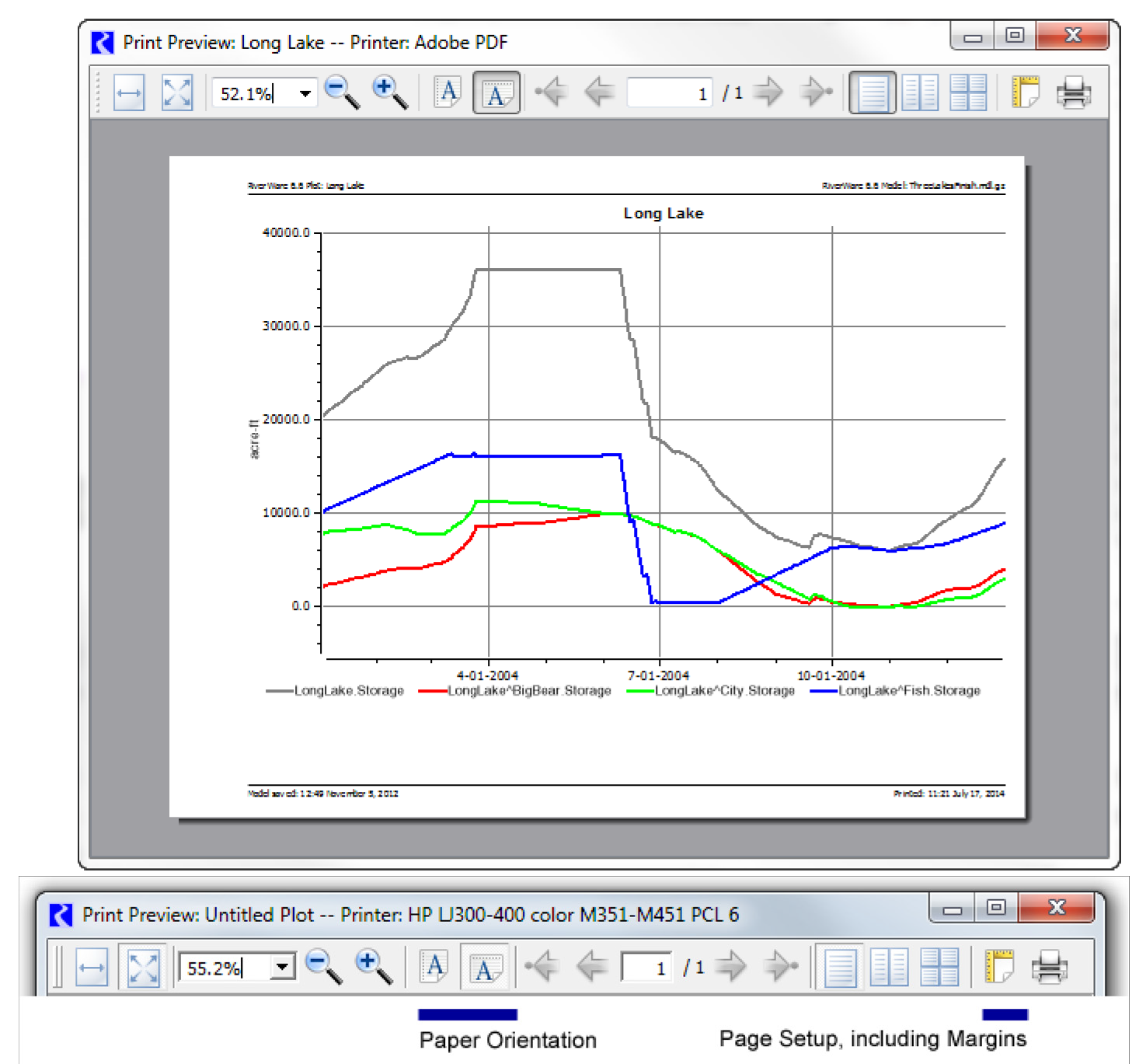
The following printer settings can be made within the Print Preview dialog.
• Paper Orientation (Portrait or landscape)
• Margins
This is the only place where print margins can be configured. The margin settings made in the Page Setup dialog will persist—including to subsequent RiverWare sessions—and apply to all printer use within RiverWare.
Note: The relative curve line thicknesses shown in the plot preview image may not exactly match that of the actual printed page.
Note: Printing from the Plot Print Preview dialog using its Print button does not apply the curve line thicknesses for printed output. When printing from the Plot Print Preview dialog, curves and markers will generally be too thin to clearly see. Select File, then Print, then All/Selected Plots to use the thickness adjustment. See “Plot Page Settings” for details.
Figure 2.33
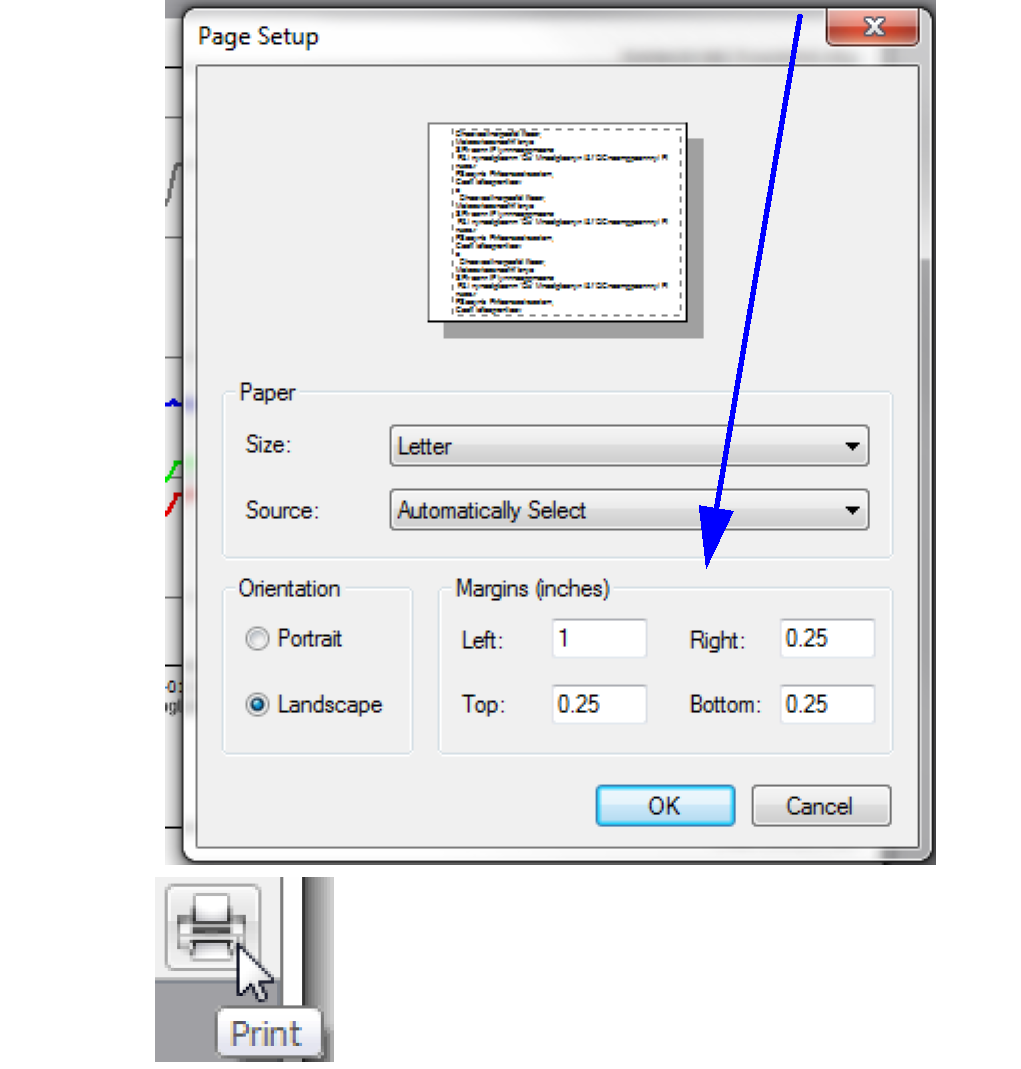
Printing
Plots can be printed from the Plot Page dialog or the Plot Page Editor in the same manner. To print a single plot, either right-select the desired plot and select Print from the context menu, or select File, then Print, then Selected Plot. To print all plots select File, then Print, then All Plots. The Printer dialog lets you select the desired printer and host. It also offers such basic page layout configuration capabilities as color/grayscale prints, paper format and size, and the printing range.
Note: The widths of lines printed is based on the specified width and the Print Line Width Factor. See “Plot Page Settings” for details.
Also, you can define the headers and footers to be used on the printed plots. Select File, then Print, then Printed Header/Footer Configuration. In this dialog, you can specify the items to show for the Left and Right Headers and Footers. Choose from the available items or specify Custom and enter your own text.
Select Defaults to save the current settings as User Default (saved with your user settings). Apply your custom defaults or the standard defaults as desired to other plots. The header and footer configuration are saved with the Plot Page and thus can only be modified from the Plot Page Editor.
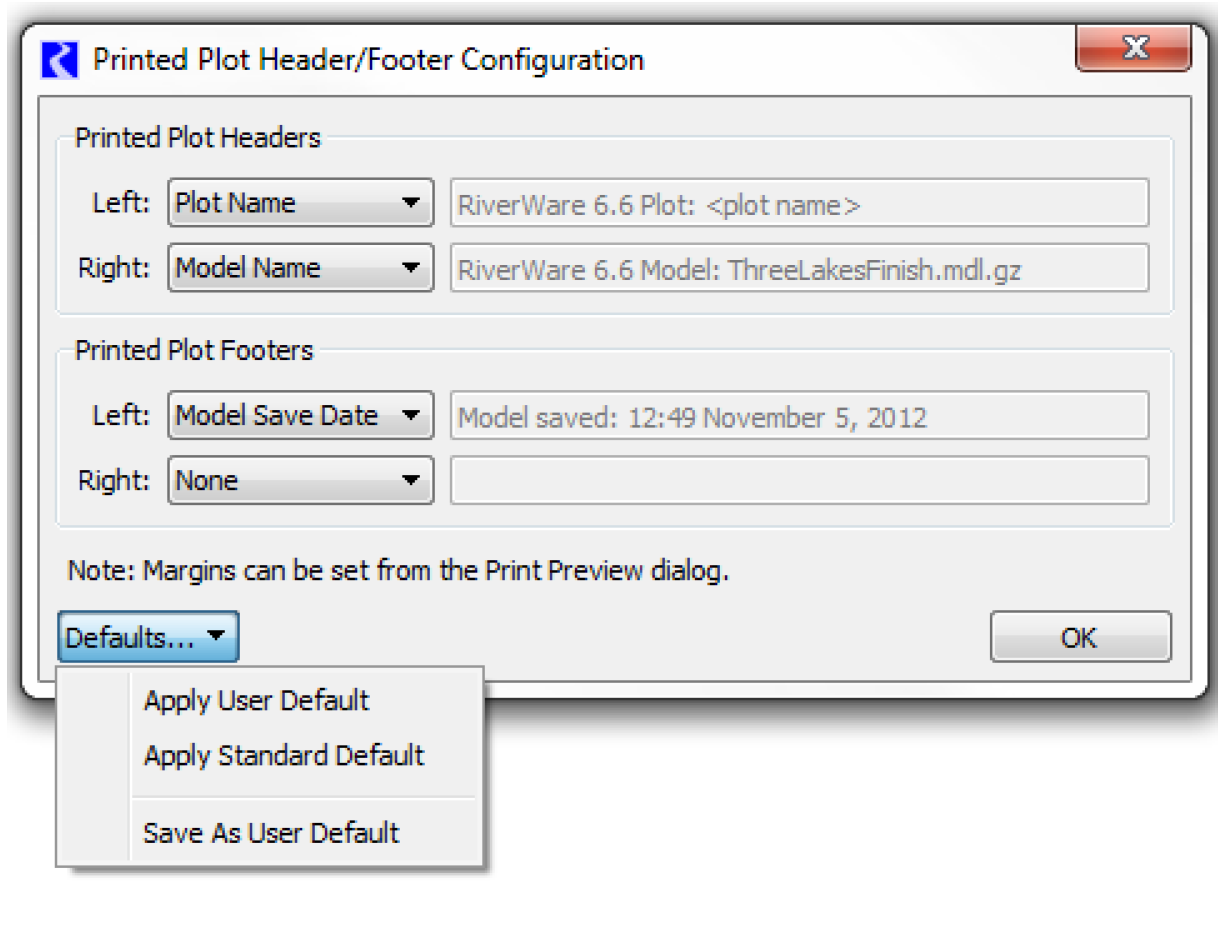
Copy Plot as an Image
Select Edit, then Copy Plot Image, then All/Selected Plots to copy all or selected plots as an image to the system clipboard. Then you can paste the image into a document or email. The size of the copied plot is taken directly from the size of the dialog on the screen in terms of pixels.
Exporting
To export a single plot, either right-select the desired plot and select Export Image from the context menu, or select File, then Export Image, then Selected Plot. To export all plots on the Plot Page, select File, then Export Image, then All Plots The resulting dialog allows you select the export image file extension, size, resolution, and destination. The available file type extensions are: *.bmp, *.jpeg, *.pbm, *.pgm, *.png, *.ppm, *.xbm or *.xpm.
Note: The image resolution affects only file formats that use compression. In general, you should use the highest resolution. Also, the Export Image dialog does not automatically append the file extension. When you type the target file name, you must assign the appropriate extension.
Revised: 11/11/2019